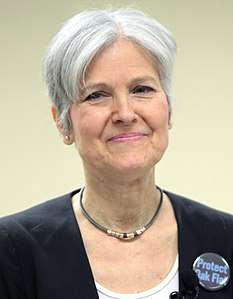United States presidential election, 2016
|
| |||||||||||||||||||||||||||||
| |||||||||||||||||||||||||||||
538 members of the Electoral College 270 electoral votes needed to win | |||||||||||||||||||||||||||||
|---|---|---|---|---|---|---|---|---|---|---|---|---|---|---|---|---|---|---|---|---|---|---|---|---|---|---|---|---|---|
| Turnout |
55.7%[1] | ||||||||||||||||||||||||||||
| |||||||||||||||||||||||||||||
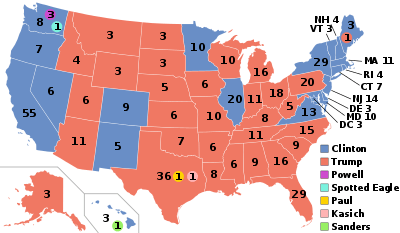  Presidential election results map. Red denotes states won by Trump/Pence, blue denotes those won by Clinton/Kaine. Numbers indicate electoral votes allotted to the winner of each state.
Faithless votes: Colin Powell 3 (WA), John Kasich 1 (TX), Ron Paul 1 (TX), Bernie Sanders 1 (HI), Faith Spotted Eagle 1 (WA) | |||||||||||||||||||||||||||||
| |||||||||||||||||||||||||||||
2016 U.S. presidential election |
|---|
| Republican Party |
| Democratic Party |
| Third parties |
| Related races |
The United States presidential election of 2016 was the 58th quadrennial American presidential election, held on Tuesday, November 8, 2016. In a surprise victory, the Republican ticket of businessman Donald Trump and Indiana Governor Mike Pence defeated the Democratic ticket of former Secretary of State Hillary Clinton and U.S. Senator from Virginia Tim Kaine.[2] Trump took office as the 45th President, and Pence as the 48th Vice President, on January 20, 2017. Incumbent Democratic President Barack Obama was ineligible to serve a third term due to the term limits established by the 22nd Amendment. Concurrent with the presidential election, Senate, House, and many gubernatorial and state and local elections were also held on November 8.
Clinton secured the Democratic nomination after fending off a strong primary challenge from Senator Bernie Sanders. Amidst a wide Republican field, Trump emerged as the front-runner, defeating Ted Cruz, Marco Rubio, John Kasich, Jeb Bush and other candidates. Clinton ran on a platform of continuing and expanding President Obama's policies, emphasizing issues of racial, LGBT, and women's rights, and "inclusive capitalism";[3] whereas Trump promised to "Make America Great Again" by implementing a populist and nationalist agenda, opposing political correctness, illegal immigration, and many free-trade agreements.[4] The tone of the general election campaign was widely characterized as divisive and negative,[5][6][7] with both candidates beleaguered by controversy. Trump made numerous controversial remarks about race and immigration, was accused of inciting violence against protestors at his rallies,[8][9][10] and faced multiple allegations of sexual misconduct (which he denied), but was also able to garner extensive free media coverage.[11][12] Clinton, whose public approval ratings had declined sharply since the end of her tenure as Secretary of State,[13] was dogged by an FBI investigation of her improper use of a private email server, while her assertion that "half" of Trump's supporters were bigoted "deplorables" met with polarized reactions. Clinton held the lead in nearly every pre-election nationwide poll and in most swing state polls.
Voters selected members of the Electoral College in each state, in most cases by "winner-takes-all" plurality; those state electors in turn voted for a new president and vice president on December 19, 2016.[lower-alpha 1] While Clinton received over 2.8 million more votes nationwide, a margin of 2.1%, Trump won 30 states with a total of 306 electors, or 57% of the 538 available. He won two perennial swing states which typically decide an election, in Florida and Ohio. Trump also won three "blue wall" stronghold states that had not gone Republican since the 1980s: Michigan, Pennsylvania, and Wisconsin. He also won Maine's 2nd congressional district, which had also not been won by a Republican presidential candidate since 1988. Leading up to the election, a Trump victory was considered unlikely by almost all media forecasts. After his victory was assured, some commentators compared the election to President Harry S. Truman's victorious campaign in 1948 as one of the greatest political upsets in modern American history.[14][15]
In the Electoral College vote on December 19, seven electors voted against their pledged candidates: two against Trump and five against Clinton. A further three electors attempted to vote against Clinton but were replaced or forced to vote again. Ultimately, Trump received 304 electoral votes and Clinton garnered 227, while Colin Powell won three, and John Kasich, Ron Paul, Bernie Sanders, and Faith Spotted Eagle each received one. Trump is the fifth person in U.S. history to become president while losing the nationwide popular vote.[lower-alpha 2] He is the first president without any prior experience in public service or the military, as well as the wealthiest and the oldest at inauguration, while Clinton was the first woman to be the presidential nominee of a major American party and the first woman to win the popular vote. Clinton's popular vote win was also the largest ever margin by a candidate who lost the electoral college.[17]
On January 6, 2017, the United States government's intelligence agencies concluded that the Russian government had interfered in the 2016 United States elections.[18][19][20] A joint U.S. intelligence community review stated with high confidence that "Russian President Vladimir Putin ordered an influence campaign in 2016 aimed at the U.S. presidential election" and that "Russia's goals were to undermine public faith in the U.S. democratic process, denigrate Secretary Clinton, and harm her electability and potential presidency."[21] President Trump repeatedly criticized these intelligence claims, citing a lack of evidence and calling the issue a "hoax" and "fake news".[22][23][24] Investigations regarding potential collusion between the Trump campaign and Russian officials were started by the Federal Bureau of Investigation,[25] the Senate Intelligence Committee,[26] and the House Intelligence Committee.[27] Former FBI Director Robert Mueller was appointed as special counsel in May 2017 by Acting Attorney General Rod Rosenstein to oversee the ongoing investigation into "any links and/or coordination" between the Trump campaign and the Russian government in its election interference and any related illegal acts.[28]
Background
.jpg)
Article Two of the United States Constitution provides that the President and Vice President of the United States must be natural-born citizens of the United States, at least 35 years old, and residents of the United States for a period of at least 14 years. Candidates for the presidency typically seek the nomination of one of the political parties, in which case each party devises a method (such as a primary election) to choose the candidate the party deems best suited to run for the position. Traditionally, the primary elections are indirect elections where voters cast ballots for a slate of party delegates pledged to a particular candidate. The party's delegates then officially nominate a candidate to run on the party's behalf. The general election in November is also an indirect election, where voters cast ballots for a slate of members of the Electoral College; these electors in turn directly elect the President and Vice President.
President Barack Obama, a Democrat and former U.S. Senator from Illinois, was ineligible to seek reelection to a third term due to the restrictions of the Twenty-second Amendment; in accordance with Section 1 of the Twentieth Amendment, his term expired at noon on January 20, 2017.
Primary process
The series of presidential primary elections and caucuses took place between February and June 2016, staggered among the 50 states, the District of Columbia and U.S. territories. This nominating process was also an indirect election, where voters cast ballots for a slate of delegates to a political party's nominating convention, who in turn elected their party's presidential nominee.
Speculation about the 2016 campaign began almost immediately following the 2012 campaign, with New York magazine declaring the race had begun in an article published on November 8, two days after the 2012 election.[29] On the same day, Politico released an article predicting the 2016 general election would be between Clinton and former Florida Governor Jeb Bush, while a New York Times article named New Jersey Governor Chris Christie and Senator Cory Booker from New Jersey as potential candidates.[30][31]
Nominations
Republican Party
| ||
|---|---|---|
|
Incumbent Controversies involving Russia Business and personal  |
||
Primaries
With seventeen major candidates entering the race, starting with Ted Cruz on March 23, 2015, this was the largest presidential primary field for any political party in American history.[32]
Prior to the Iowa caucuses on February 1, 2016, Perry, Walker, Jindal, Graham, and Pataki withdrew due to low polling numbers. Despite leading many polls in Iowa, Trump came in second to Cruz, after which Huckabee, Paul and Santorum withdrew due to poor performances at the ballot box. Following a sizable victory for Trump in the New Hampshire primary, Christie, Fiorina and Gilmore abandoned the race. Bush followed suit after scoring fourth place to Trump, Rubio and Cruz in South Carolina. On March 1, 2016, the first of four "Super Tuesday" primaries, Rubio won his first contest in Minnesota, Cruz won Alaska, Oklahoma and his home of Texas and Trump won the other seven states that voted. Failing to gain traction, Carson suspended his campaign a few days later.[33] On March 15, 2016, the second "Super Tuesday", Kasich won his only contest in his home state of Ohio and Trump won five primaries including Florida. Rubio suspended his campaign after losing his home state.[34]
Between March 16 and May 3, 2016, only three candidates remained in the race: Trump, Cruz and Kasich. Cruz won the most delegates in four Western contests and in Wisconsin, keeping a credible path to denying Trump the nomination on first ballot with 1,237 delegates. Trump then augmented his lead by scoring landslide victories in New York and five Northeastern states in April, followed by a decisive victory in Indiana on May 3, 2016, securing all 57 of the state's delegates. Without any further chances of forcing a contested convention, both Cruz[35] and Kasich[36] suspended their campaigns. Trump remained the only active candidate and was declared the presumptive Republican nominee by Republican National Committee chairman Reince Priebus on the evening of May 3, 2016.[37]
Nominees
| Republican Party ticket, 2016 | |||||||||||||||||||||||||||
| Donald Trump | Mike Pence | ||||||||||||||||||||||||||
|---|---|---|---|---|---|---|---|---|---|---|---|---|---|---|---|---|---|---|---|---|---|---|---|---|---|---|---|
| for President | for Vice President | ||||||||||||||||||||||||||
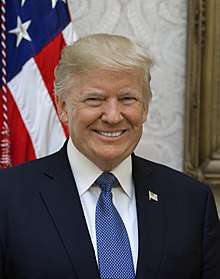 |
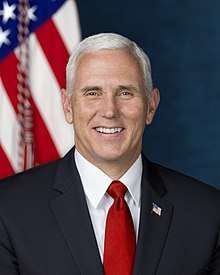 | ||||||||||||||||||||||||||
| Chairman of The Trump Organization (1971–2017) |
50th Governor of Indiana (2013–2017) | ||||||||||||||||||||||||||
| Campaign | |||||||||||||||||||||||||||
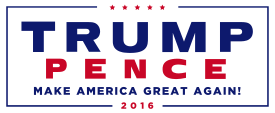 | |||||||||||||||||||||||||||
| [38][39][40] | |||||||||||||||||||||||||||
Other major candidates
Major candidates were determined by the various media based on common consensus. The following were invited to sanctioned televised debates based on their poll ratings.
Trump received 14,010,177 total votes in the primary. Trump, Cruz, Rubio and Kasich each won at least one primary, with Trump receiving the highest number of votes and Ted Cruz receiving the second highest.
| Candidates in this section are sorted by reverse date of withdrawal from the primaries | |||||||
| John Kasich | Ted Cruz | Marco Rubio | Ben Carson | Jeb Bush | Jim Gilmore | Carly Fiorina | Chris Christie |
|---|---|---|---|---|---|---|---|
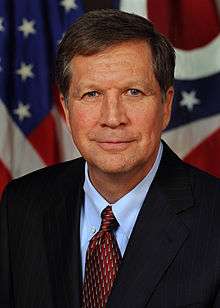 |
.jpg) |
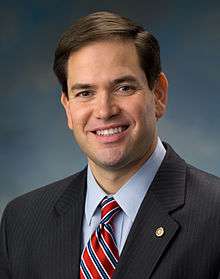 |
 |
 |
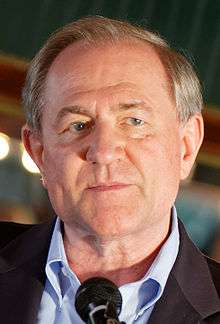 |
 |
.jpg) |
| 69th Governor of Ohio (2011–present) |
U.S. Senator from Texas (2013–present) |
U.S. Senator from Florida (2011–present) |
Dir. of Pediatric Neurosurgery, Johns Hopkins Hospital (1984–2013) |
43rd Governor of Florida (1999–2007) |
68th Governor of Virginia (1998–2002) |
CEO of Hewlett-Packard (1999–2005) |
55th Governor of New Jersey (2010–2018) |
| Campaign | Campaign | Campaign | Campaign | Campaign | Campaign | Campaign | Campaign |
| W: May 4 4,287,479 votes |
W: May 3 7,811,110 votes |
W: Mar 15 3,514,124 votes |
W: Mar 4 857,009 votes |
W: Feb 20 286,634 votes |
W: Feb 12 18,364 votes |
W: Feb 10 40,577 votes |
W: Feb 10 57,634 votes |
| [41] | [42][43][44] | [45][46][47] | [48][49][50] | [51][52] | [53][54] | [55][56] | [57][58] |
| Rand Paul | Rick Santorum | Mike Huckabee | George Pataki | Lindsey Graham | Bobby Jindal | Scott Walker | Rick Perry |
.jpg) |
.jpg) |
.jpg) |
.jpg) |
.jpg) |
 |
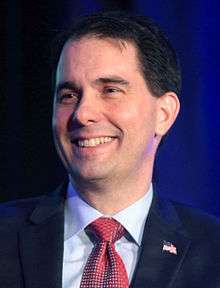 |
 |
| U.S. Senator from Kentucky (2011–present) |
U.S. Senator from Pennsylvania (1995–2007) |
44th Governor of Arkansas (1996–2007) |
53rd Governor of New York (1995–2006) |
U.S. Senator from South Carolina (2003–present) |
55th Governor of Louisiana (2008–2016) |
45th Governor of Wisconsin (2011–present) |
47th Governor of Texas (2000–2015) |
| Campaign | Campaign | Campaign | Campaign | Campaign | Campaign | Campaign | Campaign |
| W: Feb 3 66,781 votes |
W: Feb 3 16,622 votes |
W: Feb 1 51,436 votes |
W: December 29, 2015 2,036 votes |
W: December 21, 2015 5,666 votes |
W: November 17, 2015 222 votes |
W: September 21, 2015 1 write-in vote in New Hampshire |
W: September 11, 2015 1 write-in vote in New Hampshire |
| [59][60][61] | [62][63] | [64][65] | [66] | [67][68] | [69][70] | [71][72][73] | [73][74][75] |
Vice presidential selection
Trump turned his attention towards selecting a running mate after he became the presumptive nominee on May 4, 2016.[76] In mid-June, Eli Stokols and Burgess Everett of Politico reported that the Trump campaign was considering New Jersey Governor Chris Christie, former Speaker of the House Newt Gingrich from Georgia, Senator Jeff Sessions of Alabama, and Oklahoma Governor Mary Fallin.[77] A June 30 report from The Washington Post also included Senators Bob Corker from Tennessee, Richard Burr from North Carolina, Tom Cotton from Arkansas, Joni Ernst from Iowa, and Indiana Governor Mike Pence as individuals still being considered for the ticket.[78] Trump also stated that he was considering two military generals for the position, including retired Lieutenant General Michael Flynn.[79]
In July 2016, it was reported that Trump had narrowed his list of possible running mates down to three: Christie, Gingrich, and Pence.[80]
On July 14, 2016, several major media outlets reported that Trump had selected Pence as his running mate. Trump confirmed these reports in a message on Twitter on July 15, 2016, and formally made the announcement the following day in New York.[81][82] On July 19, the second night of the 2016 Republican National Convention, Pence won the Republican vice presidential nomination by acclamation.[83]
Democratic Party
| ||
|---|---|---|
|
U.S. Secretary of State
U.S. Senator from New York First Lady of the United States
|
||
Primaries
Former Secretary of State Hillary Clinton, who also served in the U.S. Senate and was the First Lady of the United States, became the first Democrat in the field to formally launch a major candidacy for the presidency with an announcement on April 12, 2015, via a video message.[84] While nationwide opinion polls in 2015 indicated that Clinton was the front-runner for the 2016 Democratic presidential nomination, she faced strong challenges from Independent Senator Bernie Sanders of Vermont,[85] who became the second major candidate when he formally announced on April 30, 2015, that he was running for the Democratic nomination.[86] September 2015 polling numbers indicated a narrowing gap between Clinton and Sanders.[85][87][88] On May 30, 2015, former Governor of Maryland Martin O'Malley was the third major candidate to enter the Democratic primary race,[89] followed by former Independent Governor and Republican Senator of Rhode Island Lincoln Chafee on June 3, 2015,[90][91] former Virginia Senator Jim Webb on July 2, 2015,[92] and former Harvard law professor Lawrence Lessig on September 6, 2015.[93]
On October 20, 2015, Webb announced his withdrawal from the Democratic primaries, and explored a potential Independent run.[94] The next day Vice-President Joe Biden decided not to run, ending months of speculation, stating, "While I will not be a candidate, I will not be silent."[95][96] On October 23, Chafee withdrew, stating that he hoped for "an end to the endless wars and the beginning of a new era for the United States and humanity".[97] On November 2, after failing to qualify for the second DNC-sanctioned debate after adoption of a rule change negated polls which before might have necessitated his inclusion in the debate, Lessig withdrew as well, narrowing the field to Clinton, O'Malley, and Sanders.[98]
On February 1, 2016, in an extremely close contest, Clinton won the Iowa caucuses by a margin of 0.2 points over Sanders. After winning no delegates in Iowa, O'Malley withdrew from the presidential race that day. On February 9, Sanders bounced back to win the New Hampshire primary with 60% of the vote. In the remaining two February contests, Clinton won the Nevada caucuses with 53% of the vote and scored a decisive victory in the South Carolina primary with 73% of the vote.[99][100] On March 1, 11 states participated in the first of four "Super Tuesday" primaries. Clinton won Alabama, Arkansas, Georgia, Massachusetts, Tennessee, Texas, and Virginia and 504 pledged delegates, while Sanders won Colorado, Minnesota, Oklahoma and his home state of Vermont and 340 delegates. The following weekend, Sanders won victories in Kansas, Nebraska and Maine with 15–30-point margins, while Clinton won the Louisiana primary with 71% of the vote. On March 8, despite never having a lead in the Michigan primary, Sanders won by a small margin of 1.5 points and outperforming polls by over 19 points, while Clinton won 83% of the vote in Mississippi.[101] On March 15, the second "Super Tuesday", Clinton won in Florida, Illinois, Missouri, North Carolina and Ohio. Between March 22 and April 9, Sanders won six caucuses in Idaho, Utah, Alaska, Hawaii, Washington and Wyoming, as well as the Wisconsin primary, while Clinton won the Arizona primary. On April 19, Clinton won the New York primary with 58% of the vote. On April 26, in the third "Super Tuesday" dubbed the "Acela primary", she won contests in Connecticut, Delaware, Maryland and Pennsylvania, while Sanders won in Rhode Island. Over the course of May, Sanders accomplished another surprise win in the Indiana primary[102] and also won in West Virginia and Oregon, while Clinton won the Guam caucus and Kentucky primary.
On June 4 and 5, Clinton won two victories in the Virgin Islands caucus and Puerto Rico primary. On June 6, 2016, the Associated Press and NBC News reported that Clinton had become the presumptive nominee after reaching the required number of delegates, including pledged delegates and superdelegates, to secure the nomination, becoming the first woman to ever clinch the presidential nomination of a major United States political party.[103] On June 7, Clinton secured a majority of pledged delegates after winning primaries in California, New Jersey, New Mexico and South Dakota, while Sanders only won in Montana and North Dakota. Clinton also won the final primary in the District of Columbia on June 14. At the conclusion of the primary process, Clinton had won 2,204 pledged delegates (54% of the total) awarded by the primary elections and caucuses, while Sanders had won 1,847 (46%). Out of the 714 unpledged delegates or "superdelegates" who were set to vote in the convention in July, Clinton received endorsements from 560 (78%), while Sanders received 47 (7%).[104]
Although Sanders had not formally dropped out of the race, he announced on June 16, 2016, that his main goal in the coming months would be to work with Clinton to defeat Trump in the general election.[105] On July 8, appointees from the Clinton campaign, the Sanders campaign, and the Democratic National Committee negotiated a draft of the party's platform.[106] On July 12, Sanders formally endorsed Clinton at a rally in New Hampshire in which he appeared with her.[107]
Nominees
| Democratic Party ticket, 2016 | |||||||||||||||||||||||||||||
| Hillary Clinton | Tim Kaine | ||||||||||||||||||||||||||||
|---|---|---|---|---|---|---|---|---|---|---|---|---|---|---|---|---|---|---|---|---|---|---|---|---|---|---|---|---|---|
| for President | for Vice President | ||||||||||||||||||||||||||||
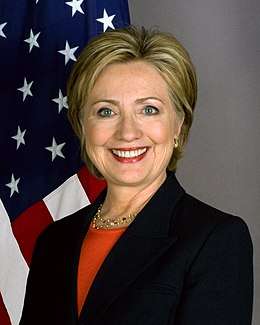 |
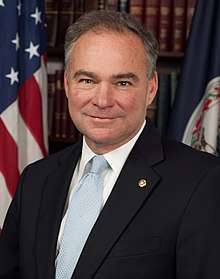 | ||||||||||||||||||||||||||||
| 67th U.S. Secretary of State (2009–2013) |
U.S. Senator from Virginia (2013–present) | ||||||||||||||||||||||||||||
| Campaign | |||||||||||||||||||||||||||||
 | |||||||||||||||||||||||||||||
| [108][109][110] | |||||||||||||||||||||||||||||
Other major candidates
The following candidates were frequently interviewed by major broadcast networks and cable news channels, or were listed in publicly published national polls. Lessig was invited to one forum, but withdrew when rules were changed which prevented him from participating in officially sanctioned debates.
Clinton received 16,849,779 votes in the primary.
| Candidates in this section are sorted by date of withdrawal from the primaries | ||||||||
| Bernie Sanders | Martin O'Malley | Lawrence Lessig | Lincoln Chafee | Jim Webb | ||||
|---|---|---|---|---|---|---|---|---|
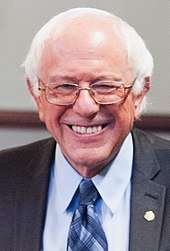 |
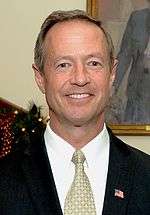 |
.png) |
.jpg) |
.jpg) | ||||
| U.S. Senator from Vermont (2007–present) | 61st Governor of Maryland (2007–2015) |
Harvard Law professor (2009–2016) |
74th Governor of Rhode Island (2011–2015) |
U.S. Senator from Virginia (2007–2013) | ||||
| Campaign | Campaign | Campaign | Campaign | Campaign | ||||
| LN: July 26, 2016 13,167,848 votes |
W: February 1, 2016 110,423 votes |
W: November 2, 2015 4 write-in votes in New Hampshire |
W: October 23, 2015 0 votes |
W: October 20, 2015 2 write-in votes in New Hampshire | ||||
| [111] | [112][113] | [98] | [114] | [115] | ||||
Vice presidential selection
In April 2016, the Clinton campaign began to compile a list of 15 to 20 individuals to vet for the position of running mate, even though Sanders continued to challenge Clinton in the Democratic primaries.[116] In mid-June, The Wall Street Journal reported that Clinton's shortlist included Representative Xavier Becerra from California, Senator Cory Booker from New Jersey, Senator Sherrod Brown from Ohio, Housing and Urban Development Secretary Julián Castro from Texas, Mayor of Los Angeles Eric Garcetti from California, Senator Tim Kaine from Virginia, Labor Secretary Tom Perez from Maryland, Representative Tim Ryan from Ohio, and Senator Elizabeth Warren from Massachusetts.[117] Subsequent reports stated that Clinton was also considering Secretary of Agriculture Tom Vilsack, retired Admiral James Stavridis, and Governor John Hickenlooper of Colorado.[118] In discussing her potential vice presidential choice, Clinton stated that the most important attribute she looked for was the ability and experience to immediately step into the role of president.[118]
On July 22, Clinton announced that she had chosen Senator Tim Kaine from Virginia as her running mate.[119] The delegates at the 2016 Democratic National Convention, which took place July 25–28, formally nominated the Democratic ticket.
Third parties and independents
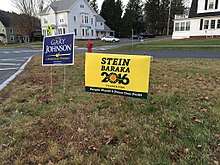
Third party and independent candidates that have obtained more than 100,000 votes nationally and one percent of the vote in at least one state, are listed separately.
Libertarian Party
- Gary Johnson, 29th Governor of New Mexico. Vice-presidential nominee: Bill Weld, 68th Governor of Massachusetts
| ||
|---|---|---|
|
Governor of New Mexico |
||
| ||
|---|---|---|
|
New York gubernatorial campaign U.S. Attorney for Massachusetts
|
||
- Additional Party Endorsements: Independence Party of New York
Ballot access to all 538 electoral votes
Nominees
| Gary Johnson | William Weld | ||||||||||||||||||||||||||||
|---|---|---|---|---|---|---|---|---|---|---|---|---|---|---|---|---|---|---|---|---|---|---|---|---|---|---|---|---|---|
| for President | for Vice President | ||||||||||||||||||||||||||||
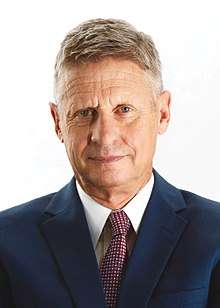 |
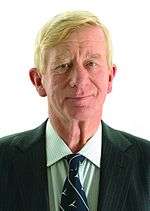 | ||||||||||||||||||||||||||||
| 29th Governor of New Mexico (1995–2003) |
68th Governor of Massachusetts (1991–1997) | ||||||||||||||||||||||||||||
| Campaign | |||||||||||||||||||||||||||||
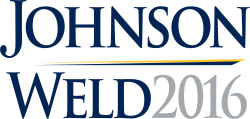 | |||||||||||||||||||||||||||||
Green Party
- Jill Stein, physician from Lexington, Massachusetts. Vice-presidential nominee: Ajamu Baraka, activist from Washington, DC
| ||
|---|---|---|
|
Political Parties  |
||
Ballot access to 480 electoral votes (522 with write-in):[122] – map
- As write-in: Georgia, Indiana, North Carolina[123][124]
- Ballot access lawsuit pending: Oklahoma[125]
- No ballot access: Nevada, South Dakota[123][126]
Nominees
| Green Party ticket, 2016 | |||||||||||||||||||||||||||||
| Jill Stein | Ajamu Baraka | ||||||||||||||||||||||||||||
|---|---|---|---|---|---|---|---|---|---|---|---|---|---|---|---|---|---|---|---|---|---|---|---|---|---|---|---|---|---|
| for President | for Vice President | ||||||||||||||||||||||||||||
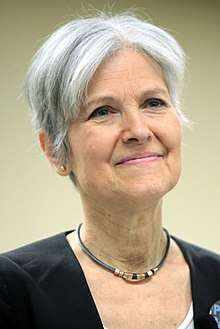 |
_(cropped).jpg) | ||||||||||||||||||||||||||||
| Physician from Lexington, Massachusetts |
Activist from Washington, DC | ||||||||||||||||||||||||||||
| Campaign | |||||||||||||||||||||||||||||
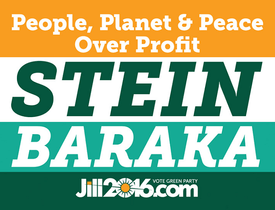 | |||||||||||||||||||||||||||||
| [127][128] | |||||||||||||||||||||||||||||
Independent
- Evan McMullin, chief policy director for the House Republican Conference. Vice-presidential nominee: Mindy Finn, president of Empowered Women.
- Additional Party Endorsement: Independence Party of Minnesota, South Carolina Independence Party
Ballot access to 84 electoral votes (451 with write-in):[129] – map
- As write-in: Alabama, Alaska, Arizona, California, Connecticut, Delaware, Georgia, Illinois, Kansas, Maine, Maryland, Massachusetts, Michigan, Missouri, Montana, Nebraska, New Hampshire, New Jersey, New York, North Dakota, Ohio, Oregon, Pennsylvania, Rhode Island, Tennessee, Texas, Vermont, Washington, West Virginia, Wisconsin[129][130][131][132][133][134][135]
- No ballot access: District of Columbia, Florida, Hawaii, Indiana, Mississippi, Nevada, North Carolina, Oklahoma, South Dakota, Wyoming
In some states, Evan McMullin's running mate was listed as Nathan Johnson on the ballot rather than Mindy Finn, although Nathan Johnson was intended to only be a placeholder until an actual running mate was chosen.[136]
| Independent ticket, 2016 | |||||||||||||||||||||||||||||
| Evan McMullin | Mindy Finn | ||||||||||||||||||||||||||||
|---|---|---|---|---|---|---|---|---|---|---|---|---|---|---|---|---|---|---|---|---|---|---|---|---|---|---|---|---|---|
| for President | for Vice President | ||||||||||||||||||||||||||||
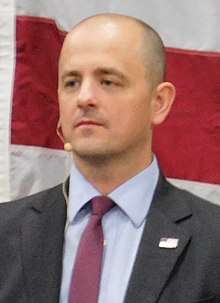 |
.jpg) | ||||||||||||||||||||||||||||
| Chief policy director for the House Republican Conference (2015–2016) |
President of Empowered Women (2015–present) | ||||||||||||||||||||||||||||
| Campaign | |||||||||||||||||||||||||||||
 | |||||||||||||||||||||||||||||
| [137] | |||||||||||||||||||||||||||||
Constitution Party
- Darrell Castle, attorney from Memphis, Tennessee. Vice-presidential nominee: Scott Bradley, businessman from Utah
Ballot access to 207 electoral votes (451 with write-in):[138][139] – map
- As write-in: Alabama, Arizona, Connecticut, Delaware, Georgia, Illinois, Indiana, Kansas, Kentucky, Maine, Maryland, Montana, Nebraska, New Hampshire, New York, Ohio, Oregon, Rhode Island, Tennessee, Texas, Vermont, Virginia[138][140][141][142][143]
- No ballot access: California, District of Columbia, Massachusetts, North Carolina, Oklahoma[138]
Nominees
| Constitution Party ticket, 2016 | |
| Darrell Castle | Scott Bradley |
|---|---|
| for President | for Vice President |
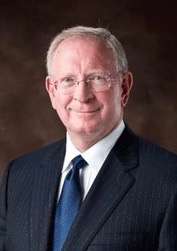 |
|
| Attorney from Memphis, Tennessee |
Businessman from Utah |
| Campaign | |
| [144] | |
Other nominations
| Party | Presidential nominee | Vice presidential nominee | Attainable Electors (write-in) |
Popular Vote | States with ballot access (write-in) |
|---|---|---|---|---|---|
| American Delta Party Reform Party |
Rocky De La Fuente Businessman from California |
Michael Steinberg Lawyer from Florida |
147 (305) map |
33,133 (0.02%) |
Alaska, Colorado, Florida, Idaho, Iowa, Kentucky, Minnesota, Mississippi, Montana, Nevada, New Hampshire, New Jersey, New Mexico, North Dakota, Rhode Island, Tennessee, Utah, Vermont, Wisconsin, Wyoming[139][145][146][147][148][149][150] (Alabama, Arizona, Connecticut, Delaware, Indiana, Kansas, Maryland, Missouri, Nebraska, New York, Oregon, Pennsylvania, Virginia, Washington, West Virginia)[130][131][132][134][140][142][151][152][153][154][155][156][143][157][158] |
| Party for Socialism and Liberation |
Gloria La Riva Newspaper printer and activist from California |
Eugene Puryear Activist from Washington, DC |
112 (226) map |
74,402 (0.05%) |
California, Colorado, Iowa, Louisiana, New Jersey, New Mexico, Vermont, Washington[161][162] (Alabama, Connecticut, Delaware, Kansas, Maryland, Minnesota, New Hampshire, New York, Oregon, Pennsylvania, Rhode Island, West Virginia)[131][132][134][142][151][152][156][158][163] |
| Socialist Workers Party | Alyson Kennedy Mineworker and Labor Leader from Illinois |
Osborne Hart of Pennsylvania |
70 (123) map |
12,465 (0.01%) |
Colorado, Louisiana, Minnesota, New Jersey, Tennessee, Utah, Washington[161] (Alabama, Iowa, New Hampshire, Oregon, Pennsylvania, Rhode Island, Vermont)[151][156] |
| Workers World Party | Monica Moorehead perennial candidate and political activist from Alabama[164] |
Lamont Lilly of North Carolina[165] |
30 (235) map |
4,319 (0.00%) |
New Jersey, Utah, Wisconsin[161] (Alabama, Indiana, Idaho, Iowa, Kansas, Massachusetts, Michigan, Montana, New Hampshire, New, York, Ohio, Oregon, Pennsylvania, Rhode Island, Texas, Vermont, Washington, West Virginia)[132][134][151][153][157][158][166][167][168][169][170][171] |
| Socialist Party USA |
Mimi Soltysik former National Co-Chair of the Socialist Party USA from California[173] Campaign |
Angela Nicole Walker of Wisconsin |
25 (209) map |
2,704 (0.00%) |
Colorado, Michigan, Guam[161][162][174] (Alabama, Indiana, Iowa, Maryland, Minnesota, Montana, New Hampshire, New Jersey, New York, Oregon, Pennsylvania, Rhode Island, Texas, Utah, Vermont, Wisconsin)[134][142][151][153][156][157][163][169][171][175][176] |
| Prohibition Party | James Hedges former Tax Assessor for Thompson Township, Fulton County, Pennsylvania[177][178] |
Bill Bayes of Mississippi[177] |
21 (116) map |
5,617 (0.00%) |
Arkansas, Colorado, Mississippi[161] (Alabama, Idaho, Iowa, Kansas, Maryland, Montana, New Hampshire, New Jersey, Oregon, Pennsylvania, Rhode Island, Vermont, West Virginia)[132][142][151][156][158][166][169] |
| Independent | Mike Smith Lawyer, Colorado |
Daniel White | 20 (222) |
9,345 (0.01%) |
Colorado, Tennessee[161] (Alabama, Alaska, Arizona, Connecticut, Delaware, Georgia, Idaho, Iowa, Kansas, Kentucky, Maryland, Minnesota, Montana, New Hampshire, New Jersey, Ohio, Oregon, Pennsylvania, Rhode Island, Utah, Vermont, Virginia, Washington. West Virginia)[131][132][140][142][143][151][152][156][157][158][163][166][169][170][175][179][180] |
| Independent | Richard Duncan Real Estate Agent from Ohio |
Ricky Johnson Preacher from Pennsylvania |
18 (173) |
24,307 (0.02%) |
Ohio[181] (Alabama, Alaska, Delaware, Florida, Idaho, Indiana, Iowa, Kentucky, Maryland, Minnesota, Montana, Nebraska, New Hampshire, New Jersey, Oregon, Pennsylvania, Rhode Island, Vermont, West Virginia)[142][151][152][153][155][156][158][162][163][166][169][179][180] |
| Independent | Laurence Kotlikoff Economics Professor at Boston University, Massachusetts |
Edward E. Leamer Economics Professor at UCLA, California |
17 (428) map |
3,596 (0.00%) |
Colorado, Louisiana[161] (Alabama, Alaska, Arizona, California, Connecticut, Florida, Georgia, Idaho, Illinois, Indiana, Iowa, Kentucky, Maine, Maryland, Massachusetts, Michigan, Minnesota, Missouri, Montana, New Hampshire, New Jersey, North Dakota, Ohio, Oregon, Pennsylvania, Rhode Island, Tennessee, Texas, Utah, Vermont, Virginia, Washington, West Virginia, Wisconsin)[130][131][133][135][140][142][143][151][153][156][157][158][162][163][166][167][168][169][170][171][175][176][179][180][182][183][184][185] |
| America's Party | Tom Hoefling activist from Iowa[186] |
Steve Schulin of South Carolina |
17 (369) map |
4,845 (0.00%) |
Colorado, Louisiana[161][187] (Alabama, Alaska, Arizona, Connecticut, Delaware, Georgia, Idaho, Illinois, Indiana, Iowa, Kansas, Kentucky, Maryland, Michigan, Minnesota, Missouri, Montana, Nebraska, New Hampshire, New Jersey, New York, Ohio, Oregon, Pennsylvania, Rhode Island, Tennessee, Texas, Utah, Vermont, Virginia, Washington, West Virginia, Wisconsin)[131][132][133][134][140][141][142][143][151][152][153][155][156][157][158][163][166][168][169][170][171][175][176][179][180][183][185] |
| Veterans Party of America | Chris Keniston reliability engineer from Texas[188] |
Deacon Taylor of Nevada[189] |
17 (196) map |
7,248 (0.01%) |
Colorado, Louisiana[161] (Alabama, Alaska, Idaho, Iowa, Kentucky, Minnesota, Nebraska, New Hampshire, New Jersey, New York, Ohio, Oregon, Pennsylvania, Rhode Island, Vermont, Virginia, Washington, Wisconsin)[134][143][151][155][156][157][163][166][170][176][179][180] |
| Legal Marijuana Now Party | Dan Vacek of Minnesota |
Mark Elworth Jr. of Nebraska |
16 (77) |
13,537 (0.01%) |
Iowa, Minnesota[161] (Alabama, New Hampshire, New Jersey, Oregon, Pennsylvania, Rhode Island, Vermont)[151][156] |
| Independent | Lynn Kahn Doctor of Clinical Psychology from Maryland |
Kathleen Monahan of Florida |
12 (160) |
5,730 (0.00%) |
Arkansas, Iowa[148][161] (Alabama, Delaware, Idaho, Kansas, Maryland, Minnesota, Montana, Nebraska, New Hampshire, New Jersey, New York, Oregon, Pennsylvania, Rhode Island, Vermont, Washington, West Virginia)[132][134][142][151][152][155][156][157][158][163][166][169] |
| American Solidarity Party | Mike Maturen sales professional and magician from Michigan |
Juan Muñoz of Texas |
9 (332) map |
6,714 (0.00%) |
Colorado[190] (Alabama, Alaska, California, Georgia, Idaho, Iowa, Kansas, Kentucky, Maryland, Michigan, Minnesota, Nebraska, New Hampshire, New Jersey, New York, North Dakota, Ohio, Oregon, Pennsylvania, Rhode Island, Texas, Vermont, Virginia, Washington, Wisconsin)[130][132][134][135][141][142][143][151][155][156][157][163][166][168][170][171][176][179][180] |
| Independent | Joseph Allen Maldonado of Oklahoma |
Douglas K. Terranova | 9 (212) |
961 (0.00%) |
Colorado[190] (Alabama, Alaska, Arizona, Connecticut, Delaware, Illinois, Indiana, Iowa, Kentucky, Maryland, Minnesota, Montana, Nebraska, New Hampshire, New Jersey, Ohio, Oregon, Pennsylvania, Rhode Island, Vermont, Washington, West Virginia, Wisconsin)[131][140][142][151][152][153][155][156][157][158][163][169][170][176][179][180][183] |
| Independent | Ryan Alan Scott | Bruce Kendall Barnard | 9 (108) |
749 (0.00%) |
Colorado[190] (Alabama, Delaware, Iowa, New Hampshire, New Jersey, New York, Oregon, Pennsylvania, Rhode Island, Vermont)[134][151][152][156] |
| American Party (South Carolina) | Peter Skewes Animal Science Professor at Clemson University, South Carolina |
Michael Lacy | 9 (83) |
3,246 (0.00%) |
South Carolina[191] (Alabama, Connecticut, Iowa, New Hampshire, New Jersey, Oregon, Pennsylvania, Rhode Island, Vermont)[131][151][156] |
| Approval Voting Party | Frank Atwood of Colorado |
Blake Huber of Colorado |
9 (76) |
337 (0.00%) |
Colorado[190] (Alabama, Iowa, New Hampshire, New Jersey, Oregon, Pennsylvania, Rhode Island, Vermont)[151][156] |
| Independent American Party | Kyle Kenley Kopitke of Michigan |
Narthan R. Sorenson | 9 (76) |
1,096 (0.00%) |
Colorado[190] (Alabama, Iowa, New Hampshire, New Jersey, Oregon, Pennsylvania, Rhode Island, Vermont)[151][156] |
| Nutrition Party | Rod Silva restaurateur from New Jersey[192][193] |
Richard Silva | 9 (76) |
751 (0.00%) |
Colorado[190] (Alabama, Iowa, New Hampshire, New Jersey, Oregon, Pennsylvania, Rhode Island, Vermont)[151][156] |
| United States Pacifist Party | Bradford Lyttle peace activist from Illinois |
Hannah Walsh | 9 (76) |
382 (0.00%) |
Colorado[190] (Alabama, Iowa, New Hampshire, New Jersey, Oregon, Pennsylvania, Rhode Island, Vermont)[151][156] |
| Socialist Equality Party | Jerry White peace activist from Michigan |
Niles Niemuth journalist from Wisconsin |
8 (166) |
481 (0.00%) |
Louisiana[194] (Alabama, California, Delaware, Iowa, Kentucky, Maryland, Minnesota, New Hampshire, New Jersey, Oregon, Pennsylvania, Rhode Island, Vermont, West Virginia)[130][142][151][152][156][158][163][180] |
| Independent | Princess Khadijah Jacob-Fambro of California |
Milton Fambro of California |
8 (75) |
749 (0.00%) |
Louisiana[194] (Alabama, Iowa, New Hampshire, New Jersey, Oregon, Pennsylvania, Rhode Island, Vermont)[151][156] |
| Independent American Party | Rocky Giordani from California |
Farley Anderson activist from Utah |
6 (79) |
2,752 (0.00%) |
Utah[175] (Alabama, Iowa, Kansas, New Hampshire, New Jersey, Oregon, Pennsylvania, Rhode Island, Vermont)[132][151][156] |
| Constitution Party of Idaho | Scott Copeland of Texas |
J.R. Meyers | 4 (71) |
2,356 (0.00%) |
Idaho[195] (Alabama, Iowa, New Hampshire, New Jersey, Oregon, Pennsylvania, Rhode Island, Vermont)[151][156] |
Candidates gallery
General election campaign
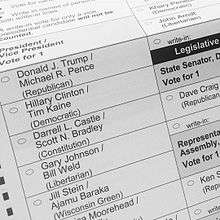
Hillary Clinton focused her candidacy on several themes, including raising middle class incomes, expanding women's rights, instituting campaign finance reform, and improving the Affordable Care Act. In March 2016, she laid out a detailed economic plan basing her economic philosophy on inclusive capitalism, which proposed a "clawback" which would rescind tax relief and other benefits for companies that move jobs overseas; with provision of incentives for companies that share profits with employees, communities and the environment, rather than focusing on short-term profits to increase stock value and rewarding shareholders; as well as increasing collective bargaining rights; and placing an "exit tax" on companies that move their headquarters out of America in order to pay a lower tax rate overseas.[196] Clinton promoted equal pay for equal work to address current alleged shortfalls in how much women are paid to do the same jobs men do,[197] promoted explicitly focus on family issues and support of universal preschool,[198] expressed support for the right to same-sex marriage,[198] and proposed allowing undocumented immigrants to have a path to citizenship stating that it "[i]s at its heart a family issue."[199]
Donald Trump's campaign drew heavily on his personal image, enhanced by his previous media exposure.[200] The primary slogan of the Trump campaign, extensively used on campaign merchandise, was Make America Great Again. The red baseball cap with the slogan emblazoned on the front became a symbol of the campaign, and has been frequently donned by Trump and his supporters.[201] Trump's right-wing populist positions—reported by The New Yorker to be nativist, protectionist, and semi-isolationist—differ in many ways from traditional conservatism.[202] He opposed many free trade deals and military interventionist policies that conservatives generally support, and opposed cuts in Medicare and Social Security benefits. Moreover, he has insisted that Washington is "broken" and can only be fixed by an outsider.[203][204][205] Trump support was high among working and middle-class white male voters with annual incomes of less than $50,000 and no college degree.[206] This group, particularly those with less than a high-school education, suffered a decline in their income in recent years.[207] According to The Washington Post, support for Trump is higher in areas with a higher mortality rate for middle-age white people.[208] A sample of interviews with more than 11,000 Republican-leaning respondents from August to December 2015 found that Trump at that time found his strongest support among Republicans in West Virginia, followed by New York, and then followed by six Southern states.[209]
Clinton had an uneasy, and at times adversarial relationship with the press throughout her life in public service.[210] Weeks before her official entry as a presidential candidate, Clinton attended a political press corps event, pledging to start fresh on what she described as a "complicated" relationship with political reporters.[211] Clinton was initially criticized by the press for avoiding taking their questions,[212][213] after which she provided more interviews.
In contrast, Trump benefited from free media more than any other candidate. From the beginning of his campaign through February 2016, Trump received almost $2 billion in free media attention, twice the amount that Clinton received.[214] According to data from the Tyndall Report, which tracks nightly news content, through February 2016, Trump alone accounted for more than a quarter of all 2016 election coverage on the evening newscasts of NBC, CBS and ABC, more than all the Democratic campaigns combined.[215][216][217] Observers noted Trump's ability to garner constant mainstream media coverage "almost at will".[218] However, Trump frequently criticized the media for writing what he alleged to be false stories about him[219] and he has called upon his supporters to be "the silent majority".[220] Trump also said the media "put false meaning into the words I say", and says he does not mind being criticized by the media as long as they are honest about it.[221][222]
Both Clinton and Trump were seen unfavorably by the general public, and their controversial nature set the tone of the campaign.[223]
.jpg)
Clinton's practice during her time as Secretary of State of using a private email address and server, in lieu of State Department servers, gained widespread public attention back in March 2015.[224] Concerns were raised about security and preservation of emails, and the possibility that laws may have been violated.[225] After allegations were raised that some of the emails in question fell into this so-called "born classified" category, an FBI probe was initiated regarding how classified information was handled on the Clinton server.[226][227][228][229] The FBI probe was concluded on July 5, 2016, with a recommendation of no charges, a recommendation that was followed by the Justice Department. On October 28, eleven days before the election, FBI Director James Comey informed Congress that the FBI was analyzing additional emails obtained during its investigation of an unrelated case.[230][231] On November 6, he notified Congress that the new emails did not change the FBI's earlier conclusion.[232][233]
Also, on September 9, 2016, Clinton stated: "You know, just to be grossly generalistic, you could put half of Trump's supporters into what I call the basket of deplorables. They're racist, sexist, homophobic, xenophobic, Islamophobic—you name it."[234] Donald Trump criticized Clinton's remark as insulting his supporters.[235][236] The following day Clinton expressed regret for saying "half", while insisting that Trump had deplorably amplified "hateful views and voices".[237] Previously on August 25, 2016, Clinton gave a speech criticizing Trump's campaign for using "racist lies" and allowing the alt-right to gain prominence.[238]
.jpg)
On the other side, on October 7, 2016, video and accompanying audio were released by The Washington Post in which Trump referred obscenely to women in a 2005 conversation with Billy Bush while they were preparing to film an episode of Access Hollywood. The audio was met with a reaction of disbelief and disgust from the media.[239][240][241] Following the revelation, Trump's campaign issued an apology, stating that the video was of a private conversation from "many years ago".[242] The incident was condemned by numerous prominent Republicans like Reince Priebus, Mitt Romney, John Kasich, Jeb Bush[243] and the Speaker of the House Paul Ryan.[244] By October 8 several dozen Republicans had called for Trump to withdraw from the campaign and let Pence head the ticket.[245] Trump insisted he would never drop out.[246]
The ongoing controversy of the election made third parties attract voters' attention. On March 3, 2016, Libertarian Gary Johnson addressed the Conservative Political Action Conference in Washington DC, touting himself as the third-party option for anti-Trump Republicans.[247][248] In early May, some commentators opined that Johnson was moderate enough to pull votes away from both Hillary Clinton and Donald Trump who were very disliked and polarizing.[249] Both conservative and liberal media noted that Johnson could get votes from "Never Trump" Republicans and disaffected Bernie Sanders supporters.[250] Johnson also began to get time on national television, being invited on ABC News, NBC News, CBS News, CNN, Fox News, MSNBC, Bloomberg, and many other networks.[251] In September and October 2016, Johnson suffered a "string of damaging stumbles when he has fielded questions about foreign affairs."[252][253] On September 8, Johnson, when he appeared on MSNBC's Morning Joe, was asked by panelist Mike Barnicle, "What would you do, if you were elected, about Aleppo?" (referring to a war-torn city in Syria). Johnson responded, "And what is Aleppo?"[254] Johnson's "what is Aleppo?" question prompted widespread attention, much of it negative.[254][255] Later that day, Johnson said that he had "blanked" and that he did "understand the dynamics of the Syrian conflict – I talk about them every day."[255]
On the other hand, Green Party candidate Jill Stein stated that the Democratic and Republican parties are "two corporate parties" that have converged into one.[256] Concerned by the rise of the far right internationally and the tendency towards neoliberalism within the Democratic Party, she has said, "The answer to neofascism is stopping neoliberalism. Putting another Clinton in the White House will fan the flames of this right-wing extremism."[257][258]
In response to Johnson's growing poll numbers, the Hillary Clinton campaign and Democratic allies increased their criticism of Johnson in September 2016, warning that "a vote for a third party is a vote for Donald Trump" and deploying Senator Bernie Sanders (Clinton's former primary rival, who supported her in the general election) to win over voters who might be considering voting for Johnson or for Stein.[259]
Ballot access
| Presidential ticket | Party | Ballot access | Votes[260][261] | Percentage | ||
|---|---|---|---|---|---|---|
| States | Electors | % of voters | ||||
| Trump / Pence | Republican | 50 + DC | 538 | 100% | 62,984,828 | 46.09% |
| Clinton / Kaine | Democratic | 50 + DC | 538 | 100% | 65,853,514 | 48.18% |
| Johnson / Weld | Libertarian | 50 + DC | 538 | 100% | 4,489,341 | 3.28% |
| Stein / Baraka | Green | 44 + DC | 480 | 89% | 1,457,218 | 1.07% |
| McMullin / Finn | Independent | 11 | 84 | 15% | 731,991 | 0.54% |
| Castle / Bradley | Constitution | 24 | 207 | 39% | 203,090 | 0.15% |
- Candidates in bold were on ballots representing 270 electoral votes, without needing write-in states.
- All other candidates were on the ballots of fewer than 25 states, but had write-in access greater than 270.
Party conventions

- Democratic Party
- July 25–28, 2016: Democratic National Convention was held in Philadelphia, Pennsylvania.[262]
- Republican Party
- Libertarian Party
- Green Party
- Constitution Party
- April 13–16, 2016: Constitution Party National Convention was held in Salt Lake City, Utah.[269]
Campaign finance
This is an overview of the money used in the campaign as it is reported to Federal Election Commission (FEC) and released in September 2016. Outside groups are independent expenditure only committees—also called PACs and SuperPACs. The sources of the numbers are the FEC and Center for Responsive Politics.[270] Some spending totals are not available, due to withdrawals before the FEC deadline. As of September 2016, ten candidates with ballot access have filed financial reports with the FEC.
| Candidate | Campaign committee (as of December 9) | Outside groups (as of December 9) | Total spent | |||||
|---|---|---|---|---|---|---|---|---|
| Money raised | Money spent | Cash on hand | Debt | Money raised | Money spent | Cash on hand | ||
| Hillary Clinton[271][272] | $497,808,791 | $435,367,811 | $62,440,979 | $111,238 | $205,909,959 | $204,267,754 | $1,642,205 | $639,635,565 |
| Donald Trump[273][274] | $247,541,449 | $231,546,996 | $15,994,454 | $2,086,572 | $74,905,285 | $70,941,922 | $3,963,363 | $302,488,918 |
| Gary Johnson[275][276] | $11,410,313 | $10,308,873 | $1,101,440 | $0 | $1,386,554 | $1,310,578 | $75,976 | $11,619,451 |
| Rocky De La Fuente[277] | $7,351,270 | $7,354,663 | -$3,392 | $7,334,250 | $0 | $0 | $0 | $7,354,663 |
| Jill Stein[278][279] | $3,509,477 | $3,451,174 | $58,303 | $87,740 | $0 | $0 | $0 | $3,451,174 |
| Evan McMullin[280] | $1,644,102 | $1,642,165 | $1,937 | $0 | $0 | $0 | $0 | $1,642,165 |
| Darrell Castle[281] | $52,234 | $51,365 | $869 | $2,500 | $0 | $0 | $0 | $51,365 |
| Gloria La Riva[282] | $29,243 | $24,207 | $5,034 | $0 | $0 | $0 | $0 | $24,207 |
| Monica Moorehead[283] | $11,547 | $9,127 | $2,419 | $4,500 | $0 | $0 | $0 | $9,127 |
| Peter Skewes[284] | $7,966 | $4,238 | $7,454 | $8,000 | $0 | $0 | $0 | $4,238 |
Newspaper endorsements
Clinton was endorsed by The New York Times,[285] the Los Angeles Times,[286] the Houston Chronicle,[287] the San Jose Mercury News,[288] the Chicago Sun-Times[289] and the New York Daily News[290] editorial boards. Trump, who has frequently criticized the mainstream media, was not endorsed by the vast majority of newspapers,[291][292] with the Las Vegas Review-Journal,[293] The Florida Times-Union,[294] and the tabloid National Enquirer his highest profile supporters.[295] Several papers which endorsed Clinton, such as the Houston Chronicle,[287] The Dallas Morning News,[296] The San Diego Union-Tribune,[297] The Columbus Dispatch[298] and The Arizona Republic,[299] endorsed their first Democratic candidate for many decades. USA Today, which had not endorsed any candidate since it was founded in 1982, broke tradition by giving an anti-endorsement against Trump, declaring him "unfit for the presidency".[300][301] The Atlantic, which has been in circulation since 1857, gave Clinton its third-ever endorsement (after Abraham Lincoln and Lyndon Johnson).[302]
Other traditionally Republican papers, including the New Hampshire Union Leader, which had endorsed the Republican nominee in every election for the last 100 years,[303] The Detroit News, which had not endorsed a non-Republican in its 143 years,[304] and the Chicago Tribune,[305] endorsed Gary Johnson.
Russian involvement
On December 9, 2016, the Central Intelligence Agency issued an assessment to lawmakers in the US Senate, stating that a Russian entity hacked the DNC and John Podesta's emails to assist Donald Trump. The Federal Bureau of Investigation agreed.[306] President Barack Obama ordered a "full enquiry" into such possible intervention.[307] Director of National Intelligence James R. Clapper in early January 2017 testified before a Senate committee that Russia's meddling in the 2016 presidential campaign went beyond hacking, and included disinformation and the dissemination of fake news, often promoted on social media.[308]
President-elect Trump originally called the report fabricated,[309] and Wikileaks denied any involvement by Russian authorities.[310] Days later, Trump said he could be convinced of the Russian hacking "if there is a unified presentation of evidence from the Federal Bureau of Investigation and other agencies."[311]
Several U.S. senators—including Republicans John McCain, Richard Burr, and Lindsey Graham—demanded a congressional investigation.[312] The Senate Intelligence Committee announced the scope of their official inquiry on December 13, 2016, on a bipartisan basis; work began on January 24, 2017.[26]
Notable expressions, phrases, and statements
- Basket of deplorables – a controversial phrase coined by Hillary Clinton to describe Trump's supporters.
- Birdie Sanders – during a campaign stop in Portland, Oregon, a house finch[313] landed on Sanders's lectern while he was addressing a large crowd of supporters.[314] The event became popular with the Sanders community and Sanders even began to publicize the bird as "Birdie Sanders".[314]
- Build that wall / Mexico will pay for the wall – Trump's campaign promise that if elected he will build a wall on the border between the US and Mexico, with Mexico financing the project.[315][316]
- Drain the swamp – a phrase Donald Trump invoked late in the campaign to describe what needs to be done to fix problems in the federal government. Trump acknowledged that the phrase was suggested to him, and he was initially skeptical about using it.[317]
- Fake news – stories that are untrue. Trump has used the expression to refer to stories he dislikes.[318][319][320]
- Feel the Bern – a phrase chanted by supporters of the Bernie Sanders campaign which was officially adopted by his campaign.[321]
- Grab 'em by the pussy – a remark made by Trump during a 2005 behind-the-scenes conversation with Billy Bush which was released during the campaign. The remark was part of a conversation in which Trump boasted that as a celebrity he can get away with things (such as grabbing women by their genitalia) that non-celebrities cannot.
- I'm with her – Clinton's unofficial campaign slogan ("Stronger Together" was the official slogan).[322]
- Lock her up – a chant first used at the Republican convention to claim that Hillary Clinton is guilty of a crime. The chant was later used at many Trump campaign rallies.[323]
- Make America great again – Trump's campaign slogan.
- Nevertheless, she persisted – said by Republican Senator Mitch McConnell to silence Democratic Senator Elizabeth Warren’s objections to confirm Jeff Sessions as Attorney General. It became a popular expression by feminists groups and eventually reached the attention of Clinton.
- Trump's use of derogatory nicknames to deride his opponents – these include "Crooked Hillary", "Little Marco", "Low energy Jeb", and "Lying Ted."
- Small hands – Marco Rubio asserting that Trump has small hands, and implying that the size of his hands is proportional to the size of his genitals.[324]
- What is Aleppo? – uttered by Gary Johnson during an interview when questioned about the status of Aleppo during the Syrian Civil War.[325]
- What the hell do you have to lose? - said by Trump to inner-city African Americans at rallies starting on August 19, 2016.[326][327]
Debates
Primary election debates
General election debates

Hempstead, NY
Farmville, VA
St. Louis, MO
Las Vegas
The Commission on Presidential Debates (CPD), a non-profit organization, hosted debates between qualifying presidential and vice-presidential candidates. According to the commission's website, to be eligible to opt to participate in the anticipated debates, "... in addition to being Constitutionally eligible, candidates must appear on a sufficient number of state ballots to have a mathematical chance of winning a majority vote in the Electoral College, and have a level of support of at least 15 percent of the national electorate as determined by five selected national public opinion polling organizations, using the average of those organizations' most recently publicly-reported results at the time of the determination."[328]
The three locations chosen to host the presidential debates, and the one location selected to host the vice presidential debate, were announced on September 23, 2015. The site of the first debate was originally designated as Wright State University in Dayton, Ohio; however, due to rising costs and security concerns, the debate was moved to Hofstra University in Hempstead, New York.[329]
On August 19, Kellyanne Conway, Trump's campaign manager confirmed that Trump would participate in a series of three debates.[330][331][332][333] Trump had complained two of the scheduled debates, one on September 26 and the other October 9, would have to compete for viewers with National Football League games, referencing the similar complaints made regarding the dates with low expected ratings during the Democratic Party presidential debates.[334]
The Free & Equal Elections Foundation announced plans to host an open debate among all presidential candidates who had ballot access sufficient to represent a majority of electoral votes.[335] In October 2016 Free & Equal extended the invitation to all candidates with ballot lines representing at least 15% of the electoral vote. The nominees of the Democratic, Republican, Libertarian, Green, Constitution, Reform, and Socialism and Liberation parties, as well as independent candidate Evan McMullin, were invited to participate.[336] The debate was held at the University of Colorado Boulder's Macky Auditorium on October 25, 2016. It was moderated by Ed Asner and Christina Tobin, with Darrell Castle, Rocky De La Fuente, and Gloria La Riva participating.[337]
PBS hosted a debate moderated by Tavis Smiley between Libertarian candidate Gary Johnson and Green Party candidate Jill Stein.[338]
| No. | Date | Time | Host | City | Moderator(s) | Participants | |||||||||||||||
|---|---|---|---|---|---|---|---|---|---|---|---|---|---|---|---|---|---|---|---|---|---|
| P1 | September 26, 2016 | 9 p.m. EDT | Hofstra University | Hempstead, New York | Lester Holt | Hillary Clinton Donald Trump | |||||||||||||||
| VP | October 4, 2016 | 9 p.m. EDT | Longwood University | Farmville, Virginia | Elaine Quijano | Tim Kaine Mike Pence | |||||||||||||||
| P2 | October 9, 2016 | 8 p.m. CDT | Washington University in St. Louis | St. Louis, Missouri | Anderson Cooper Martha Raddatz |
Hillary Clinton Donald Trump | |||||||||||||||
| P3 | October 19, 2016 | 6 p.m. PDT | University of Nevada, Las Vegas | Las Vegas, Nevada | Chris Wallace | Hillary Clinton Donald Trump | |||||||||||||||
| P4 | October 25, 2016 | 7 p.m. MDT | University of Colorado Boulder | Boulder, Colorado | Ed Asner Christina Tobin |
Darrell Castle Rocky De La Fuente Gloria La Riva | |||||||||||||||
| = Sponsored by the CPD; = Sponsored by Free & Equal | |||||||||||||||||||||
Results
.jpg)
The election was held on November 8, 2016. Clinton cast her vote in Chappaqua, Westchester County, New York, while Trump voted in a Manhattan public school.[339] Throughout the day, the election process went more smoothly than many had expected, with only a few reports of long lines and equipment problems.
The news media and election experts were surprised twice, at Trump's winning the GOP nomination and in winning the electoral college. English political scientist Lloyd Gruber says, "One of the major casualties of the 2016 election season has been the reputation of political science, a discipline whose practitioners had largely dismissed Donald Trump's chances of gaining the Republican nomination."[340] The final polls showed a lead by Clinton—and, in the end, she did receive more votes.[341] Trump himself expected to lose the election based on polling, and rented a small hotel ballroom to make a brief concession speech; "I said if we're going to lose I don't want a big ballroom", he said.[342] The Republican candidate performed surprisingly well in all battleground states, especially Florida, Iowa, Ohio and North Carolina. Even Wisconsin, Pennsylvania, and Michigan, states that had been predicted to vote Democratic, were won by Trump.[343] Cindy Adams, present at Trump Tower, reported that "Trumptown knew they'd won by 5:30. Math, calculations, candidate dislike causing voter abstention begat the numbers."[344] Trump said that he was surprised by how "that map was getting red as hell. That map was bleeding red ... I always used to believe in [polls]. I don't believe them anymore."[342]
On November 9, 2016, at 3:00 AM Eastern Time, Trump secured over 270 electoral votes, the majority of the 538 electors in the Electoral College, enough to make him the president-elect of the United States.[345][346]
According to the authors of Shattered: Inside Hillary Clinton's Doomed Campaign, by late Tuesday night the White House had decided that Trump had won the election. Obama aide David Simas called Clinton campaign manager Robby Mook to unsuccessfully persuade Clinton to concede the election. Obama then called Clinton herself, citing the importance of continuity of government, to publicly acknowledge that Trump had won; believing that she was still unwilling to concede the president called Podesta, telling him that the election was over, but the call to Clinton had likely already persuaded her.[347] Clinton called Trump early on Wednesday morning to concede defeat,[348] and later that day asked her supporters to accept the result and hoped that Trump would be "a successful president for all Americans."[349] In his victory speech Trump appealed for unity saying "it is time for us to come together as one united people" and praised Clinton who was owed "a major debt of gratitude for her service to our country."[350]
Six states plus a portion of Maine that Obama won in 2012 switched to Trump. These are (with Electoral College votes in parentheses): Florida (29), Pennsylvania (20), Ohio (18), Michigan (16), Wisconsin (10), Iowa (6), and Maine's second congressional district (1). Initially, Trump won exactly 100 more Electoral College votes than Mitt Romney in 2012, with two lost to faithless electors the following month. Thirty-nine states swung more Republican compared to the previous presidential election, while eleven states and the District of Columbia swung more Democratic.[261]
Based on U.S. Census Bureau estimates[1] of the voting age population (VAP), turnout of voters casting a vote for President was nearly 1% higher than 2012. Examining overall turnout in the 2016 election, University of Florida Prof. Michael McDonald estimated[351] that 138.8 million Americans cast a ballot in 2016. 65.9 million of those ballots have been counted for Clinton and just under 63 million for Trump, representing 20.3% (Clinton) and 19.4% (Trump) of a census estimate of U.S. population that day of 324 million.[261][352] Considering a VAP of 250.6 million people and voting eligible population (VEP) of 230.6 million people, this is a turnout rate of 55.4% VAP and 60.2% VEP.[1][351] Based on this estimate, voter turnout was up compared to 2012 (54.1% VAP) but down compared to 2008 (57.4% VAP). A FEC report of the 2016 Presidential General Election recorded an official total of 136.7 million votes cast for President — more than any prior election.[1]
Data scientist Azhar Hamdan, explained the paradoxes of the 2016 outcome compared Trump's 30 states against Clinton's 20 states and the District of Columbia,[353][354] saying "chief among them the discrepancy between the popular vote, which Hillary Clinton won by 2.8 million votes, and the electoral college, where Trump won 304-227". He said Trump outperformed Mitt Romney's 2012 results, while Clinton only just matched Barack Obama's 2012 totals.[353] Hamdan also said Trump was "the highest vote earner of any Republican candidate ever," exceeding George W. Bush's 62.04 million votes in 2004, though neither reached Clinton's 65.9 million, nor Obama's 69.5 million votes in 2008, the overall record.[353] He concluded, with help from The Cook Political Report, that the election hinged not on Clinton's large 2.8 million overall vote margin over Trump, but rather on about 78,000 votes from only three counties in Wisconsin, Pennsylvania, and Michigan.[353][355]
Candidates table
Source (Popular Vote):
Nationwide:[260]
Leip, David. "2016 Presidential Election Results". Dave Leip's Atlas of U.S. Presidential Elections. Retrieved February 4, 2018.
For Bernie Sanders and John Kasich: CA:[356] and[357] NH:[358] VT:[359] NC:[360] PA:[361] RI:[362]
(a) Received electoral vote(s) from a faithless elector.
(b) Two faithless electors from Texas cast their presidential votes for Ron Paul and John Kasich, respectively. Chris Suprun stated that he cast his presidential vote for John Kasich and his vice presidential vote for Carly Fiorina. The other faithless elector in Texas, Bill Greene, cast his presidential vote for Ron Paul but cast his vice presidential vote for Mike Pence, as pledged. John Kasich received recorded write-in votes in Alabama, Georgia, Illinois, New Hampshire, North Carolina, Pennsylvania, and Vermont.
(c) Candidate received votes as a write-in. The exact numbers of write-in votes for Sanders have been published for three states. In California, his official running mate was Tulsi Gabbard and in New Hampshire and Vermont there was not a running mate attached to Sanders.[363] It was possible to vote Sanders as a write-in candidate in 14 states.[364]
Results by state
The table below displays the official vote tallies by each state's Electoral College voting method. The source for the results of all states is the official Federal Election Commission report. The column labeled "Margin" shows Trump's margin of victory over Clinton (the margin is negative for every state the Clinton won).
A total of 29 third party and independent presidential candidates appeared on the ballot in at least one state. Former Governor of New Mexico Gary Johnson and physician Jill Stein repeated their 2012 roles as the nominees for the Libertarian Party and the Green Party, respectively.[365] With ballot access to the entire national electorate, Johnson received nearly 4.5 million votes (3.27%), the highest nationwide vote share for a third-party candidate since Ross Perot in 1996,[366] while Stein received almost 1.45 million votes (1.06%), the most for a Green nominee since Ralph Nader in 2000.
Independent candidate Evan McMullin, who appeared on the ballot in 11 states, received over 732,000 votes (0.53%). He won 21.4% of the vote in his home state of Utah, the highest share of the vote for a third-party candidate in any state since 1992.[367] Despite dropping out of the election following his defeat in the Democratic primary, Senator Bernie Sanders received 5.7% of the vote in his home state of Vermont, the highest write-in draft campaign percentage for a presidential candidate in American history.[368] (Because of this, some of his supporters have suggested that Bernie would have won, meaning that Sanders could have beaten Trump even though Clinton was unable to.) Johnson and McMullin were the first third party candidates since Nader to receive at least 5% of the vote in one or more states, with Johnson crossing the mark in 11 states and McMullin crossing it in two.
Aside from Florida and North Carolina, the states which secured Trump's victory are situated in the Great Lakes/Rust Belt region. Wisconsin went Republican for the first time since 1984, while Pennsylvania and Michigan went Republican for the first time since 1988.[369][370][371] Stein petitioned for a recount in these states. The Clinton campaign pledged to participate in the Green Party recount efforts, while Trump backers challenged them in court.[372][373][374] Meanwhile, American Delta Party/Reform Party presidential candidate Rocky De La Fuente petitioned for and was granted a partial recount in Nevada.[375]
| States won by Clinton/Kaine |
| States won by Trump/Pence |
Electoral methods
- WTA—Winner-takes-all
- CD—Congressional district★
| Hillary Clinton Democratic |
Donald Trump Republican |
Gary Johnson Libertarian |
Jill Stein Green |
Evan McMullin Independent |
Others | Margin | Total | |||||||||||||||||
|---|---|---|---|---|---|---|---|---|---|---|---|---|---|---|---|---|---|---|---|---|---|---|---|---|
| State or district |
Electoral method |
# | % | Electoral votes |
# | % | Electoral votes |
# | % | Electoral votes |
# | % | Electoral votes |
# | % | Electoral votes |
# | % | Electoral votes |
# | % | # | State | Source(s) |
| Alabama | WTA | 729,547 | 34.36% | – | 1,318,255 | 62.08% | 9 | 44,467 | 2.09% | – | 9,391 | 0.44% | – | – | – | – | 21,712 | 1.02% | – | 588,708 | 27.73% | 2,123,372 | AL | [376] |
| Alaska | WTA | 116,454 | 36.55% | – | 163,387 | 51.28% | 3 | 18,725 | 5.88% | – | 5,735 | 1.80% | – | – | – | – | 14,307 | 4.49% | – | 46,933 | 14.73% | 318,608 | AK | [377] |
| Arizona | WTA | 1,161,167 | 45.13% | – | 1,252,401 | 48.67% | 11 | 106,327 | 4.13% | – | 34,345 | 1.33% | – | 17,449 | 0.68% | – | 1,476 | 0.06% | – | 91,234 | 3.55% | 2,573,165 | AZ | [378] |
| Arkansas | WTA | 380,494 | 33.65% | – | 684,872 | 60.57% | 6 | 29,829 | 2.64% | – | 9,473 | 0.84% | – | 13,255 | 1.17% | – | 12,712 | 1.12% | – | 304,378 | 26.92% | 1,130,635 | AR | [379] |
| California | WTA | 8,753,788 | 61.73% | 55 | 4,483,810 | 31.62% | – | 478,500 | 3.37% | – | 278,657 | 1.96% | – | 39,596 | 0.28% | – | 147,244 | 1.04% | – | −4,269,978 | −30.11% | 14,181,595 | CA | [380] |
| Colorado | WTA | 1,338,870 | 48.16% | 9 | 1,202,484 | 43.25% | – | 144,121 | 5.18% | – | 38,437 | 1.38% | – | 28,917 | 1.04% | – | 27,418 | 0.99% | – | −136,386 | −4.91% | 2,780,247 | CO | [381] |
| Connecticut | WTA | 897,572 | 54.57% | 7 | 673,215 | 40.93% | – | 48,676 | 2.96% | – | 22,841 | 1.39% | – | 2,108 | 0.13% | – | 508 | 0.03% | – | −224,357 | −13.64% | 1,644,920 | CT | [382] |
| Delaware | WTA | 235,603 | 53.09% | 3 | 185,127 | 41.72% | – | 14,757 | 3.32% | – | 6,103 | 1.37% | – | 706 | 0.16% | – | 1,518 | 0.34% | – | −50,476 | −11.37% | 443,814 | DE | [383][384] |
| District of Columbia | WTA | 282,830 | 90.48% | 3 | 12,723 | 4.07% | – | 4,906 | 1.57% | – | 4,258 | 1.36% | – | – | – | – | 6,551 | 2.52% | – | −270,107 | −86.78% | 311,268 | DC | [385] |
| Florida | WTA | 4,504,975 | 47.82% | – | 4,617,886 | 49.02% | 29 | 207,043 | 2.20% | – | 64,399 | 0.68% | – | – | – | – | 25,736 | 0.28% | – | 112,911 | 1.20% | 9,420,039 | FL | [386] |
| Georgia | WTA | 1,877,963 | 45.64% | – | 2,089,104 | 50.77% | 16 | 125,306 | 3.05% | – | 7,674 | 0.19% | – | 13,017 | 0.32% | – | 1,668 | 0.04% | – | 211,141 | 5.13% | 4,114,732 | GA | [387][388] |
| Hawaii | WTA | 266,891 | 62.22% | 3 | 128,847 | 30.03% | – | 15,954 | 3.72% | – | 12,737 | 2.97% | – | – | – | – | 4,508 | 1.05% | 1 | −138,044 | −32.18% | 428,937 | HI | [389] |
| Idaho | WTA | 189,765 | 27.49% | – | 409,055 | 59.26% | 4 | 28,331 | 4.10% | – | 8,496 | 1.23% | – | 46,476 | 6.73% | – | 8,132 | 1.18% | – | 219,290 | 31.77% | 690,255 | ID | [390] |
| Illinois | WTA | 3,090,729 | 55.83% | 20 | 2,146,015 | 38.76% | – | 209,596 | 3.79% | – | 76,802 | 1.39% | – | 11,655 | 0.21% | – | 1,627 | 0.03% | – | −944,714 | −17.06% | 5,536,424 | IL | [391] |
| Indiana | WTA | 1,033,126 | 37.91% | – | 1,557,286 | 56.82% | 11 | 133,993 | 4.89% | – | 7,841 | 0.27% | – | – | – | – | 2,712 | 0.10% | – | 524,160 | 19.17% | 2,734,958 | IN | [392] |
| Iowa | WTA | 653,669 | 41.74% | – | 800,983 | 51.15% | 6 | 59,186 | 3.78% | – | 11,479 | 0.73% | – | 12,366 | 0.79% | – | 28,348 | 1.81% | – | 147,314 | 9.41% | 1,566,031 | IA | [393] |
| Kansas | WTA | 427,005 | 36.05% | – | 671,018 | 56.65% | 6 | 55,406 | 4.68% | – | 23,506 | 1.98% | – | 6,520 | 0.55% | – | 947 | 0.08% | – | 244,013 | 20.60% | 1,184,402 | KS | [394] |
| Kentucky | WTA | 628,854 | 32.68% | – | 1,202,971 | 62.52% | 8 | 53,752 | 2.79% | – | 13,913 | 0.72% | – | 22,780 | 1.18% | – | 1,879 | 0.10% | – | 574,177 | 29.84% | 1,924,149 | KY | [395] |
| Louisiana | WTA | 780,154 | 38.45% | – | 1,178,638 | 58.09% | 8 | 37,978 | 1.87% | – | 14,031 | 0.69% | – | 8,547 | 0.42% | – | 9,684 | 0.48% | – | 398,484 | 19.64% | 2,029,032 | LA | [396] |
| Maine (at-lg) | WTA[lower-alpha 3] | 357,735 | 47.83% | 2 | 335,593 | 44.87% | – | 38,105 | 5.09% | – | 14,251 | 1.91% | – | 1,887 | 0.25% | – | 356 | 0.05% | – | −22,142 | −2.96% | 747,927 | ME–a/l | [397][398] |
| Maine, 1st | CD[lower-alpha 3] | 212,774 | 53.96% | 1 | 154,384 | 39.15% | – | 18,592 | 4.71% | – | 7,563 | 1.92% | – | 807 | 0.20% | – | 209 | 0.05% | – | −58,390 | −14.81% | 394,329 | ME-1 | |
| Maine, 2nd | CD[lower-alpha 3] | 144,817 | 40.98% | – | 181,177 | 51.26% | 1 | 19,510 | 5.52% | – | 6,685 | 1.89% | – | 1,080 | 0.31% | – | 147 | 0.04% | – | 36,360 | 10.29% | 353,416 | ME-2 | [397][398] |
| Maryland | WTA | 1,677,928 | 60.33% | 10 | 943,169 | 33.91% | – | 79,605 | 2.86% | – | 35,945 | 1.29% | – | 9,630 | 0.35% | – | 35,169 | 1.26% | – | −734,759 | −26.42% | 2,781,446 | MD | [399] |
| Massachusetts | WTA | 1,995,196 | 60.01% | 11 | 1,090,893 | 32.81% | – | 138,018 | 4.15% | – | 47,661 | 1.43% | – | 2,719 | 0.08% | – | 50,559 | 1.52% | – | −904,303 | −27.20% | 3,325,046 | MA | [400] |
| Michigan | WTA | 2,268,839 | 47.27% | – | 2,279,543 | 47.50% | 16 | 172,136 | 3.59% | – | 51,463 | 1.07% | – | 8,177 | 0.17% | – | 19,126 | 0.40% | – | 10,704 | 0.22% | 4,799,284 | MI | [401] |
| Minnesota | WTA | 1,367,716 | 46.44% | 10 | 1,322,951 | 44.92% | – | 112,972 | 3.84% | – | 36,985 | 1.26% | – | 53,076 | 1.80% | – | 51,113 | 1.74% | – | −44,765 | −1.52% | 2,944,813 | MN | [402] |
| Mississippi | WTA | 485,131 | 40.11% | – | 700,714 | 57.94% | 6 | 14,435 | 1.19% | – | 3,731 | 0.31% | – | – | – | – | 5,346 | 0.44% | – | 215,583 | 17.83% | 1,209,357 | MS | [403] |
| Missouri | WTA | 1,071,068 | 38.14% | – | 1,594,511 | 56.77% | 10 | 97,359 | 3.47% | – | 25,419 | 0.91% | – | 7,071 | 0.25% | – | 13,177 | 0.47% | – | 523,443 | 18.64% | 2,808,605 | MO | [404] |
| Montana | WTA | 177,709 | 35.75% | – | 279,240 | 56.17% | 3 | 28,037 | 5.64% | – | 7,970 | 1.60% | – | 2,297 | 0.46% | – | 1,894 | 0.38% | – | 101,531 | 20.42% | 497,147 | MT | [405][406] |
| Nebraska (at-lg) | WTA | 284,494 | 33.70% | – | 495,961 | 58.75% | 2 | 38,946 | 4.61% | – | 8,775 | 1.04% | – | – | – | – | 16,051 | 1.90% | – | 211,467 | 25.05% | 844,227 | NE–a/l | [407] |
| Nebraska, 1st | CD | 100,126 | 35.46% | – | 158,626 | 56.18% | 1 | 14,031 | 4.97% | – | 3,374 | 1.19% | – | – | – | – | 6,181 | 2.19% | – | 58,500 | 20.72% | 282,338 | NE-1 | |
| Nebraska, 2nd | CD | 131,030 | 44.92% | – | 137,564 | 47.16% | 1 | 13,245 | 4.54% | – | 3,347 | 1.15% | – | – | – | – | 6,494 | 2.23% | – | 6,534 | 2.24% | 291,680 | NE-2 | |
| Nebraska, 3rd | CD | 53,290 | 19.73% | – | 199,657 | 73.92% | 1 | 11,657 | 4.32% | – | 2,054 | 0.76% | – | – | – | – | 3,451 | 1.28% | – | 146,367 | 54.19% | 270,109 | NE-3 | |
| Nevada | WTA | 539,260 | 47.92% | 6 | 512,058 | 45.50% | – | 37,384 | 3.32% | – | – | – | – | – | – | – | 36,683 | 3.26% | – | −27,202 | −2.42% | 1,125,385 | NV | [408] |
| New Hampshire | WTA | 348,526 | 46.98% | 4 | 345,790 | 46.61% | – | 30,777 | 4.15% | – | 6,496 | 0.88% | – | 1,064 | 0.14% | – | 11,643 | 1.24% | – | −2,736 | −0.37% | 744,296 | NH | [409] |
| New Jersey | WTA | 2,148,278 | 54.99% | 14 | 1,601,933 | 41.00% | – | 72,477 | 1.86% | – | 37,772 | 0.97% | – | – | – | – | 13,586 | 1.18% | – | −546,345 | −14.10% | 3,874,046 | NJ | [410] |
| New Mexico | WTA | 385,234 | 48.26% | 5 | 319,667 | 40.04% | – | 74,541 | 9.34% | – | 9,879 | 1.24% | – | 5,825 | 0.73% | – | 3,173 | 0.40% | – | −65,567 | −8.21% | 798,319 | NM | [411] |
| New York | WTA | 4,556,124 | 59.01% | 29 | 2,819,534 | 36.52% | – | 176,598 | 2.29% | – | 107,934 | 1.40% | – | 10,373 | 0.13% | – | 50,890 | 0.66% | – | −1,736,590 | −22.49% | 7,721,453 | NY | [412] |
| North Carolina | WTA | 2,189,316 | 46.17% | – | 2,362,631 | 49.83% | 15 | 130,126 | 2.74% | – | 12,105 | 0.26% | – | – | – | – | 47,386 | 1.00% | – | 173,315 | 3.66% | 4,741,564 | NC | [413] |
| North Dakota | WTA | 93,758 | 27.23% | – | 216,794 | 62.96% | 3 | 21,434 | 6.22% | – | 3,780 | 1.10% | – | – | – | – | 8,594 | 2.49% | – | 123,036 | 35.73% | 344,360 | ND | [414] |
| Ohio | WTA | 2,394,164 | 43.56% | – | 2,841,005 | 51.69% | 18 | 174,498 | 3.17% | – | 46,271 | 0.84% | – | 12,574 | 0.23% | – | 27,975 | 0.51% | – | 446,841 | 8.13% | 5,496,487 | OH | [415] |
| Oklahoma | WTA | 420,375 | 28.93% | – | 949,136 | 65.32% | 7 | 83,481 | 5.75% | – | – | – | – | – | – | – | N/A | N/A | – | 528,761 | 37.08% | 1,452,992 | OK | [416] |
| Oregon | WTA | 1,002,106 | 50.07% | 7 | 782,403 | 39.09% | – | 94,231 | 4.71% | – | 50,002 | 2.50% | – | – | – | – | 72,594 | 3.63% | – | −219,703 | −10.98% | 2,001,336 | OR | [417] |
| Pennsylvania | WTA | 2,926,441 | 47.46% | – | 2,970,733 | 48.18% | 20 | 146,715 | 2.38% | – | 49,941 | 0.81% | – | 6,472 | 0.11% | – | 65,176 | 1.06% | – | 44,292 | 0.72% | 6,165,478 | PA | [418] |
| Rhode Island | WTA | 252,525 | 54.41% | 4 | 180,543 | 38.90% | – | 14,746 | 3.18% | – | 6,220 | 1.34% | – | 516 | 0.11% | – | 9,594 | 2.07% | – | −71,982 | −15.51% | 464,144 | RI | [419] |
| South Carolina | WTA | 855,373 | 40.67% | – | 1,155,389 | 54.94% | 9 | 49,204 | 2.34% | – | 13,034 | 0.62% | – | 21,016 | 1.00% | – | 9,011 | 0.43% | – | 300,016 | 14.27% | 2,103,027 | SC | [420] |
| South Dakota | WTA | 117,458 | 31.74% | – | 227,721 | 61.53% | 3 | 20,850 | 5.63% | – | – | – | – | – | – | – | 4,064 | 1.10% | – | 110,263 | 29.79% | 370,093 | SD | [421] |
| Tennessee | WTA | 870,695 | 34.72% | – | 1,522,925 | 60.72% | 11 | 70,397 | 2.81% | – | 15,993 | 0.64% | – | 11,991 | 0.48% | – | 16,026 | 0.64% | – | 652,230 | 26.01% | 2,508,027 | TN | [422] |
| Texas | WTA | 3,877,868 | 43.24% | – | 4,685,047 | 52.23% | 36 | 283,492 | 3.16% | – | 71,558 | 0.80% | – | 42,366 | 0.47% | – | 8,895 | 0.10% | 2 | 807,179 | 9.00% | 8,969,226 | TX | [423] |
| Utah | WTA | 310,676 | 27.46% | – | 515,231 | 45.54% | 6 | 39,608 | 3.50% | – | 9,438 | 0.83% | – | 243,690 | 21.54% | – | 12,787 | 1.13% | – | 204,555 | 18.08% | 1,131,430 | UT | [424] |
| Vermont | WTA | 178,573 | 56.68% | 3 | 95,369 | 30.27% | – | 10,078 | 3.20% | – | 6,758 | 2.14% | – | 639 | 0.20% | – | 23,650 | 7.51% | – | −83,204 | −26.41% | 315,067 | VT | [425] |
| Virginia | WTA | 1,981,473 | 49.73% | 13 | 1,769,443 | 44.41% | – | 118,274 | 2.97% | – | 27,638 | 0.69% | – | 54,054 | 1.36% | – | 33,749 | 0.85% | – | −212,030 | −5.32% | 3,984,631 | VA | [426] |
| Washington | WTA | 1,742,718 | 52.54% | 8 | 1,221,747 | 36.83% | – | 160,879 | 4.85% | – | 58,417 | 1.76% | – | – | – | – | 133,258 | 4.02% | 4 | −520,971 | −15.71% | 3,317,019 | WA | [427] |
| West Virginia | WTA | 188,794 | 26.43% | – | 489,371 | 68.50% | 5 | 23,004 | 3.22% | – | 8,075 | 1.13% | – | 1,104 | 0.15% | – | 4,075 | 0.57% | – | 300,577 | 42.07% | 714,423 | WV | [428] |
| Wisconsin | WTA | 1,382,536 | 46.45% | – | 1,405,284 | 47.22% | 10 | 106,674 | 3.58% | – | 31,072 | 1.04% | – | 11,855 | 0.40% | – | 38,729 | 1.30% | – | 22,748 | 0.76% | 2,976,150 | WI | [429] |
| Wyoming | WTA | 55,973 | 21.63% | – | 174,419 | 67.40% | 3 | 13,287 | 5.13% | – | 2,515 | 0.97% | – | – | – | – | 9,655 | 3.73% | – | 118,446 | 46.30% | 255,849 | WY | [430] |
| U.S. Total | – | 65,853,514 | 48.18% | 227 | 62,984,828 | 46.09% | 304 | 4,489,341 | 3.28% | – | 1,457,218 | 1.07% | – | 731,991 | 0.54% | – | 1,154,084 | 0.84% | 7 | −2,868,686 | −2.10% | 136,669,276 | US | |
★Two states (Maine and Nebraska) allow for their electoral votes to be split between candidates.[lower-alpha 3] The winner within each congressional district gets one electoral vote for the district. The winner of the statewide vote gets two additional electoral votes.[432][433] Results are from The New York Times.[345]
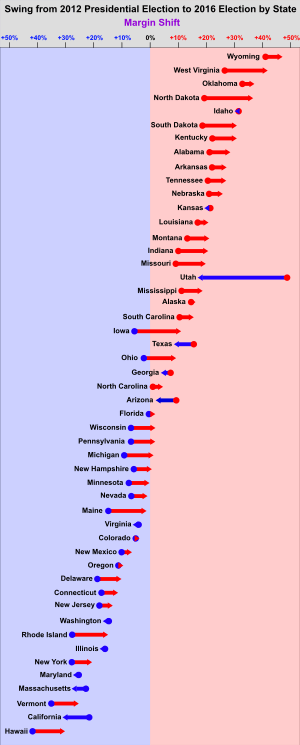
Close races
Red denotes states (or congressional districts whose electoral votes are awarded separately) won by Republican Donald Trump; blue denotes those won by Democrat Hillary Clinton.
States where the margin of victory was under 1% (50 electoral votes; 46 won by Trump, 4 by Clinton):
- Michigan, 0.22% - 16
- New Hampshire, 0.37% - 4
- Pennsylvania, 0.72% - 20 (tipping point state, including 2 faithless Texas GOP electors)[434]
- Wisconsin, 0.76% - 10 (tipping point state, excluding the 2 faithless GOP electors)[434]
States/districts where the margin of victory was between 1% and 5% (83 electoral votes; 56 won by Trump, 27 by Clinton):
- Florida, 1.20% - 29
- Minnesota, 1.52% - 10
- Nebraska's 2nd Congressional District, 2.24% - 1
- Nevada, 2.42% - 6
- Maine, 2.96% - 2
- Arizona, 3.55% - 11
- North Carolina, 3.66% - 15
- Colorado, 4.91% - 9
States where the margin of victory was between 5% and 10% (94 electoral votes; 76 won by Trump, 18 by Clinton):
- Georgia, 5.13% - 16
- Virginia, 5.32% - 13
- Ohio, 8.13% - 18
- New Mexico, 8.21% - 5
- Texas, 9.00% - 36
- Iowa, 9.41% - 6
Breakdown by ticket
| State | Party | Presidential vote | Vice presidential vote | Name of Elector | References |
|---|---|---|---|---|---|
| Nationwide | Donald Trump, 304 | Mike Pence, 305 | Pledged | ||
| Hillary Clinton, 227 | Tim Kaine, 227 | ||||
| Hawaii | Bernie Sanders (I-VT) | Elizabeth Warren (D-MA) | David Mulinix | [435] | |
| Texas | John Kasich (R-OH) | Carly Fiorina (R-VA) | Christopher Suprun | [436][437] | |
| Ron Paul (L-TX / R-TX) | Mike Pence (as pledged) | Bill Greene | [436][438] | ||
| Washington | Colin Powell (R-VA)[442] | Maria Cantwell (D-WA) | Levi Guerra | [443][444] | |
| Susan Collins (R-ME) | Esther John | [104][443] | |||
| Elizabeth Warren (D-MA) | Bret Chiafalo | [104][443] | |||
| Faith Spotted Eagle (D-SD)[445] | Winona LaDuke (G-MN) | Robert Satiacum, Jr. | [104][443][446] |
Battleground states
Most media outlets announced the beginning of the presidential race about twenty months prior to Election Day. Soon after the first contestants declared their candidacy, Larry Sabato listed Virginia, Colorado, Iowa, New Hampshire, Florida, Nevada, and Ohio as the seven states most likely to be contested in the general election. After Donald Trump clinched the Republican presidential nomination, many pundits felt that the major campaign locations might be different from what had originally been expected.[447]
Rust Belt states such as Pennsylvania, Wisconsin, and even Michigan were thought to be in play with Trump as the nominee, while states with large minority populations, such as Colorado and Virginia, were expected to shift towards Clinton.[448] By the conventions period and the debates, however, it did not seem as though the Rust Belt states could deliver a victory to Trump. According to Politico[449] and the 538 online blog, his path to victory went through states such as Florida, North Carolina, Nevada, New Hampshire, and possibly Colorado.[450][451][452][453]
Early polling indicated a closer-than-usual race in former Democratic strongholds such as Washington, Delaware, New Jersey, Connecticut, Maine (for the two statewide electoral votes), and New Mexico.[454][455][456] Meanwhile, research indicators from inside of a host of Republican-leaning states such as Arizona, Indiana, Georgia, South Carolina, Alaska, Utah, Texas, Kansas, Mississippi, Missouri, Montana, and South Dakota reported weaker support for Trump than expected, although the nominee's position solidified in a few other areas. Some reviews took this information as evidence of an expanded 'swing-state map'.[457]
A consensus among political pundits developed throughout the primary election season regarding swing states.[458] From the results of presidential elections from 2004 through to 2012, the Democratic and Republican parties would generally start with a safe electoral vote count of about 150 to 200.[459][460] However, the margins required to constitute a swing state are vague, and can vary between groups of analysts.[461][462] It was thought that left-leaning states in the Rust Belt could become more conservative, as Trump had strong appeal among many blue-collar workers.[463] They represent a large portion of the American populace and were a major factor in Trump's eventual nomination. Trump's primary campaign was propelled by victories in Democratic states, and his supporters often did not identify as Republican.[464] In addition, local factors may come into play. For example, Utah was the reddest state in 2012, although the Republican share was boosted significantly by the candidacy of Mormon candidate Mitt Romney.[461] Despite its partisan orientation, some reports suggested a victory there by independent candidate Evan McMullin, particularly if there was a nationwide blowout.[462]
Media reports indicated that both candidates planned to concentrate on Florida, Pennsylvania, Ohio and North Carolina.[465][466] Among the Republican-leaning states, potential Democratic targets included Nebraska's second congressional district, Georgia, and Arizona.[467] Trump's relatively poor polling in some traditionally Republican states, such as Utah, raised the possibility that they could vote for Clinton, despite easy wins there by recent Republican nominees.[468] However, many analysts asserted that these states were not yet viable Democratic destinations.[469][470] Several sites and individuals publish electoral predictions. These generally rate the race by the likelihood for each party to win a state.[471] The "tossup" label is usually used to indicate that neither party has an advantage, "lean" to indicate a party has a slight edge, "likely" to indicate a party has a clear but not overwhelming advantage, and "safe" to indicate a party has an advantage that cannot be overcome.[472]
As the parameters of the race established themselves, analysts converged on a narrower list of contested states, which were relatively similar to those of recent elections. On November 7, the Cook Political Report categorized Arizona, Colorado, Florida, Iowa, Michigan, Nevada, New Hampshire, North Carolina, Ohio, Pennsylvania, and Wisconsin as states with close races. Additionally, a district from each of Maine and Nebraska were considered to be coin flips.[473] Meanwhile, FiveThirtyEight listed twenty-two states as potentially competitive about a month before the election – Maine's two at-large electoral votes, New Mexico, Minnesota, Michigan, Colorado, Virginia, Wisconsin, Pennsylvania, New Hampshire, Nevada, Florida, North Carolina, Ohio, Iowa, Arizona, Georgia, Alaska, South Carolina, Texas, Indiana, Missouri, and Utah – as well as Maine's second and Nebraska's second congressional districts.[474] Nate Silver, the publication's editor-in-chief, subsequently removed Texas, South Carolina, Missouri, and Indiana from the list after the race tightened significantly.[475] These conclusions were supported by models such as the Princeton Elections Consortium, the New York Times Upshot, and punditry evaluations from Sabato's Crystal Ball and the Cook Political Report.[476][477][478][479]
Clinton won states like New Mexico by less than 10 percentage points.[480] Among the states where the candidates finished at a margin of within 7 percent, Clinton won Virginia (13 electoral votes), Colorado (9), Maine (2), Minnesota (10), and New Hampshire (4). On the other hand, Trump won Michigan (16), Pennsylvania (20), Wisconsin (10), Florida (29), North Carolina (15), Arizona (11), Nebraska's second district (1), and Georgia (16). States won by Obama in the 2012 contest, such as Ohio (18), Iowa (6), and Maine's second district (1), were also won by Trump. The close result in Maine was not expected by most commentators, nor were Trump's victory of over 10 points in the second district and their disparities.[481][482][483] The dramatic shift of Midwestern states towards Trump were contrasted in the media against the relative movement of Southern states towards the Democrats.[484] For example, former Democratic strongholds such as Minnesota, Maine, and Nevada leaned towards the GOP. Meanwhile, Iowa voted more Republican than Texas did, Georgia was more Democratic than Ohio, and the margin of victory for Trump was greater in North Carolina than Arizona.[485][486] Trump's smaller victories in Alaska and Utah also took some experts by surprise.[487]
After the conventions of the national parties, candidates from the main parties carried out trips to the states: Florida - 72, Pennsylvania - 59, North Carolina - 52, Ohio - 43, Virginia - 25, Michigan - 24, Iowa - 23, New Hampshire - 22, Colorado - 19, Nevada - 16, Wisconsin - 15, Arizona - 10.
Maps
 Results by state, shaded according to winning candidate's percentage of the vote
Results by state, shaded according to winning candidate's percentage of the vote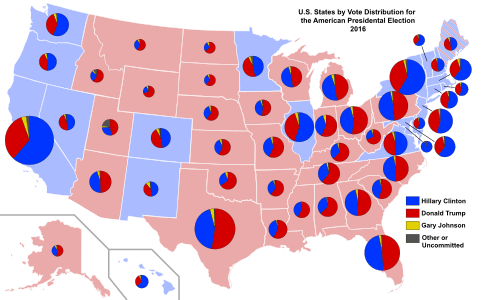 Results by vote distribution among states. The size of each state's pie chart is proportional to its number of electoral votes.
Results by vote distribution among states. The size of each state's pie chart is proportional to its number of electoral votes.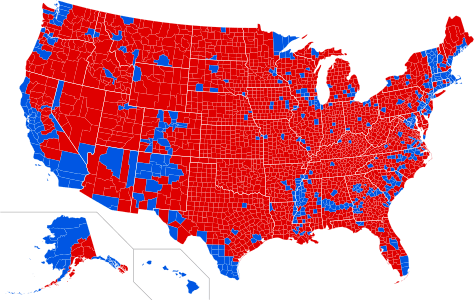 Results by county. Red denotes counties that went to Trump; blue denotes counties that went to Clinton.
Results by county. Red denotes counties that went to Trump; blue denotes counties that went to Clinton.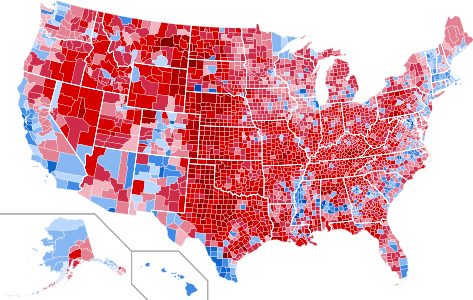 Results by county, shaded according to winning candidate's percentage of the vote
Results by county, shaded according to winning candidate's percentage of the vote.png) Results by county, shaded according to winning candidate's percentage of the vote (Red-Purple-Blue view)
Results by county, shaded according to winning candidate's percentage of the vote (Red-Purple-Blue view)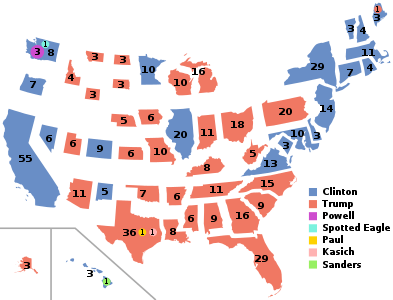 Results by state and DC, scaled by number of Electors per state.
Results by state and DC, scaled by number of Electors per state.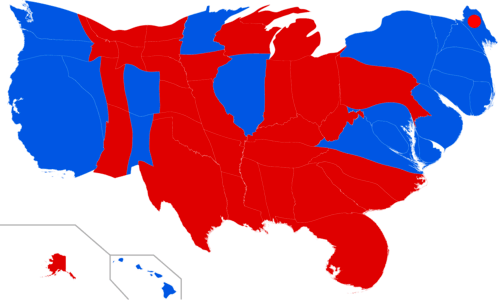 United States presidential election, 2016 cartogram
United States presidential election, 2016 cartogram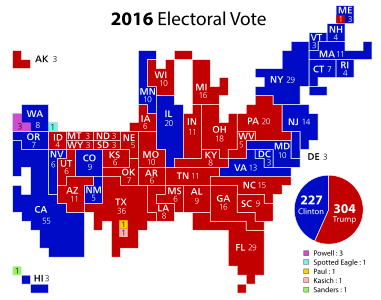 United States presidential election, 2016 cartogram
United States presidential election, 2016 cartogram.svg.png) Results of 2016 U.S. presidential election by congressional district, shaded by vote margin
Results of 2016 U.S. presidential election by congressional district, shaded by vote margin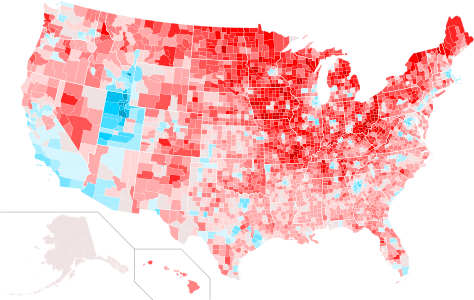 County swing from 2012 to 2016
County swing from 2012 to 2016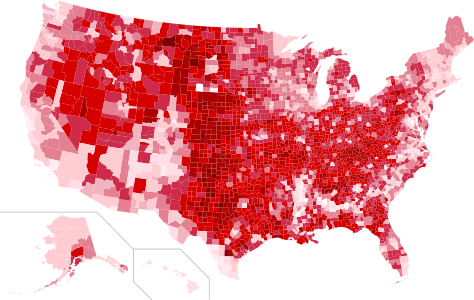 Results by county, shaded according to percentage of the vote for Trump
Results by county, shaded according to percentage of the vote for Trump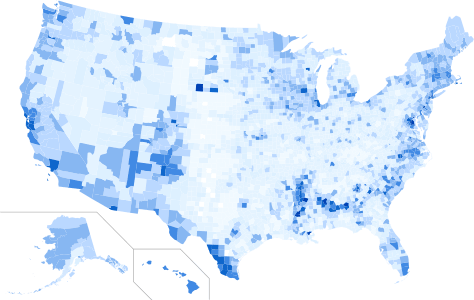 Results by county, shaded according to percentage of the vote for Clinton
Results by county, shaded according to percentage of the vote for Clinton Results by county, shaded according to percentage of the vote for Johnson (0%–10% scale)
Results by county, shaded according to percentage of the vote for Johnson (0%–10% scale)
Voter demographics
Voter demographic data for 2016 were collected by Edison Research for the National Election Pool, a consortium of ABC News, CBS News, MSNBC, CNN, Fox News and the Associated Press. The voter survey is based on exit polls completed by 24,537 voters leaving 350 voting places throughout the United States on Election Day, in addition to 4,398 telephone interviews with early and absentee voters.[488] Trump's crucial victories in the Midwest were aided in large part by his strong margins among non-college whites – while Obama lost those voters by a margin of 10 points in 2012, Clinton lost this group by 20 percent. The election also represented the first time that Republicans performed better among lower-income whites than among affluent white voters.[489] To some analysts' surprise, Trump narrowed Clinton's margin compared to Obama by 7 points among blacks and African-Americans, 8 points among Latinos, and 11 points among Asian-Americans. Meanwhile, Trump increased his lead with non-Hispanic white voters through 1 percent over Mitt Romney's performance, and American Indians, Alaska Natives, and Pacific Islanders shifted their support towards the Republican candidate using the same relative amount.[490] Additionally, although 74 percent of Muslim voters supported Clinton, Trump nearly doubled his support among those voters compared to Mitt Romney, according to the Council on American–Islamic Relations exit poll.[491]
However, "more convincing data"[492] from the polling firm Latino Decisions indicates that Clinton received a higher share of the Hispanic vote, and Trump a lower share, than the Edison exit polls showed. Using wider, more geographically and linguistically representative sampling, Latino Decisions concluded that Clinton won 79% of Hispanic voters (also an improvement over Obama's share in 2008 and 2012), while Trump won only 18% (lower than previous Republicans such as Romney and McCain).[493] Additionally, the 2016 Cooperative Congressional Election Study found that Clinton's share of the Hispanic vote was 1 percentage point higher than Obama's in 2012, while Trump's was 7 percentage points lower than Romney's.[494]
Similarly, a large, multi-lingual study by the Asian American Legal Defense and Education Fund found that Clinton won 79% of Asian-American voters, higher than the Edison exit poll showed, while Trump only won 18%, a decrease from McCain's and Romney's numbers.[495] Furthermore, according to the AALDEF's report, Trump received merely 2% of the Muslim-American vote, whereas Clinton received 97%.[496]
| 2016 Presidential vote by demographic subgroup (Edison Exit Polling) | |||||||
|---|---|---|---|---|---|---|---|
| Demographic subgroup | Clinton | Trump | Other | % of total vote | |||
| Total vote | 48 | 46 | 6 | 100 | |||
| Ideology | |||||||
| Liberals | 84 | 10 | 6 | 26 | |||
| Moderates | 52 | 41 | 7 | 39 | |||
| Conservatives | 15 | 81 | 4 | 35 | |||
| Party | |||||||
| Democrats | 89 | 9 | 2 | 37 | |||
| Republicans | 7 | 90 | 3 | 33 | |||
| Independents | 42 | 48 | 10 | 31 | |||
| Party by gender | |||||||
| Democratic men | 87 | 10 | 3 | 14 | |||
| Democratic women | 90 | 8 | 2 | 23 | |||
| Republican men | 6 | 90 | 2 | 17 | |||
| Republican women | 8 | 89 | 2 | 16 | |||
| Independent men | 37 | 51 | 10 | 17 | |||
| Independent women | 47 | 43 | 7 | 14 | |||
| Gender | |||||||
| Men | 41 | 52 | 7 | 47 | |||
| Women | 54 | 41 | 5 | 53 | |||
| Marital status | |||||||
| Married | 44 | 52 | 4 | 59 | |||
| Unmarried | 55 | 37 | 8 | 41 | |||
| Gender by marital status | |||||||
| Married men | 37 | 58 | 5 | 29 | |||
| Married women | 49 | 47 | 4 | 30 | |||
| Non-married men | 46 | 45 | 9 | 19 | |||
| Non-married women | 62 | 33 | 5 | 23 | |||
| Race/ethnicity | |||||||
| White | 37 | 58 | 5 | 70 | |||
| Black | 88 | 8 | 4 | 12 | |||
| Asian | 65 | 29 | 6 | 4 | |||
| Other | 56 | 37 | 7 | 3 | |||
| Hispanic (of any race) | 65 | 29 | 6 | 11 | |||
| Gender by race/ethnicity | |||||||
| White men | 31 | 63 | 5 | 34 | |||
| White women | 43 | 53 | 3 | 37 | |||
| Black men | 80 | 13 | 6 | 5 | |||
| Black women | 94 | 4 | 2 | 7 | |||
| Latino men (of any race) | 62 | 33 | 4 | 5 | |||
| Latino women (of any race) | 68 | 26 | 5 | 6 | |||
| All other races | 61 | 32 | 5 | 6 | |||
| Religion | |||||||
| Protestant | 37 | 60 | 3 | 27 | |||
| Catholic | 45 | 52 | 3 | 23 | |||
| Mormon | 25 | 61 | 14 | 1 | |||
| Other Christian | 43 | 55 | 2 | 24 | |||
| Jewish | 71 | 24 | 5 | 3 | |||
| Other religion | 58 | 33 | 9 | 7 | |||
| None | 68 | 26 | 6 | 15 | |||
| Religious service attendance | |||||||
| Weekly or more | 40 | 56 | 4 | 33 | |||
| Monthly | 46 | 49 | 5 | 16 | |||
| A few times a year | 48 | 47 | 5 | 29 | |||
| Never | 62 | 31 | 7 | 22 | |||
| White evangelical or born-again Christian | |||||||
| White evangelical or born-again Christian | 16 | 81 | 3 | 26 | |||
| Everyone else | 59 | 35 | 6 | 74 | |||
| Age | |||||||
| 18–24 years old | 56 | 35 | 9 | 10 | |||
| 25–29 years old | 53 | 39 | 8 | 9 | |||
| 30–39 years old | 51 | 40 | 9 | 17 | |||
| 40–49 years old | 46 | 50 | 4 | 19 | |||
| 50–64 years old | 44 | 53 | 3 | 30 | |||
| 65 and older | 45 | 53 | 2 | 15 | |||
| Age by race | |||||||
| Whites 18–29 years old | 43 | 47 | 10 | 12 | |||
| Whites 30–44 years old | 37 | 54 | 9 | 16 | |||
| Whites 45–64 years old | 34 | 62 | 4 | 30 | |||
| Whites 65 and older | 39 | 58 | 3 | 13 | |||
| Blacks 18–29 years old | 85 | 9 | 6 | 3 | |||
| Blacks 30–44 years old | 89 | 7 | 4 | 4 | |||
| Blacks 45–64 years old | 89 | 7 | 4 | 5 | |||
| Blacks 65 and older | 91 | 9 | n/a | 1 | |||
| Latinos 18–29 years old | 68 | 26 | 6 | 3 | |||
| Latinos 30–44 years old | 65 | 28 | 7 | 4 | |||
| Latinos 45–64 years old | 64 | 32 | 4 | 4 | |||
| Latinos 65 and older | 73 | 25 | 2 | 1 | |||
| Others | 61 | 31 | 8 | 6 | |||
| Sexual orientation | |||||||
| LGBT | 78 | 14 | 8 | 5 | |||
| Heterosexual | 47 | 48 | 5 | 95 | |||
| First time voter | |||||||
| First time voter | 56 | 40 | 4 | 10 | |||
| Everyone else | 47 | 47 | 6 | 90 | |||
| Education | |||||||
| High school or less | 45 | 51 | 4 | 18 | |||
| Some college education | 43 | 52 | 5 | 32 | |||
| College graduate | 49 | 45 | 6 | 32 | |||
| Postgraduate education | 58 | 37 | 5 | 18 | |||
| Education by race/ethnicity | |||||||
| White college graduates | 45 | 49 | 4 | 37 | |||
| White no college degree | 28 | 67 | 4 | 34 | |||
| Non-white college graduates | 71 | 23 | 5 | 13 | |||
| Non-white no college degree | 75 | 20 | 3 | 16 | |||
| Education by race/ethnicity/sex | |||||||
| White women with college degrees | 51 | 44 | 5 | 20 | |||
| White men with college degrees | 39 | 53 | 8 | 17 | |||
| White women without college degrees | 34 | 61 | 5 | 17 | |||
| White men without college degrees | 23 | 71 | 6 | 16 | |||
| Non-whites | 74 | 21 | 5 | 29 | |||
| Family income | |||||||
| Under $30,000 | 53 | 41 | 6 | 17 | |||
| $30,000–49,999 | 51 | 42 | 7 | 19 | |||
| $50,000–99,999 | 46 | 50 | 4 | 31 | |||
| $100,000–199,999 | 47 | 48 | 5 | 24 | |||
| $200,000–249,999 | 48 | 49 | 3 | 4 | |||
| Over $250,000 | 46 | 48 | 6 | 6 | |||
| Union households | |||||||
| Union | 51 | 42 | 7 | 18 | |||
| Non-union | 46 | 48 | 6 | 82 | |||
| Military service | |||||||
| Veterans | 34 | 60 | 6 | 13 | |||
| Non-veterans | 50 | 44 | 6 | 87 | |||
| Issue regarded as most important | |||||||
| Foreign policy | 60 | 34 | 6 | 13 | |||
| Immigration | 32 | 64 | 4 | 13 | |||
| Economy | 52 | 42 | 6 | 52 | |||
| Terrorism | 39 | 57 | 4 | 18 | |||
| Region | |||||||
| Northeast | 55 | 40 | 5 | 19 | |||
| Midwest | 45 | 49 | 6 | 23 | |||
| South | 44 | 52 | 4 | 37 | |||
| West | 55 | 39 | 6 | 21 | |||
| Community size | |||||||
| Cities (population 50,000 and above) | 59 | 35 | 6 | 34 | |||
| Suburbs | 45 | 50 | 5 | 49 | |||
| Rural areas | 34 | 62 | 4 | 17 | |||
Forecasting
Various methods were used to forecast the outcome of the 2016 election.[497] For the 2016 election, there were many competing election forecast approaches including Nate Silver's FiveThirtyEight, The Upshot at The New York Times, Daily Kos, Princeton Election Consortium, Cook Political Report, Rothenberg and Gonzales, PollyVote, Sabato's Crystal Ball and Electoral-Vote. These models mostly showed a Democratic advantage since the nominees were confirmed, and were supported by pundits and statisticians, including Nate Silver of FiveThirtyEight, Nate Cohn at The New York Times, and Larry Sabato from the Crystal Ball newsletter, who predicted a Democratic victory in competitive presidential races and projected consistent leads in several battleground states around the country.[498] The near-unanimity of forecasters in predicting a Clinton victory may have been the result of groupthink. However, FiveThirtyEight's model pointed to the possibility of an Electoral College-popular vote split widening in the final weeks based on Trump's improvement in swing states like Florida or Pennsylvania. This was due to the demographics targeted by Trump's campaign which lived in big numbers there, in addition to Clinton's poor performance in several of those swing states in comparison with Obama's performance in 2012, as well as having a big number of her potential voters in very populated traditionally 'blue' states, but also in some very populated states traditionally 'red', like Texas, which were projected safe for Trump.[499]
Early exit polls generally favored Clinton.[500] After the polls closed and some of the results came in, the forecasts were found to be inaccurate, as Trump performed better in the competitive Midwestern states, such as Iowa, Ohio, and Minnesota, than expected. Three states (Pennsylvania, Wisconsin and Michigan) which were considered to be part of Clinton's firewall, were won by Trump.[500] Of the states in the Great Lakes region, Clinton won the swing state of Minnesota by 1 point, as well as traditional Democratic strongholds such as New York and Illinois with populous urban centers. This result stands in contrast to the 2012 results, when President Obama won all but Indiana, which he carried in 2008. This table displays the final polling average published by Real Clear Politics on November 7, the actual electoral margin, and the over-performance by either candidate relative to the polls.
| State | Electoral votes | Polling average | Final result | Difference |
|---|---|---|---|---|
| Arizona | 11 | Trump +4[501] | Trump +3.5 | Clinton +0.5 |
| Colorado | 9 | Clinton +2.9[502] | Clinton +4.9 | Clinton +2 |
| Florida | 29 | Trump +0.2[503] | Trump +1.2 | Trump +1 |
| Georgia | 16 | Trump +4.8[504] | Trump +5.1 | Trump +0.3 |
| Iowa | 6 | Trump +3[505] | Trump +9.5 | Trump +6.5 |
| Maine | 4 | Clinton +4.5[506] | Clinton +2.9 | Trump +1.6 |
| Michigan | 16 | Clinton +3.4[507] | Trump +0.3 | Trump +3.7 |
| Minnesota | 10 | Clinton +6.2[508] | Clinton +1.5 | Trump +4.7 |
| Nevada | 6 | Trump +0.8[509] | Clinton +2.4 | Clinton +3.2 |
| New Hampshire | 4 | Clinton +0.6[510] | Clinton +0.3 | Trump +0.3 |
| New Mexico | 5 | Clinton +5[511] | Clinton +8.3 | Clinton +3.3 |
| North Carolina | 15 | Trump +1[512] | Trump +3.7 | Trump +2.7 |
| Ohio | 18 | Trump +3.5[513] | Trump +8.1 | Trump +4.6 |
| Pennsylvania | 20 | Clinton +1.9[514] | Trump +0.7 | Trump +2.6 |
| Virginia | 13 | Clinton +5[515] | Clinton +5.4 | Clinton +0.4 |
| Wisconsin | 10 | Clinton +6.5[516] | Trump +0.7 | Trump +7.2 |
Many pollsters were puzzled by the failure of mainstream forecasting models to predict the outcome of the 2016 election.[517][518] Some journalists compared the 2016 election to the failure of prognosticator Arthur Henning in the "Dewey Defeats Truman" incident from the 1948 presidential election.[519][520] Sean Trende, writing for RealClearPolitics, wrote that many of the polls were accurate, but that the pundits' interpretation of these polls neglected polling error.[521] Nate Silver found that the high number of undecided and third-party voters in the election was neglected in many of these models, and that many of these voters decided to vote for Trump.[522] According to a February 2018 study by Public Opinion Quarterly, the main sources of polling error were "a late swing in vote preference toward Trump and a pervasive failure to adjust for over-representation of college graduates (who favored Clinton)," whereas the share of "shy" Trump voters (who declined to admit their support for Trump to the pollsters) proved to be negligible.[523]
FiveThirtyEight's final polls-plus forecast predicted 18 states, plus the second congressional districts of Maine and Nebraska, with an interval of confidence lower than 90%.[524][525] However, every major forecaster, including FiveThirtyEight, the New York Times Upshot, prediction markets aggregator PredictWise, ElectionBettingOdds from Maxim Lott and John Stossel, the DailyKos, the Princeton Election Consortium, the Huffington Post, the Cook Political Report, Larry Sabato's Crystal Ball, and the Rothenberg and Gonzales Report, called every state the same way (although Cook and Rothenberg-Gonzales left two and five states as toss-ups, respectively). The sole exception was Maine's 2nd congressional district. Of the forecasters who published results on the district, the Times gave Trump a 64% chance of winning and PredictWise a 52% chance, FiveThirtyEight gave Clinton a 51% chance of winning in polls-only and 54% in polls-plus, Princeton gave her a 60% chance, Cook labelled it a toss-up, and Sabato leaned it towards Trump.[104] The following table displays the final winning probabilities given by each outlet, along with the final electoral result. The states shown have been identified by Politico,[526] WhipBoard,[527] the New York Times,[528] and the Crystal Ball as battlegrounds.
| State | New York Times Upshot[528] | FiveThirtyEight[528] | PredictWise[528] | Princeton Election Consortium[528] | Sabato's Crystal Ball[528] | 2012 margin | 2016 margin |
|---|---|---|---|---|---|---|---|
| Alaska | 83% R | 76% R | 94% R | 96% R | Likely R | 14 R | 15 R |
| Arizona | 84% R | 67% R | 82% R | 91% R | Lean R | 9 R | 4 R |
| Colorado | 89% D | 78% D | 95% D | 96% D | Likely D | 5 D | 5 D |
| Florida | 67% D | 55% D | 77% D | 69% D | Lean D | 1 D | 1 R |
| Georgia | 83% R | 79% R | 91% R | 88% R | Likely R | 8 R | 6 R |
| Iowa | 62% R | 70% R | 79% R | 74% R | Lean R | 6 D | 10 R |
| Maine (statewide) | 91% D | 83% D | 98% D | 98% D | Likely D | 15 D | 3 D |
| Maine (CD-2) | 64% R | 51% D | 52% R | 60% D | Lean R | 9 D | 10 R |
| Michigan | 94% D | 79% D | 95% D | 79% D | Lean D | 9 D | 1 R |
| Minnesota | 94% D | 85% D | 99% D | 98% D | Likely D | 8 D | 2 D |
| Nebraska (CD-2) | 80% R | 56% R | 75% R | 92% R | Lean R | 7 R | 3 R |
| New Mexico | 95% D | 83% D | 98% D | 91% D | Likely D | 10 D | 8 D |
| Nevada | 68% D | 58% D | 91% D | 84% D | Lean D | 7 D | 2 D |
| New Hampshire | 79% D | 70% D | 84% D | 63% D | Lean D | 6 D | 1 D |
| North Carolina | 64% D | 56% D | 66% D | 67% D | Lean D | 2 R | 4 R |
| Ohio | 54% R | 65% R | 67% R | 63% R | Lean R | 3 D | 9 R |
| Pennsylvania | 89% D | 77% D | 93% D | 79% D | Lean D | 5 D | 1 R |
| Utah | 73% R | 83% R | 86% R | 99% R | Lean R | 48 R | 18 R |
| Virginia | 96% D | 86% D | 98% D | 98% D | Likely D | 4 D | 5 D |
| Wisconsin | 93% D | 84% D | 98% D | 98% D | Likely D | 7 D | 1 R |
Viewership
|
Legend[529]
|
Total television viewers
|
Total cable TV viewers
|
Cable TV viewers 25 to 54
|
Post-election events and controversies
Trump's victory, considered unlikely by most forecasts,[530][531][532][533][534] was characterized as an "upset" and as "shocking" by the media.[535][536][537][538]
Protests
Following the announcement of Trump's election, large protests broke out across the United States with some continuing for several days.[539][540][541][542]
Protesters have held up a number of different signs and chanted various shouts including "Not my president" and "We don't accept the president-elect".[438][539] The movement organized on Twitter under the hashtags #Antitrump and #NotMyPresident.[543][544]
High school and college students walked out of classes to protest.[545] The protests were peaceful for the most part. At some protests fires were lit, flags and other items were burned and people yelled derogatory remarks about Trump. Rioters also broke glass at certain locations.[546][547][548] Celebrities such as Madonna, Cher, and Lady Gaga took part in New York.[549][550][551] Some protesters took to blocking freeways in Los Angeles, San Diego, and Portland, Oregon, and were dispersed by police in the early hours of the morning.[552][553] In a number of cities, protesters were dispersed with rubber bullets, pepper spray and bean-bags fired by police.[554][555][556] In New York City, calls were made to continue the protests over the coming days after the election.[557] Former New York mayor Rudy Giuliani called protesters "a bunch of spoiled cry-babies."[558] Los Angeles mayor Eric Garcetti expressed understanding of the protests and praised those who peacefully wanted to make their voices heard.[559]
Vote tampering concerns
After the election, computer scientists, including J. Alex Halderman, the director of the University of Michigan Center for Computer Security and Society, urged the Clinton campaign to request an election recount in Wisconsin, Michigan, and Pennsylvania (three swing states where Trump had won narrowly) for the purpose of excluding the possibility that the hacking of electronic voting machines had influenced the recorded outcome.[560][561][562] However, statistician Nate Silver performed a regression analysis which demonstrated that the alleged discrepancy between paper ballots and electronic voting machines "completely disappears once you control for race and education level".[563] On November 25, 2016, the Obama administration said the results from November 8 "accurately reflect the will of the American people."[564] The following day, the White House released another statement, saying: "the federal government did not observe any increased level of malicious cyberactivity aimed at disrupting our electoral process on Election Day."[565]
Recount petitions
On November 23, Green Party presidential candidate Jill Stein launched a public fundraiser to pay for recounts in Wisconsin, Michigan, and Pennsylvania, asserting that the election's outcome had been affected by hacking in those states; Stein did not provide evidence for her claims.[566][567] Changing the outcome of these three states would make Clinton the winner, and this would require showing that fewer than 60 000 votes had been counted for Trump which should have been counted for Clinton. Stein filed for a recount in Wisconsin on November 25,[568] after which Clinton campaign general counsel Marc Elias stated that their campaign would join Stein's recount efforts in that state and possibly others "in order to ensure the process proceeds in a manner that is fair to all sides."[373][569] Stein subsequently filed for a recount in Pennsylvania on November 28,[570] and in Michigan on November 30.[571] Concurrently, American Delta Party/Reform Party presidential candidate Rocky De La Fuente sought and was granted a partial recount in Nevada that was unrelated to Stein's efforts.[375]
President-elect Donald Trump issued a statement denouncing Stein's Wisconsin recount request saying, "The people have spoken and the election is over." Trump further commented that the recount "is a scam by the Green Party for an election that has already been conceded."[572] The Trump campaign and Republican Party officials moved to block Stein's three recount efforts through state and federal courts.[573][574]
U.S. District Judge Mark Goldsmith ordered a halt to the recount in Michigan on December 7, dissolving a previous temporary restraining order against the Michigan Board of Elections that allowed the recount to continue, stating in his order: "Plaintiffs have not presented evidence of tampering or mistake. Instead, they present speculative claims going to the vulnerability of the voting machinery – but not actual injury."[575] On December 12, U.S. District Judge Paul Diamond rejected an appeal by the Green Party and Jill Stein to force a recount in Pennsylvania, stating that suspicion of a hacked Pennsylvania election "borders on the irrational" and that granting the Green Party's recount bid could "ensure that no Pennsylvania vote counts" given the December 13, 2016, federal deadline to certify the vote for the Electoral College.[576] Meanwhile, the Wisconsin recount was allowed to continue as it was nearing completion and had uncovered no significant irregularities.[577]
The recounts in Wisconsin and Nevada were completed on schedule, resulting in only minor changes to vote tallies.[578][579] A partial recount of Michigan ballot found some precinct imbalances in Detroit, which were corrected. A subsequent state audit found no evidence of voter fraud and concluded that the mistakes, which were "almost entirely" caused by poll-worker mistakes attributed to poor training, did not impair "the ability of Detroit residents to cast a ballot and have their vote counted."[580] The overall outcome of the election remained unchanged by the recount efforts.[578][579][581]
Electoral College lobbying
Intense lobbying (in one case involving claims of harassment and death threats[582]) and grass-roots campaigns have been directed at various GOP electors of the United States Electoral College[583] to convince a sufficient number of them (37) to not vote for Trump, thus precluding a Trump presidency.[584] Members of the Electoral College themselves started a campaign for other members to "vote their conscience for the good of America" in accordance with Alexander Hamilton's Federalist Paper No. 68.[585][586][587][588] This group's members may have become faithless electors in the presidential election.
On December 5, former candidate Lawrence Lessig and attorney Laurence Tribe established The Electors Trust under the aegis of EqualCitizens.US to provide pro bono legal counsel as well as a secure communications platform for members of the Electoral College who are regarding a vote of conscience against Trump.[589]
On December 6, Colorado Secretary of State Wayne W. Williams castigated Democratic electors who had filed a lawsuit in Federal court to have the state law binding them to the popular vote (in their case for Hillary Clinton) overturned.[590]
On December 10, ten electors, in an open letter headed by Christine Pelosi to the Director of National Intelligence James Clapper, demanded an intelligence briefing[591][592] in light of Russian interference in the election to help Trump win the presidency.[593] Fifty-eight additional electors subsequently added their names to the letter,[592] bringing the total to 68 electors from 17 different states.[594] On December 16, the briefing request was denied.[595]
On December 19, several electors voted against their pledged candidates: two against Trump and five against Clinton. A further three electors attempted to vote against Clinton but were replaced or forced to vote again.
The 115th United States Congress officially certified the results on January 6, 2017.[596][597]
Faithless electors
In the Electoral College vote on December 19, for the first time since 1808, multiple faithless electors voted against their pledged qualified presidential candidate.[lower-alpha 4] Five Democrats rebelled in Washington and Hawaii, while two Republicans rebelled in Texas.[598] Two Democratic electors, one in Minnesota and one in Colorado, were replaced after voting for Bernie Sanders and John Kasich, respectively.[599][600] Electors in Maine conducted a second vote after one of its members voted for Sanders; the elector then voted for Clinton.[601]
Likewise, for the first time since 1896,[lower-alpha 5] multiple faithless electors voted against the pledged qualified vice presidential candidate.
- One Clinton elector in Colorado attempted to vote for John Kasich.[602] The single vote was ruled invalid by Colorado state law, the elector was dismissed, and an alternative elector was sworn in who voted for Clinton.[603][600]
- One Clinton elector in Minnesota voted for Bernie Sanders as President and Tulsi Gabbard as vice president; his votes were discarded and he was replaced by an alternate who voted for Clinton.[603]
- One Clinton elector in Maine voted for Bernie Sanders; this vote was invalidated as "improper" and the elector subsequently voted for Clinton.[603]
- Four Clinton electors in Washington did not vote for Clinton (three votes went to Colin Powell, and one to Faith Spotted Eagle).[604]
- One Trump elector in Georgia resigned before the vote rather than vote for Trump and was replaced by an alternate.[605]
- Two Trump electors in Texas did not vote for Trump (one vote went to John Kasich, one to Ron Paul); one elector did not vote for Pence and instead voted for Carly Fiorina for Vice-President; a third resigned before the vote rather than vote for Trump and was replaced by an alternate.[604]
- One Clinton elector in Hawaii voted for Bernie Sanders.[606]
Of the faithless votes, Colin Powell and Elizabeth Warren were the only two to receive more than one; Powell received three electoral votes for President and Warren received two for Vice President. Receiving one valid electoral vote each were Sanders, John Kasich, Ron Paul and Faith Spotted Eagle for President, and Carly Fiorina, Susan Collins, Winona LaDuke and Maria Cantwell for Vice President. Sanders is the first Jewish American to receive an electoral vote for President. LaDuke is the first Green Party member to receive an electoral vote, and Paul is the third member of the Libertarian Party to do so, following the party's presidential and vice-presidential nominees each getting one vote in 1972. It is the first election with faithless electors from more than one political party. The seven people to receive electoral votes for president were the most in a single election since 1796, and more than any other election since the enactment of the Twelfth Amendment in 1804.
See also
Notes
- 1 2 3 In state-by-state tallies, Trump earned 306 pledged electors, Clinton 232. They lost respectively two and five votes to faithless electors. Pence and Kaine lost one and five votes, respectively.
- ↑ In early elections, beginning with the election of George Washington, many electors were chosen by state legislatures instead of public balloting and, in those states which practiced public balloting, votes were cast for undifferentiated lists of candidates, leaving no or only partial vote totals. Some states continued to allocate electors by legislative vote as late as 1876.[16]
- 1 2 3 4 Maine split its electoral votes for the first time since 1828.[431]
- ↑ The 1872 presidential election also saw multiple electors vote for a different candidate than that pledged, due to the death of Liberal Republican candidate Horace Greeley, after the popular vote, yet before the meeting of the Electoral College. Greeley still garnered three posthumous electoral votes which were subsequently dismissed by Congress.
- ↑ Not 1912, because James S. Sherman was dead.
References
- 1 2 3 4 ("Official 2016 Presidential General Election Results" (PDF). Federal Election Commission. December 2017. Retrieved February 12, 2018. ) ("Voting and Registration in the Election of November 2016". United States Census Bureau. May 2017. Retrieved November 10, 2017. )
- ↑ Larry Sabato; Kyle Kondik; Geoffrey Skelley (2017). Trumped: The 2016 Election That Broke All the Rules. Rowman & Littlefield. p. 7. ISBN 9781442279407.
- ↑ Chozick, Amy (March 4, 2016). "Clinton Offers Economic Plan Focused on Jobs". The New York Times. Retrieved March 8, 2018.
- ↑ Becker, Bernie (February 13, 2016). "Trump's 6 populist positions". Politico. Retrieved March 8, 2018.
- ↑ Wallace, Gregory (November 8, 2016). "Negative ads dominate in campaign's final days". CNN. Retrieved March 8, 2018.
- ↑ Cassidy, John (November 5, 2016). "Closing Arguments: The Logic of Negative Campaigning". The New Yorker. Retrieved March 8, 2018. - "This Presidential campaign has been the most bitter in recent American history."
- ↑ Pew Research Center (November 21, 2016). "Voters’ evaluations of the campaign: Campaign viewed as heavy on negative campaigning, light on issues". Retrieved March 8, 2018
- ↑ Tiefenthaler, Ainara (March 14, 2016). "Trump's History of Encouraging Violence". The New York Times. Retrieved November 8, 2016.
- ↑ Nguyen, Tina (March 11, 2016). "Donald Trump's Rallies Are Becoming Increasingly Violent". Vanity Fair. Retrieved March 12, 2016.
- ↑ Jacobs, Ben (March 11, 2016). "Trump campaign dogged by violent incidents at rallies". The Guardian. Retrieved March 12, 2016.
- ↑ Nicholas Confessore & Karen Yourish, "Measuring Donald Trump's Mammoth Advantage in Free Media", The New York Times (March 16, 2016).
- ↑ Walsh, Kenneth. "How Donald Trump's Media Dominance Is Changing the 2016 Campaign". US News & World Report. Archived from the original on February 25, 2016. Retrieved February 17, 2016.
- ↑ Gallup News (July 25, 2016). "Clinton's Image at Lowest Point in Two Decades". Retrieved March 8, 2018.
- ↑ Grossman, Ron (November 11, 2016). "Flashback: It's happened before: Truman's defeat of Dewey had hints of Trump-Clinton". www.chicagotribune.com. Chicago Tribune. Retrieved December 3, 2017.
- ↑ Stone, Roger (February 15, 2017). "Trump Stole a Page From "Give 'Em Hell" Harry". www.realclearpolitics.com. RealClearPolitics. Retrieved December 3, 2017.
- ↑ Moore, John L., ed. (1985). Congressional Quarterly's Guide to U.S. Elections (2nd ed.). Washington, D.C.: Congressional Quarterly, Inc. p. 266.
- ↑ "Did Clinton win more votes than any white man in history?". BBC News. 2016-12-12. Retrieved 2018-09-09.
- ↑ Miller, Greg; Entous, Adam. "Declassified report says Putin 'ordered' effort to undermine faith in U.S. election and help Trump". The Washington Post.
- ↑ Fleitz, Fred (January 7, 2017). "Was Friday's declassified report claiming Russian hacking of the 2016 election rigged?". Fox News.
- ↑ Eichenwald, Kurt (January 10, 2017). "Trump, Putin and the hidden history of how Russia interfered in the U.S. presidential election". Newsweek.
- ↑ "Intelligence Report on Russian Hacking". The New York Times. January 6, 2017. p. 11. Retrieved January 8, 2017.
- ↑ "Trump's response on Russia issue called the 'most suspicious' part of his presidency". AOL.com. April 1, 2017. Retrieved December 19, 2017.
- ↑ Watkins, Eli; Acosta, Jim (May 9, 2017). "WH highlights Clapper's lack of evidence on Trump-Russia collusion". CNN. Retrieved December 19, 2017.
- ↑ Rosenberg, Matthew; Huetteman, Emmarie; Schmidt, Matthew S. (March 20, 2017). "Comey Confirms F.B.I. Inquiry on Russia; Sees No Evidence of Wiretapping". The New York Times. Retrieved December 19, 2017.
- ↑ Julian Borger & Spencer Ackerman, Trump-Russia collusion is being investigated by FBI, Comey confirms, The Guardian (March 20, 2017).
- 1 2 Carney, Jordain (January 24, 2017). "Senate committee moving forward with Russia hacking probe". The Hill. Retrieved March 4, 2017.
- ↑ Wright, Austin (January 25, 2017). "Second Hill panel to probe possible ties between Russia, Trump campaign". Politico. Retrieved February 28, 2017.
- ↑ Rosenstein, Rod (May 17, 2017). "Rod Rosenstein's Letter Appointing Mueller Special Counsel". The New York Times. Retrieved November 3, 2017.
- ↑ Amira, Dan (November 8, 2012). "Let the 2016 Campaign Season Begin!". New York. Retrieved July 5, 2015.
- ↑ Martin, Johnathon; Haberman, Maggie (November 8, 2012). "Back to the future: Clinton vs. Bush?". Politico. Retrieved March 22, 2017.
- ↑ Barbaro, Micharl (November 8, 2012). "After Obama, Christie Wants a G.O.P. Hug". The New York Times. Retrieved July 5, 2015.
- ↑ Linshi, Jack (July 7, 2015). "More People Are Running for Presidential Nomination Than Ever". Time. Retrieved February 14, 2016.
- ↑ Rafferty, Andrew (March 4, 2016). "Ben Carson Suspends 2016 Campaign at CPAC". NBC News. Retrieved March 9, 2016.
- ↑ Peters, Jeremy; Barbaro, Michael (March 16, 2016). "Marco Rubio Suspends His Presidential Campaign". The New York Times. Retrieved March 16, 2016.
- ↑ Rosenfeld, Everett (May 3, 2016). "Ted Cruz suspends presidential campaign". CNBC. Retrieved May 4, 2016.
- ↑ Kaplan, Thomas (May 4, 2016). "John Kasich Drops Out of Presidential Race". The New York Times. ISSN 0362-4331. Retrieved May 4, 2016.
- ↑ "Reince Priebus on Twitter". Twitter. May 3, 2016. Retrieved November 13, 2016.
.@realDonaldTrump will be presumptive @GOP nominee, we all need to unite...
- ↑ "Donald Trump is running for president". Business Insider. June 16, 2015. Retrieved June 16, 2015.
- ↑ "Donald Trump announces presidential bid". The Washington Post. June 16, 2015. Retrieved June 16, 2015.
- ↑ "Donald Trump FEC filing" (PDF). FEC.gov. June 22, 2015. Retrieved June 24, 2015.
- ↑ "John Kasich FEC Filing" (PDF). FEC.gov. July 23, 2015. Retrieved July 28, 2015.
- ↑ Mascaro, Lisa; Lauter, David (March 22, 2015). "Texas Republican Sen. Ted Cruz Launches Presidential Bid". Los Angeles Times. Retrieved March 23, 2015.
- ↑ Zezima, Katie (March 23, 2015). "Ted Cruz Announces He's Running for President". The Washington Post. Retrieved March 23, 2015.
- ↑ "Ted Cruz FEC filing" (PDF). FEC.gov. March 23, 2015. Retrieved April 1, 2015.
- ↑ Parker, Ashley (April 13, 2015). "Marco Rubio Announces 2016 Presidential Bid". The New York Times. Retrieved April 13, 2015.
- ↑ Nelson, Rebecca (April 13, 2015). "Marco Rubio Makes His Pitch as the Fresh Face of the GOP in 2016". National Journal. Retrieved April 14, 2015.
- ↑ "Marco Rubio FEC Filing" (PDF). FEC.gov. April 13, 2015. Retrieved May 7, 2015.
- ↑ Terris, Ben (May 3, 2015). "Ben Carson announces presidential campaign". The Washington Post. Retrieved May 4, 2015.
- ↑ Rafferty, Andrew (May 4, 2015). "Ben Carson Announces 2016 Run". NBCNews.com. Retrieved May 4, 2015.
- ↑ "Ben Carson FEC Filing" (PDF). FEC.gov. May 4, 2015. Retrieved May 7, 2015.
- ↑ Rafferty, Andrew (June 15, 2015). "Jeb Bush Makes 2016 Run Official". NBC News. Retrieved June 15, 2015.
- ↑ "Jeb Bush FEC Filing" (PDF). FEC.gov. June 15, 2015. Retrieved June 16, 2015.
- ↑ Allen, Cooper (July 30, 2015). "Jim Gilmore formally joins GOP presidential race". USA Today. Retrieved July 30, 2015.
- ↑ "Jim Gilmore FEC Filing" (PDF). FEC.gov. July 29, 2015. Retrieved July 29, 2015.
- ↑ Gass, Nick (May 4, 2015). "Carly Fiorina: 'Yes, I am running for president'". Politico. Retrieved May 4, 2015.
- ↑ "Carly Fiorina FEC Filing" (PDF). FEC.gov. May 4, 2015. Retrieved May 7, 2015.
- ↑ Barbaro, Michael (June 30, 2015). "Chris Christie Announces Run, Pledging 'Truth' About Nation's Woes". The New York Times. Retrieved June 30, 2015.
- ↑ "Christopher J. Christie FEC Filing" (PDF). FEC.gov. July 1, 2015. Retrieved July 6, 2015.
- ↑ Lambert, Lisa (April 7, 2015). "Republican Rand Paul announces 2016 presidential run on website". Reuters. Retrieved April 7, 2015.
- ↑ Killough, Ashley (April 7, 2015). "Rand Paul: 'I am running for president'". CNN. Retrieved April 7, 2015.
- ↑ "Rand Paul FEC filing" (PDF). FEC.gov. April 8, 2015. Retrieved April 9, 2015.
- ↑ Jackson, David (May 27, 2015). "Santorum officially begins 2016 presidential campaign". USA Today. Retrieved May 28, 2015.
- ↑ "Rick Santorum FEC filing" (PDF). FEC.gov. May 27, 2015. Retrieved June 1, 2015.
- ↑ Trip, Gabriel (May 5, 2015). "Mike Huckabee Joins Republican Presidential Race". The New York Times. Retrieved May 5, 2015.
- ↑ "Mike Huckabee FEC Filing" (PDF). FEC.gov. Retrieved May 10, 2015.
- ↑ "George Pataki FEC filing" (PDF). FEC.gov. June 2, 2015. Retrieved June 4, 2015.
- ↑ Jaffe, Alexandra (June 1, 2015) "Graham bets on foreign experience in White House bid announcement", CNN. Retrieved June 1, 2015.
- ↑ "Lindsey Graham FEC Filing" (PDF). FEC.gov. June 1, 2015. Retrieved June 2, 2015.
- ↑ Fahrenthold, David A.; Hohmann, James (June 24, 2015). "Bobby Jindal announces entry into 2016 presidential race". The Washington Post. Retrieved June 24, 2015.
- ↑ "Bobby Jindal FEC Filing" (PDF). FEC.gov. June 29, 2015. Retrieved June 30, 2015.
- ↑ Burlij, Terence; Lee, MJ; LoBianco, Tom (July 13, 2015). "Wisconsin Gov. Scott Walker officially enters 2016 presidential race". CNN. Retrieved July 13, 2015.
- ↑ "Scott Walker FEC filing". FEC. FEC.gov. Retrieved July 13, 2015.
- 1 2 "2016 Presidential Primary – Republican President – NHSOS". sos.nh.gov. Retrieved October 9, 2016.
- ↑ Beckwith, Ryan Teague; Rhodan, Maya (June 4, 2015). "Rick Perry Announces Presidential Bid". Time. Retrieved June 4, 2015.
- ↑ "Rick Perry FEC filing" (PDF). FEC.gov. June 19, 2015. Retrieved June 22, 2015.
- ↑ Keneally, Meghan (May 4, 2016). "Donald Trump Teases Possible VP Requirements". ABC News. Retrieved May 4, 2016.
- ↑ Stokols, Eli; Everett, Burgess (June 17, 2016). "Trump's performance raises hard question: Who'd want to be his VP?". Politico. Retrieved June 21, 2016.
- ↑ Costa, Robert (June 30, 2016). "Gingrich, Christie are the leading candidates to be Trump's running mate". The Washington Post. Retrieved July 1, 2016.
- ↑ Zurcher, Anthony (July 8, 2016). "US election: Who will Trump pick as his vice-president?". BBC. Retrieved July 8, 2016.
- ↑ O'Donnell, Kelly (July 12, 2016). "Team Trump Plans Public Event Friday With VP Pick". NBC News. Retrieved July 12, 2016.
- ↑ Bash, Dana; Acosta, Jim; Lee, MJ (July 14, 2016). "Donald Trump selects Mike Pence as VP". CNN. Retrieved July 14, 2016.
- ↑ Levingston, Ivan (July 15, 2016). "Donald Trump officially names Mike Pence as his VP". CNBC. Retrieved July 16, 2016.
- ↑ Cook, Tony (July 19, 2016). "Gov. Mike Pence formally nominated as the Republican Party's vice presidential candidate". The Indianapolis Star. Retrieved July 20, 2016.
- ↑ Keith, Tamara; Montanar, Domenico (April 10, 2015). "Hillary Clinton Expected To Go Small With Big Announcement". NPR. Retrieved April 12, 2015.
- 1 2 "Second straight poll shows Bernie Sanders leading in New Hampshire". Boston Globe. Retrieved August 26, 2015.
- ↑ Merica, Dan (April 30, 2015). "Bernie Sanders is running for president". CNN. Retrieved July 6, 2015.
- ↑ "Bernie Sanders surpasses Hillary Clinton in New Hampshire polls". The Huffington Post. August 25, 2015. Retrieved August 25, 2015.
- ↑ "Huffpost Pollster". The Huffington Post. October 1, 2015. Retrieved October 1, 2015.
- ↑ Jackson, David; Cooper, Allen (May 30, 2015). "Martin O'Malley jumps into presidential race". USA Today. Retrieved May 30, 2015.
- ↑ DelReal, Jose A. (June 3, 2015). "Lincoln Chafee announces long-shot presidential bid". The Washington Post. Retrieved June 3, 2015.
- ↑ "Rhode Island's Chafee enters 2016 Democratic contest". Boston Herald. Associated Press. June 3, 2015. Retrieved June 3, 2015.
- ↑ Catanese, David (July 2, 2015). "Jim Webb Announces For President". U.S. News & World Report. Archived from the original on July 3, 2015. Retrieved July 2, 2015.
- ↑ Meyer, Theodoric (September 6, 2015). "Lessig: I'm running for president". Slate. Retrieved September 7, 2015.
- ↑ "Jim Webb to consider running as an independent". Politico. Retrieved October 25, 2015.
- ↑ "Biden says he's not running in 2016". OnPolitics. Retrieved October 25, 2015.
- ↑ "Joe Biden Not Running for President". ABC News. October 21, 2015. Retrieved October 25, 2015.
- ↑ Wagner, John; Weigel, David (October 23, 2015). "Lincoln Chafee ends Democratic bid for president". The Washington Post. ISSN 0190-8286. Retrieved October 25, 2015.
- 1 2 Strauss, Daniel (November 2, 2015). "Lessig drops out of presidential race". Politico. Retrieved November 2, 2015.
- ↑ "Nevada Caucus Results". The New York Times. Retrieved February 28, 2016.
- ↑ "South Carolina Primary Results". The New York Times. Retrieved February 28, 2016.
- ↑ "Why The Polls Missed Bernie Sanders's Michigan Upset". FiveThirtyEight. March 9, 2016. Retrieved May 1, 2016.
- ↑ Roberts, Dan; Jacobs, Ben (May 4, 2016). "Bernie Sanders pulls off shock victory over Hillary Clinton in Indiana". The Guardian. Retrieved May 4, 2016.
- ↑ Dann, Carrie (June 6, 2016). "Clinton hits 'magic number' of delegates to clinch nomination". NBC News. Retrieved June 7, 2016.
- 1 2 3 4 5 "Democratic Convention 2016". thegreenpapers.com. Retrieved May 14, 2016.
- ↑ "Sanders vows to help Clinton beat Trump, but keeps campaign alive". Reuters. June 17, 2016. Retrieved June 20, 2016.
- ↑ "Sanders backers frustrated by defeats at Orlando platform meeting". Orlando Sentinel. Retrieved July 25, 2016.
- ↑ Reily, Molly (July 12, 2016). "Bernie Sanders Endorses Hillary Clinton For President". Huffington Post. Retrieved July 13, 2016.
- ↑ Chozick, Amy. "Hillary Clinton Announces 2016 Presidential Bid". The New York Times. Retrieved April 12, 2015.
- ↑ Karni, Annie (April 12, 2015). "Hillary Clinton formally announces 2016 run". Politico. Retrieved April 18, 2015.
- ↑ "Hillary Rodham Clinton FEC filing" (PDF). FEC. April 13, 2015. Retrieved April 13, 2015.
- ↑ Lee, MJ; Merica, Dan; Zeleny, Jeff (July 12, 2016). "Bernie Sanders endorses Hillary Clinton". CNN. Retrieved November 3, 2017.
- ↑ Yglesias, Matthew (February 1, 2016) "Iowa Results: Martin O'Malley drops out after third place finish", Vox.com. Retrieved February 1, 2016.
- ↑ Fritze, John (June 9, 2016). "Martin O'Malley endorses Hillary Clinton". Baltimore Sun. Retrieved June 20, 2016.
- ↑ Merica, Dan; LoBianco, Tom (October 23, 2015) "Lincoln Chafee drops out of Democratic primary race", CNN.com. Retrieved October 23, 2015
- ↑ Walsh, Michael (October 20, 2015) "Jim Webb drops out of Democratic primary race", Yahoo! Politics. Retrieved October 23, 2015.
- ↑ Healy, Patrick (April 23, 2016). "Hillary Clinton's Campaign, Cautious but Confident, Begins Considering Running Mates". The New York Times. Retrieved April 23, 2016.
- ↑ Matthews, Dylan (June 16, 2016). "Hillary Clinton's VP shortlist has leaked. Here are the pros and cons of each". Vox. Retrieved July 23, 2016.
- 1 2 Gearan, Anne (July 19, 2016). "Two names emerge from Clinton's VP deliberations: Kaine and Vilsack". The Washington Post. Retrieved July 20, 2016.
- ↑ Gearan, Anne; Wagner, John (July 22, 2016). "Sen. Timothy M. Kaine of Virginia chosen as Hillary Clinton's VP". The Washington Post. Retrieved July 23, 2016.
- ↑ Collins, Eliza (January 6, 2016). "Libertarian Gary Johnson launches presidential bid". Politico. Retrieved January 6, 2016.
- ↑ "Gary Johnson U.S. FEC filing" (PDF). Federal Election Commission. Retrieved November 13, 2016.
- ↑ "New Hampshire Secretary of State Says Jill Stein Petition is Valid". ballot-access.org. Retrieved September 2, 2016.
- 1 2 "Ballot Access". gp.org. Archived from the original on May 5, 2016. Retrieved June 19, 2016.
- ↑ Winger, Richard (August 11, 2016). "Jill Stein Qualifies for Write-in Status in North Carolina; No Other Write-in Presidential Candidate Does So". Ballot Access News. Retrieved August 20, 2016.
- ↑ Winger, Richard (August 10, 2016). "Rocky De La Fuente and Jill Stein File Oklahoma Ballot Access Case". Ballot Access News. Retrieved September 10, 2016.
- ↑ "Nevada Green Party Loses Ballot Access Lawsuit". ballot-access.org. Retrieved September 2, 2016.
- ↑ "Exclusive: Green Party's Jill Stein Announces She Is Running for President on Democracy Now!". Democracy Now!. June 22, 2015. Retrieved May 18, 2016.
- ↑ "Green Party candidate Jill Stein announces VP running mate". August 1, 2016. Retrieved August 1, 2016.
- 1 2 McMullin, Evan. "34 States and Counting". Evan McMullin for President. Rumpf, Sarah. Archived from the original on October 2, 2016. Retrieved October 2, 2016.
- 1 2 3 4 5 "November 8, 2016, General Election Certified List of Write-In Candidates" (PDF). elections.cdn.sos.ca.gov. California Secretary of State. October 28, 2016. Retrieved October 28, 2016.
- 1 2 3 4 5 6 7 8 "Registered Write-In Candidates November 8, 2016" (PDF). sots.ct.gov. Connecticut Secretary of State. October 28, 2016. Retrieved October 28, 2016.
- 1 2 3 4 5 6 7 8 9 10 "2016 General Election Write-In Presidential Candidates" (PDF). sos.ks.gov. Kansas Secretary of State. October 31, 2016. Retrieved November 2, 2016.
- 1 2 3 Winger, Richard (October 31, 2016). "Missouri Secretary of State Releases List of Presidential Write-in Candidates". Ballot Access News. Retrieved November 2, 2016.
- 1 2 3 4 5 6 7 8 9 10 "Official Write-In Candidates for President" (PDF). www.elections.ny.gov. New York State Board of Elections. October 24, 2016. Archived from the original (PDF) on October 25, 2016. Retrieved October 24, 2016.
- 1 2 3 Winger, Richard (October 20, 2016). "Six Write-in Presidential Candidates File to Have North Dakota Write-ins Counted". ballot-access.org. Ballot Access News. Retrieved October 20, 2016.
- ↑ Strauss, Daniel (September 7, 2016). "Whoops: Independent candidate appears to have accidentally picked a running mate". Politico. Retrieved November 16, 2016.
- ↑ "Anti-Trump Republican Launching Independent Presidential Bid". BuzzFeed. Retrieved August 8, 2016.
- 1 2 3 "Ballot access | The Constitution Party". www.constitutionparty.com. Retrieved October 3, 2016.
- 1 2 Winger, Richard (September 7, 2016). "North Dakota Says All Three Independent Presidential Petitions are Valid". Ballot Access News.
- 1 2 3 4 5 6 "2016 Election Information". azsos.gov. Arizona Secretary of State. Retrieved September 28, 2016.
- 1 2 3 Kemp, Brian (September 12, 2016). "Qualifying Candidate Information". sos.ga.gov. Georgia Secretary of State. Retrieved September 13, 2016.
- 1 2 3 4 5 6 7 8 9 10 11 12 13 "2016 Candidate Listing". elections.state.md.us. Maryland State Board of Elections. 2016. Retrieved September 21, 2016.
- 1 2 3 4 5 6 7 "2016 Certification of Write-in Candidates – President and Vice President" (PDF). Virginia Department of Elections. Retrieved November 9, 2016.
- ↑ "Constitution Party Nominates Darrell Castle and Scott Bradley". April 16, 2016. Retrieved August 23, 2016.
- ↑ Winger, Richard (September 1, 2016). "September 2016 Ballot Access News Print Edition". Ballot Access News. p. 5. Retrieved September 15, 2016.
- ↑ "Eight Presidential Candidates will be on Mississippi ballot". ballot-access.org. September 9, 2016.
- ↑ "New Hampshire Says Rocky De La Fuente Has Enough Valid Signatures". ballot-access.org. Retrieved September 8, 2016.
- 1 2 "Federal Nominations filed for the 2016 General Election". elections.ny.gov. New York State Board of Elections. August 11, 2016. Archived from the original on May 12, 2012. Retrieved August 11, 2016.
- ↑ "Rhode Island Secretary of State Says Three Independent Presidential Petitions Have Enough Valid Signatures". Ballot Access News. Retrieved September 9, 2016.
- ↑ "Wyoming Says Jill Stein and Rocky De La Fuente Have Enough Valid Signatures". Ballot Access News. Retrieved September 8, 2016.
- 1 2 3 4 5 6 7 8 9 10 11 12 13 14 15 16 17 18 19 20 21 22 23 24 25 Winger, Richard (July 1, 2016). "Ballot Access News". ballot-access.org. p. 4. Retrieved September 10, 2016.
States that allow write-ins in the general election, and don't have write-in filing laws, are legally obliged to count all write-ins: Alabama, Iowa, New Hampshire, New Jersey, Pennsylvania, Rhode Island, South Carolina, and Vermont.... Only one state, South Carolina, has a law that says that although write-ins in general elections are permitted, they are not permitted for president.
- 1 2 3 4 5 6 7 8 9 "Declared Write-In Candidates, November 8, 2016 General Election" (PDF). elections.delaware.gov. Delaware Department of Elections. 2016. Retrieved September 21, 2016.
- 1 2 3 4 5 6 7 "2016 General Election Candidate Abbreviated List" (PDF). www.in.gov. Indiana Secretary of State Election Division. August 22, 2016. Retrieved October 11, 2016.
- ↑ Winger, Richard (November 1, 2016). "Missouri Secretary of State Adds Rocky De La Fuente to the List of Declared Write-in Presidential Candidates". ballot-access.org. Ballot Access News. Retrieved November 1, 2016.
- 1 2 3 4 5 6 7 Roza, Tony (2016). "Nebraska 2016 General Election". thegreenpapers.com. Retrieved November 2, 2016.
- 1 2 3 4 5 6 7 8 9 10 11 12 13 14 15 16 17 18 19 20 21 22 23 24 "Ballot access requirements for presidential candidates in Oregon". ballotpedia.org. Ballotpedia. Retrieved October 20, 2016.
- 1 2 3 4 5 6 7 8 9 10 "Official List of Write-In Candidates for the 2016 General Election" (PDF). sos.wa.gov. Washington Secretary of State. Retrieved October 18, 2016.
- 1 2 3 4 5 6 7 8 9 10 11 "Write-In Candidate Listing" (PDF). sos.wv.gov. West Virginia Secretary of State. 2016. Archived from the original (PDF) on September 10, 2016. Retrieved September 10, 2016.
- ↑ Winger, Richard (August 13, 2016). "Peace & Freedom Party Nominates Gloria LaRiva for President". Ballot Access News. Retrieved August 13, 2016.
- ↑ Winger, Richard (May 15, 2016). "Liberty Union Party of Vermont Nominates Gloria La Riva for President". Ballot Access News. Retrieved May 16, 2016.
- 1 2 3 4 5 6 7 8 9 10 11 Winger, Richard (September 1, 2016). "September 2016 Ballot Access News Print Edition". ballot-access.org. p. 6. Retrieved September 15, 2016.
- 1 2 3 4 "Candidate Listing". elections.myflorida.com. Florida Department of State, Division of Elections. 2016. Retrieved September 13, 2016.
- 1 2 3 4 5 6 7 8 9 10 11 Tony Roza, ed. (2016). "Minnesota 2016 General Election". thegreenpapers.com. Retrieved October 26, 2016.
- ↑ "Workers World Party Nominates Monica Moorehead for President". November 9, 2015. Retrieved August 2, 2016.
- ↑ Hudnall, David. "Durham's Lamont Lilly is Running for Vice President (of the United States)". Retrieved August 2, 2016.
- 1 2 3 4 5 6 7 8 9 "2016 November General Write-In List" (PDF). sos.idaho.gov. Idaho Secretary of State. October 11, 2016. Retrieved October 13, 2016.
- 1 2 Tony Roza, ed. (2016). "Massachusetts 2016 General Election". thegreenpapers.com. Retrieved October 20, 2016.
- 1 2 3 4 Winger, Richard (November 2, 2016). "Michigan List of Declared Write-in Presidential Candidates". ballot-access.org. Ballot Access News. Retrieved November 9, 2016.
- 1 2 3 4 5 6 7 8 9 Jorden, Henry (October 5, 2016). "2016 General Election Official State-Filed Write-In Candidates" (PDF). sos.mt.gov. Montana Secretary of State. Archived from the original (PDF) on September 29, 2016. Retrieved October 20, 2016.
- 1 2 3 4 5 6 7 Pietenpol, Laura (October 3, 2016). "Ohio 2016 General Election Candidates List". sos.state.oh.us. Ohio Secretary of State. Archived from the original on October 12, 2016. Retrieved October 5, 2016.
- 1 2 3 4 5 "2016 Write-in Certificate with New Presidential Write-in" (PDF). sos.state.tx.us. Texas Secretary of State. 2016. Archived from the original (PDF) on September 13, 2016. Retrieved September 22, 2016.
- ↑ "Natural Law Party of Michigan Nominates Socialist Party National Ticket | Ballot Access News". Ballot-access.org. Retrieved August 2, 2016.
- ↑ Winger, Richard (October 17, 2015). "Socialist Party National Ticket Nominated". Ballot Access News. Retrieved October 17, 2015.
- ↑ Winger, Richard (September 26, 2016). "Socialist Party is Only Party, Besides Republicans and Democrats, to File for Guam Advisory Presidential Vote". ballot-access.org. Ballot Access News. Retrieved September 26, 2016.
- 1 2 3 4 5 "2016 Candidate Fillings". elections.utah.gov. Utah Lieutenant Governor. 2016. Retrieved September 10, 2016.
- 1 2 3 4 5 6 "Registered Write-in Candidates for November 8, 2016" (PDF). elections.wi.gov. Wisconsin Elections Commission. Archived from the original (PDF) on October 23, 2016. Retrieved October 19, 2016.
- 1 2 "Prohibition Party Nominates National Ticket". Ballot Access News. July 31, 2015. Retrieved August 3, 2015.
- ↑ "James Hedges FEC Filing" (PDF). Federal Election Commission. October 27, 2015. Retrieved October 30, 2015.
- 1 2 3 4 5 6 7 "November 8, 2016 General Election Candidate List". elections.alaska.gov. State of Alaska Division of Elections. 2016. Retrieved September 22, 2016.
- 1 2 3 4 5 6 7 8 "Election Candidate Filings – President of the United States". apps.sos.ky.gov. Archived from the original on September 30, 2016. Retrieved October 5, 2016.
- ↑ Husted, Jon (August 24, 2016). "Husted Announces Independent Candidates for President and Vice President". sos.state.oh.us. Ohio Secretary of State. Retrieved September 12, 2016.
- ↑ Winger, Richard (September 19, 2016). "Georgia Secretary of State Now Says Laurence Kotlikoff May be a Declared Write-in Presidential Candidate". ballot-access.org. Ballot Access News. Retrieved September 21, 2016.
- 1 2 3 "November 8, 2016 Write-in Candidates". cookcountyclerk.com. Cook County Clerk. 2016. Archived from the original on October 12, 2016. Retrieved October 11, 2016.
- ↑ "List of Declared Write-in Candidates for the General Election". maine.gov. Maine Bureau of Corporations, Elections & Commissions. September 9, 2016. Retrieved September 22, 2016.
- 1 2 Summers, Kathy (October 4, 2016), "Certified Write-In Candidates for United States President November 8, 2016", sos.tn.gov, Tennessee Secretary of State, retrieved October 4, 2016
- ↑ Ziggler, Jed (January 1, 2016). "Tom Hoefling Announces 2016 Presidential Campaign". Independent Political Report. Retrieved January 15, 2016.
- ↑ Winger, Richard (September 26, 2016). "Arkansas Secretary of State Removes Tom Hoefling from Ballot for President". ballot-access.org. Ballot Access News. Retrieved September 26, 2016.
- ↑ "Chris Keniston 2016". Chris Keniston 2016. Archived from the original on August 29, 2015.
- ↑ "Veterans Party of America". Veterans Party of America.
- 1 2 3 4 5 6 7 Wayne Williams, ed. (August 31, 2016). "2016 General Election Candidate List". sos.state.co.us. Colorado Secretary of State. Retrieved September 10, 2016.
- ↑ Winger, Richard (June 1, 2016). "American Party of South Carolina Nominates Peter Skewes for President". Ballot Access News. Retrieved June 5, 2016.
- ↑ Silva, Rod (October 20, 2015). "FEC Form 2: Statement of Candidacy" (PDF). fec.gov. Retrieved December 22, 2015.
- ↑ Silva, Rod. "My fellow Americans". Rod Silva for President 2016. Retrieved December 22, 2015.
- 1 2 Tom Schedler, ed. (2016). "Candidate Inquiry". sos.la.gov. Louisiana Department of State. Retrieved September 10, 2016.
- ↑ "2016 November General Candidate List" (PDF). sos.idaho.gov. Idaho Secretary of State. September 1, 2016. Retrieved September 10, 2016.
- ↑ Chozick, Amy (March 4, 2016). "Clinton Offers Economic Plan Focused on Jobs". The New York Times.
- ↑ "Hillary Clinton: Equal pay, problem-solving would be top priorities". CBS News. February 24, 2015.
- 1 2 Lerder, Lisa (April 19, 2015). "Clinton patches relations with liberals at campaign's outset". The Big Story. Associated Press. Archived from the original on June 23, 2015.
- ↑ Chozick, Amy (May 5, 2015). "A Path to Citizenship, Clinton Says, 'Is at Its Heart a Family Issue'". The New York Times.
- ↑ Geoff, Colvin (April 28, 2016). "Explaining Donald Trump's Massive Branding Power". Fortune. Retrieved July 16, 2016.
- ↑ Mai-Duc, Christine (November 12, 2015). "Inside the Southern California factory that makes the Donald Trump hats". latimes.com. Retrieved July 17, 2016.
- ↑ Cassidy, John (February 29, 2016). "Donald Trump Is Transforming the G.O.P. Into a Populist, Nativist Party". The New Yorker. Retrieved March 5, 2016.
What is perhaps more surprising, at least to Washington-based conservatives, is how many Republicans are also embracing Trump's populist lines on ending free trade, protecting Social Security, and providing basic health care.
- ↑ "How Trump Exposed the Tea Party". Politico Magazine.
For years the Republican elite has gotten away with promoting policies about trade and entitlements that are the exact opposites of the policies favored by much of their electoral base. Populist conservatives who want to end illegal immigration, tax the rich, protect Social Security and Medicare, and fight fewer foreign wars have been there all along. It's just that mainstream pundits and journalists, searching for a libertarian right more to their liking (and comprehension), refused to see them before the Summer of Trump.
- ↑ Nicholas Confessore (March 28, 2016). "How the G.O.P. Elite Lost Its Voters to Donald Trump". The New York Times. Retrieved March 28, 2016.
While wages declined and workers grew anxious about retirement, Republicans offered an economic program still centered on tax cuts for the affluent and the curtailing of popular entitlements like Medicare and Social Security.
- ↑ Greg Sargent (March 28, 2016). "This one anecdote perfectly explains how Donald Trump is hijacking the GOP". The Washington Post. Retrieved March 29, 2016.
- ↑ Thomas B. Edsall (March 30, 2016). "Who Are the Angriest Republicans?". The New York Times. Retrieved March 30, 2016.
- ↑ Steve Rattner (January 8, 2016). "White, working class men back Trump, charts show" (video). Morning Joe MNSBC. Retrieved March 25, 2016.
Steve Rattner breaks down the demographics of who is supporting Donald Trump and how these supporters are doing financially. Duration: 2:25
- ↑ Jeff Guo (March 4, 2016). "Death predicts whether people vote for Donald Trump". The Washington Post. Retrieved March 18, 2016.
Even after controlling for these other factors, the middle-aged white death rate in a county was still a significant predictor of the share of votes that went to Trump
- ↑ Nate Cohn, Donald Trump's Strongest Supporters: A Certain Kind of Democrat, The New York Times (December 31, 2015).
- ↑ Thrush, Glenn; Haberman, Maggie (May 2014). "What Is Hillary Clinton Afraid Of". Politico.
- ↑ Merica, Dan (March 24, 2015). "Hillary Clinton seeks 'new beginning' with the press". CNN.
- ↑ Horowitz, Jason (May 22, 2015). "Hillary Clinton, Acutely Aware of Pitfalls, Avoids Press on Campaign Trail". The New York Times.
it makes all the political sense in the world for Mrs. Clinton to ignore them
- ↑ Waldman, Paul (June 2, 2015). "Why Hillary Clinton needs to start treating the press better". The Washington Post.
- ↑ Nicholas Confessore & Karen Yourish, Measuring Donald Trump's Mammoth Advantage in Free Media, The New York Times (March 16, 2016).
- ↑ "How much does Donald Trump dominate TV news coverage? This much". CNN. Retrieved February 17, 2016.
- ↑ Tyndall, Andrew. "COMMENTS: Campaign 2016 Coverage: Annual Totals for 2015". Retrieved February 17, 2016.
- ↑ Byers, Dylan. "Donald Trump: Media King, 2015". CNN. Retrieved February 17, 2016.
- ↑ Walsh, Kenneth. "How Donald Trump's Media Dominance Is Changing the 2016 Campaign". US News & World Report. Archived from the original on February 25, 2016. Retrieved February 17, 2016.
- ↑ "43 Times Donald Trump Has Attacked The Media As A Presidential Candidate". The Huffington Post. Retrieved February 17, 2016.
- ↑ Fandos, Nicholas (July 11, 2015). "Donald Trump Defiantly Rallies a New 'Silent Majority' in a Visit to Arizona". The New York Times. Retrieved July 17, 2015.
- ↑ Walsh, Kenneth. "Trump: Media Is 'Dishonest and Corrupt'" Archived September 16, 2016, at the Wayback Machine., U.S. News and World Report (August 15, 2016).
- ↑ Koppel, Ted. "Trump: 'I feel I'm an honest person'", CBS News (July 24, 2016).
- ↑ "RealClearPolitics – Clinton & Trump: Favorability Ratings". Real Clear Politics. Retrieved November 16, 2016.
- ↑ Schmidt, Michael S.; Chozick, Amy (March 3, 2015). "Using Private Email, Hillary Clinton Thwarted Record Requests". The New York Times.
- ↑ Leonnig, Carol D.; Helderman, Rosalind S.; Gearan, Anne (March 6, 2015). "Clinton e-mail review could find security issues". The Washington Post.
- ↑ Dilanian, Ken (February 4, 2016). "Clinton Emails Held Indirect References to Undercover CIA Officers". NBC News.
- ↑ Shane, Scott; Schmidt, Michael S. (August 8, 2015). "Hillary Clinton Emails Take Long Path to Controversy". The New York Times.
- ↑ Cox, Douglas (July 27, 2015). "Hillary Clinton email controversy: How serious is it?". CNN.
- ↑ Kessler, Glenn (February 4, 2016). "How did 'top secret' emails end up on Hillary Clinton's server?". The Washington Post.
- ↑ Perez, Evan; Brown, Pamela (October 29, 2016). "Comey notified Congress of email probe despite DOJ concerns". CNN. Retrieved October 29, 2016.
- ↑ Perez, Evan; Brown, Pamela (October 31, 2016). "FBI discovered Clinton-related emails weeks ago". CNN. Retrieved October 31, 2016.
- ↑ "FBI finds no criminality in review of newly discovered Clinton emails". NBC News. November 6, 2016. Retrieved November 6, 2016.
- ↑ "Emails Warrant No New Action Against Hillary Clinton, F.B.I. Director Says". The New York Times. November 6, 2016. Retrieved November 6, 2016.
- ↑ Montanaro, Domenico (September 10, 2016). "Hillary Clinton's 'Basket Of Deplorables,' In Full Context Of This Ugly Campaign". NPR.
The remarks also remind of inflammatory remarks in recent presidential elections on both sides — from Barack Obama's assertion in 2008 that people in small towns are "bitter" and "cling to guns or religion," to Mitt Romney's 2012 statement that 47 percent of Americans vote for Democrats because they are "dependent upon government" and believe they are "victims," to his vice presidential pick Paul Ryan's comment that the country is divided between "makers and takers."
- ↑ Epstein, Jennifer (September 10, 2016). "Clinton Calls Some Trump Supporters 'Basket of Deplorables'". Bloomberg News.
Republican pollster Frank Luntz described Clinton's comments as her "47 percent moment," a reference to Republican Mitt Romney's remarks at a private fundraiser in the 2012 campaign.
- ↑ Chozick, Amy (September 10, 2016). "Hillary Clinton Calls Many Trump Backers 'Deplorables,' and GOP Pounces". New York Times.
Prof. Jennifer Mercieca, an expert in American political discourse at Texas A&M University, said in an email that the "deplorable" comment "sounds bad on the face of it" and compared it to Mr. Romney's 47 percent gaffe. "The comment demonstrates that she (like Romney) lacks empathy for that group," Professor Mercieca said.
- ↑ Reilly, Katie (September 10, 2016). "Hillary Clinton Says She Regrets Part of Her 'Deplorables' Comment". Time.
- ↑ Flegenheimer, Matt (August 25, 2016). "Hillary Clinton Says 'Radical Fringe' Is Taking Over G.O.P. Under Donald Trump". New York Times.
- ↑ Cassidy, John, A Sexual Predator in the Republican Party's Midst, The New Yorker, October 8, 2016.
- ↑ "Trump recorded having extremely lewd conversation about women in 2005". Retrieved October 7, 2016.
- ↑ "2005 Video Shows Donald Trump Saying Lewd Things About Women". Archived from the original on October 8, 2016. Retrieved October 7, 2016.
- ↑ "Trump on hot mic: 'When you're a star ... You can do anything' to women". Retrieved October 7, 2016.
- ↑ Harrington, Rebecca (October 7, 2016). "RNC Chair Reince Priebus condemns Trump for obscene comments about women in 2005 video". Business Insider. Retrieved October 8, 2016.
- ↑ Lee, Kurtis (October 7, 2016). "Speaker Paul Ryan disinvites Trump to his campaign event, says he's 'sickened' by tape". Los Angeles Times. Retrieved October 7, 2016.
- ↑ Blake, Aaron (October 8, 2016). "Here's the fast-growing list of Republicans calling for Donald Trump to drop out". The Washington Post. Retrieved October 8, 2016.
- ↑ Costa, Robert (October 8, 2016). "Amid growing calls to drop out, Trump vows to 'never withdraw'". The Washington Post. Retrieved October 8, 2016.
- ↑ "Gary Johnson: Third party is going to be the Libertarian Party | On Air Videos". Fox Business. Retrieved April 27, 2016.
- ↑ Benjy Sarlin, Anti-Trump forces have few options for third party alternative, MSNBC (March 4, 2016): "'I am the third party,' former New Mexico Gov. Gary Johnson, the party's 2012 nominee, told conservative gathering CPAC on Thursday. 'The Libertarian Party will be on the ballot in all 50 states.'"
- ↑ Rogers, Ed (December 14, 2012). "Who is Gary Johnson?". The Washington Post. Retrieved May 12, 2016.
- ↑ "As Between Trump and Clinton, Gary Johnson (or Austin Petersen) is the Best Choice for President". RedState. May 4, 2016. Retrieved May 12, 2016.
- ↑ Watkins, Eli. "Libertarian candidate Gary Johnson: What Donald Trump says is 'ridiculous'". CNN. Retrieved May 12, 2016.
- ↑ Maggie Haberman; Alexander Burns (October 5, 2016). "Gary Johnson Equates Syria Deaths Caused by Assad and West". The New York Times.
- ↑ Weigel, David (October 7, 2016). "Gary Johnson gives a foreign policy speech and chides the media for giving him pop quizzes". The Washington Post.
Johnson tried to put a string of foreign policy gaffes behind him on Friday ..
- 1 2 Wright, David. "What is Aleppo?". CNN. Retrieved September 9, 2016.
- 1 2 Nelson, Louis (September 8, 2016). "Libertarian candidate Gary Johnson: 'What is Aleppo?'". Politico. Retrieved September 11, 2016.
- ↑ "I am Jill Stein, Green Party candidate for President, AMA! • /r/IAmA". reddit. Retrieved July 19, 2016.
- ↑ "WATCH //Jill Stein: To stop Trump's neofascism, we must stop Clinton's neoliberalism". Haaretz.com. Retrieved July 31, 2016.
- ↑ "Left Forum 2016, Is Sanders the Answer to Building Left and Black Power?". youtube. Open University of the Left. Retrieved August 17, 2016.
- ↑ Jonathan Easley; Ben Kamisar (September 28, 2016). "Democrats target Libertarian ticket". The Hill.
- 1 2 "Official 2016 Presidential General Election Results" (PDF). Federal Election Commission. December 2017. Retrieved February 12, 2018.
- 1 2 3 Leip, David (January 20, 2017). "2016 Presidential General Election Results". Dave Leip's Atlas of U.S. Presidential Elections. Newton, Massachusetts. Retrieved February 4, 2018.
- ↑ Camia, Catalina; Moore, Martha A. (February 12, 2015). "Democrats pick Philadelphia for 2016 convention". USA Today. Retrieved February 12, 2015.
- ↑ "RNC officially approves Cleveland as 2016 convention host". CBS News. August 8, 2014. Retrieved August 14, 2014.
- ↑ Isenstadt, Alex (January 14, 2014). "GOP convention set for July 18–21 in 2016". Politico. Retrieved January 15, 2015.
- ↑ Winger, Richard (July 11, 2014). "Libertarian Party Moves into National Party Headquarters That it Owns". Ballot Access News. Retrieved July 11, 2014.
- ↑ "Libertarian National Committee Minutes July 15–16, 2012" (PDF). Libertarian National Committee. p. 4. Archived from the original (PDF) on February 2, 2016. Retrieved July 11, 2014.
- ↑ Winger, Richard (August 2, 2015) "Green Party Will Hold Presidential Convention in Houston", Ballot Access News. Retrieved August 5, 2015.
- ↑ "Houston, We Have a Solution – Vote Green 2016". Green Party of the United States. April 4, 2016. Archived from the original on May 10, 2016. Retrieved May 11, 2016.
- ↑ Mills, Glen (April 14, 2016) "The Constitution Party hosts national convention in Salt Lake City", Good4Utah. Retrieved September 14, 2016.
- ↑ "2016 Presidential Race". OpenSecrets.org. Center for Responsive Politics. Retrieved February 26, 2016.
- ↑ "Summary data for Hillary Clinton, 2016 Cycle". opensecrets.org. 2016. Retrieved December 20, 2016.
- ↑ "Details for Candidate ID: P00003392". fec.gov. Federal Election Commission. 2016. Retrieved October 23, 2016.
- ↑ "Summary data for Donald Trump, 2016 Cycle". opensecrets.org. 2016. Retrieved December 20, 2016.
- ↑ "Details for Candidate ID: P80001571". fec.gov. Federal Election Commission. 2016. Retrieved October 23, 2016.
- ↑ "Summary data for Gary Johnson, 2016 Cycle". opensecrets.org. 2016. Retrieved December 20, 2016.
- ↑ "Details for Candidate ID: P20002671". fec.gov. Federal Election Commission. 2016. Retrieved October 23, 2016.
- ↑ "Details for Candidate ID: P60016342". fec.gov. Federal Election Commission. 2016. Retrieved October 23, 2016.
- ↑ "Summary data for Jill Stein, 2016 Cycle". opensecrets.org. 2016. Retrieved December 20, 2016.
- ↑ "Details for Committee ID: C00581199". fec.gov. Federal Election Commission. 2016. Retrieved October 23, 2016.
- ↑ "Details for Candidate ID: P60022654". fec.gov. Federal Election Commission. 2016. Retrieved October 23, 2016.
- ↑ "Details for Candidate ID: P60021102". fec.gov. Federal Election Commission. 2016. Retrieved October 23, 2016.
- ↑ "Details for Candidate ID: P80005572". fec.gov. Federal Election Commission. 2016. Retrieved October 23, 2016.
- ↑ "Details for Committee ID: C00607788". fec.gov. Federal Election Commission. 2016. Retrieved October 23, 2016.
- ↑ "Details for Candidate ID: P60012960". fec.gov. Federal Election Commission. 2016. Retrieved October 23, 2016.
- ↑ Editorial Board (September 24, 2016). "Hillary Clinton for President". The New York Times. Retrieved September 24, 2016.
- ↑ Politico staff (September 23, 2016). "LA Times endorses Clinton, bashes Trump". Politico. Retrieved September 24, 2016.
- 1 2 Lim, Naomi (August 1, 2016). "Hillary Clinton endorsed by Houston Chronicle, Trump 'danger to the Republic'". CNN.
- ↑ "Editorial: In battle for America's soul, Hillary Clinton is our pick". The San Jose Mercury News. October 21, 2016.
- ↑ "Editorial: Vote for Clinton and avert a train wreck". Chicago Sun-Times. Retrieved September 30, 2016.
- ↑ "Daily News Editorial Board says Vote Hillary Clinton: She's the best choice for President, while Donald Trump represents a clear and present danger to the republic". Daily News. New York. July 28, 2016.
- ↑ Diaz, John (October 7, 2016). "Trump strikes out on newspaper endorsements". San Francisco Chronicle. Retrieved October 26, 2016.
- ↑ Hod, Italy. "Donald Trump Makes History With Zero Major Newspaper Endorsements". Yahoo News. Retrieved October 26, 2016.
- ↑ "Editorial:Donald Trump for president". Las Vegas Journal-Review. Retrieved October 26, 2016.
- ↑ "Editorial: Trump is the change agent America needs". jacksonville.com.
- ↑ Cannon, Carl (May 9, 2016). "Trump's tabloid". RealClearPolitics.com. Retrieved May 15, 2016.
- ↑ "We recommend Hillary Clinton for president". The Dallas Morning News. September 6, 2016.
- ↑ "Endorsement Why Hillary Clinton is the safe choice for president". U-T San Diego. September 30, 2016.
- ↑ "For president: Trump unfit, Clinton is qualified". The Columbus Dispatch. Retrieved October 9, 2016.
- ↑ The Arizona Republic Editorial Board (September 27, 2016). "Endorsement: Hillary Clinton is the only choice to move America ahead".
- ↑ "Campaign 2016 updates: Another newspaper that has long backed GOP candidates bucks Donald Trump" – via LA Times.
- ↑ "USA Today's Editorial Board: Trump is 'unfit for the presidency'".
- ↑ "The Case for Hillary Clinton And Against Donald Trump". October 5, 2016.
- ↑ Diaz, Daniella; Spodak, Cassie (September 14, 2016). "Union Leader breaks with 100-year tradition, endorses Gary Johnson". CNN. Retrieved September 27, 2016.
- ↑ "Endorsement: Libertarian Gary Johnson for president". Retrieved October 6, 2016.
- ↑ "Editorial: A principled option for U.S. president: Endorsing Gary Johnson, Libertarian". Chicago Tribune. September 30, 2016. Retrieved October 26, 2016.
- ↑ "FBI in agreement with CIA that Russia aimed to help Trump win White House". washingtonpost.com. Retrieved December 21, 2016.
- ↑ Washington, Spencer Ackerman David Smith in (December 9, 2016). "Barack Obama orders 'full review' of possible Russian hacking in US election". The Guardian. ISSN 0261-3077. Retrieved December 10, 2016.
- ↑ "Top U.S. intelligence official: Russia meddled in election by hacking, spreading of propaganda". The Washington Post. January 5, 2017.
- ↑ Sanger, David E. (December 10, 2016). "Trump, Mocking Claim That Russia Hacked Election, at Odds with G.O.P." The New York Times. ISSN 0362-4331. Retrieved December 10, 2016.
- ↑ Entous, Adam; Nakashima, Ellen; Miller, Greg (December 9, 2016). "Secret CIA assessment says Russia was trying to help Trump win White House". The Washington Post.
- ↑ Damian Paletta & Kate O'Keeffe (December 18, 2016). "Donald Trump's Team Tones Down Skepticism on Russia Hacking Evidence". Wall Street Journal.
- ↑ Levine, Sam (December 10, 2016). "Chuck Schumer Calls For Investigation Into Russian Interference In The Election". The Huffington Post. Retrieved December 10, 2016.
- ↑ Is This House Finch Feeling The Bern?. Audubon.
- 1 2 Dake, Lauren (March 25, 2016). "Call him Birdie Sanders: bird interrupts Oregon rally to thunderous applause". US Politics. The Guardian. Portland, Oregon: Guardian Media Group. Archived from the original on June 5, 2018. Retrieved June 4, 2018.
- ↑ Johnson, Jenna (February 12, 2016). "'Build that wall' has taken on a life of its own at Donald Trump's rallies — but he's still serious". Washington Post.
- ↑ Gass, Nick (September 1, 2016). "Trump insists after meeting: 'Mexico will pay for the wall!'". Politico.
- ↑ "Trump explains why he 'didn't like' the phrase 'drain the swamp' but now does". Washington Post. October 26, 2016. Retrieved 2018-04-03.
- ↑ Chait, Jonathan. "Trump Admits He Calls All Negative News 'Fake'". Daily Intelligencer.
- ↑ Bump, Philip. "Analysis | Trump makes it explicit: Negative coverage of him is fake coverage". Washington Post. Retrieved 8 July 2018.
- ↑ Drobnic Holan, Angie (December 13, 2016). "2016 Lie of the Year: Fake news". PolitiFact.
- ↑ "Here's the Origin Story of Bernie Sanders' 'Feel the Bern' Hashtag". Time. February 9, 2018. Retrieved February 12, 2018.
- ↑ Miller, Meg (April 11, 2017). "The Story Behind "I'm With Her"".
- ↑ Stevenson, Peter (November 22, 2016). "A brief history of the 'Lock her up!' chant by Trump supporters against Clinton". Washington Post.
- ↑ Krieg, Gregory (March 4, 2016). "Donald Trump defends size of his penis". CNN.
- ↑ Nelson, Louis; Strauss, Daniel (September 8, 2016). "Libertarian candidate Gary Johnson: 'What is Aleppo?'". Politico.
- ↑ LoBianco, Tom; Killough, Ashley (19 August 2016). "Trump pitches black voters: "What the hell do you have to lose?"". CNN. Retrieved 9 May 2018.
- ↑ Gass, Nick (21 September 2016). "Trump defends telling black voters "what do you have to lose?"". POLITICO. Retrieved 9 May 2018.
Then one day I said, 'what do you have to lose?' I mean what do you have to lose? I'm going to fix it. What do you have to lose?" Trump said. "And somehow that resonated.
- ↑ "The Commission on Presidential Debates: An Overview", Debates.org.
- ↑ Hulsey, Lynn (July 19, 2016). "Hofstra University offers debate spots for WSU students". Dayton Daily News. Retrieved July 21, 2016.
- ↑ Flores, Reena. "Campaign manager: Trump will attend all three presidential debates". CBS News. Retrieved August 19, 2016.
- ↑ "CPD Announces 2016 Debate Host Applicants". Commission on Presidential Debates. Archived from the original on April 3, 2015. Retrieved April 2, 2015.
- ↑ Sanchez, Stephen M. "Three Texas Locations Vie For 2016 Presidential Debates". San Antonio Daily News. Archived from the original on April 3, 2015. Retrieved April 2, 2015.
- ↑ "Commission on Presidential Debates announces sites and dates for 2016 general election debates". Commission on Presidential Debates. Retrieved September 23, 2015.
- ↑ Lima, Cristiano (July 29, 2016). "Trump wants three presidential debates, accuses Clinton of rigging schedule". Politico. Retrieved July 30, 2016.
- ↑ Winger, Richard (October 6, 2015). "Free and Equal Announces Date and Location for General Election Presidential Debate". Ballot Access News. Retrieved May 17, 2016.
- ↑ "UWS Festival". freeandequal.org. Free & Equal Elections Foundation. 2016. Retrieved October 20, 2016.
- ↑ "United We Stand Festival & People's Presidential Debate Live Now from Boulder, CO!". Free & Equal Elections Foundation. October 25, 2016. Retrieved October 26, 2016.
- ↑ "Gary Johnson, Jill Stein debate on Tavis Smiley show". Independent Political Report. Retrieved November 17, 2016.
- ↑ Zarroli, Jim (November 8, 2016). "It's All Over But The Voting, As Trump And Clinton Cast Their Ballots". NPR. Retrieved November 10, 2016.
- ↑ Lloyd Gruber, "How political scientists got Trump exactly wrong." USApp– American Politics and Policy Blog (01 Jun 2016)
- ↑ Fred Andrew Wright and Alec Aidan Wright, "How Surprising Was Trump's Victory? Notes on Predictions in the 2016 U.S. Presidential Election" (January 16, 2017). online at SSRN
- 1 2 Jacobs, Jennifer; House, Billy (December 14, 2016). "Trump Says He Expected to Lose Election Because of Poll Results". Bloomberg L.P. Retrieved December 15, 2016.
- ↑ "Live Coverage: Election Night 2016". Kansas Public Radio. November 8, 2016. Retrieved November 10, 2016.
- ↑ Adams, Cindy (November 9, 2016). "I know exactly who Trump is: A man who keeps his promises". New York Post.
- 1 2 "Presidential Election Results: Donald J. Trump Wins". The New York Times. November 9, 2016. Retrieved December 20, 2016.
- ↑ Pace, Julie; Furlow, Robert (November 9, 2016). "Trump claims astounding victory as America's 45th president". Associated Press. Retrieved November 10, 2016.
- ↑ Press, Bill (April 24, 2017). Inside Hillary Clinton's Hotel Room on Election Night 2016. Peter Ogburn, Amie Parnes, Jonathan Allen. YouTube. Event occurs at 1:45.
- ↑ Martosko, David (November 9, 2016). "Conway: Huma Abedin placed the call when Clinton conceded to Trump". Mail Online. Retrieved November 13, 2016.
- ↑ Rappeport, Alan; Burns, Alexander (November 9, 2016). "Highlights of Hillary Clinton's Concession Speech and President Obama's Remarks". The New York Times. ISSN 0362-4331. Retrieved November 9, 2016.
- ↑ Flegenheimer, Matt; Barbaro, Michael (November 9, 2016). "Donald Trump Is Elected President in Stunning Repudiation of the Establishment". The New York Times. ISSN 0362-4331. Retrieved November 9, 2016.
- 1 2 "2016 November General Election Turnout Rates". United States Elections Project. Retrieved December 17, 2016.
- ↑ U.S. Census Bureau. (2016). Population clock. Retrieved from https://www.census.gov/popclock/
- 1 2 3 4 Azhar, Hamdan (December 29, 2016). "2016 Vs. 2012: How Trump's Win And Clinton's Votes Stack Up To Romney And Obama". Forbes. New York City. Retrieved February 4, 2018.
- ↑ Gregg, Christine. How many states did Trump win? A state-by-state look back at the 2016 presidential election, AOL, July 5, 2017.
- ↑ "56 Interesting Facts About the 2016 Election", The Cook Political Report, December 16, 2016, archived from the original on July 15, 2017
- ↑ http://elections.cdn.sos.ca.gov/sov/2016-general/sov/06-sov-summary.pdf
- ↑ http://elections.cdn.sos.ca.gov/sov/2016-general/sov/17-presidential-formatted.pdf
- ↑ "President of the United States - 2016 General Election - NHSOS".
- ↑ ":: Vermont Election Night Results ::".
- ↑ "North Carolina 2016 General Election".
- ↑ "Pennsylvania State Elections Office Tallies Presidential Write-ins for Three Candidates: McMullin, Sanders, and Kasich". Ballot Access News. December 23, 2016. Retrieved August 25, 2017.
- ↑ "Rhode Island Releases Write-ins for President from November 2016 Election - Ballot Access News".
- ↑ CA: and NH: VT:
- ↑ Dwilson, Stephanie Dube (November 16, 2016). "How Many Write-In Votes Did Bernie Sanders Get in the Election?".
- ↑ Geier, Ben (June 27, 2016). "The 2016 Presidential Election Could Have Two Spoiler Candidates". Fortune. Retrieved September 25, 2016.
- ↑ "2016 Presidential Ballot Access Map".
- ↑ "Presidential Election of 2016".
- ↑ Warner, Claire. "Ralph Nader Got The Most Write-In Votes For President Ever, But Election Write-Ins Have A Long History". Retrieved December 2, 2016.
- ↑ Schleifer, Theodore (November 9, 2016). "Trump stomps all over the Democrats' Blue Wall". CNN. Retrieved November 3, 2017.
- ↑ Angst over the economy helps Trump flip Great Lakes states, Chicago Tribune, November 9, 2016.
- ↑ Donald Trump's Promise of Bringing Back Jobs Worked With Many Michigan Voters, The Wall Street Journal, November 9, 2016.
- ↑ "Trump election: Wisconsin prepares for vote recount". BBC News. November 26, 2016. Retrieved November 26, 2016.
- 1 2 "Clinton campaign splits from White House in backing Jill Stein recount push". The Guardian. November 26, 2016. Retrieved November 26, 2016.
- ↑ "Michigan Board to Hear Trump's Challenge to Recount Effort". Archived from the original on December 3, 2016.
- 1 2 "The Latest: 5 Nevada counties to recount presidential race". The Washington Post. November 30, 2016. Archived from the original on December 1, 2016.
- ↑ "State of Alabama: Canvass of Results" (PDF). November 29, 2016. Retrieved December 1, 2016.
- ↑ "2016 General Election Official Results". November 30, 2016. Retrieved December 1, 2016.
- ↑ "Arizona Secretary of State" (PDF). November 29, 2016. Retrieved December 7, 2016.
- ↑ "Arkansas Secretary of State". November 23, 2016. Retrieved November 27, 2016.
- ↑ "Election results" (PDF). California Secretary of State. Retrieved December 20, 2016.
- ↑ "Official Certified Results". Colorado Secretary of State. December 9, 2016. Retrieved December 10, 2016.
- ↑ "Official Results, Statewide". Connecticut Secretary of State. Retrieved December 1, 2016.
- ↑ "State Of Delaware Elections System – Official Election Results". Retrieved November 17, 2016.
- ↑ "State Of Delaware Elections System – Write‐In Candidates Votes Cast" (PDF). Retrieved January 23, 2017.
- ↑ "Washington DC General Election 2016 – Certified Results". Retrieved November 18, 2016.
- ↑ "Florida President of the United States Results". Archived from the original on March 16, 2016. Retrieved November 23, 2016.
- ↑ "Georgia General Election – Official Results". Retrieved November 22, 2016.
- ↑ "2016 votes cast for certified write-in candidates". Retrieved December 18, 2016.
- ↑ "General Election 2016 – State of Hawaii – Statewide" (PDF). Retrieved November 16, 2016.
- ↑ "Statewide Totals". Idaho Secretary of State. Retrieved December 3, 2016.
- ↑ "Election Results". Illinois State Board of Elections. Retrieved December 6, 2016.
- ↑ "Election Results". Indiana Secretary of State. December 1, 2016. Retrieved January 12, 2016.
- ↑ "Federal/Statewide Races". Iowa Secretary of State. December 5, 2016. Archived from the original on December 24, 2016. Retrieved December 10, 2016.
- ↑ "Official Vote Totals" (PDF). Kansas Secretary of State. Retrieved December 1, 2016.
- ↑ "Official 2016 General Election Results" (PDF). Kentucky Secretary of State. Retrieved December 1, 2016.
- ↑ "Louisiana Secretary of State – Official Election Results". Retrieved November 23, 2016.
- 1 2 "Certificate of Ascertainment of Electors–State of Maine" (PDF). National Archives and Records Administration. Retrieved December 17, 2016.
- 1 2 "Tabulations for Elections held in 2016". Maine Department of the Secretary of State. Retrieved January 7, 2017.
- ↑ "Official 2016 Presidential General Election results for President and Vice President of the United States". Maryland State Board of Elections. December 9, 2016. Retrieved December 10, 2016.
- ↑ "Electors of President and Vice President" (PDF). Massachusetts Secretary of State. Retrieved December 1, 2016.
- ↑ "Ruth Johnson, Secretary of State – Official Election Results". November 28, 2016. Retrieved November 30, 2016.
- ↑ "2016 General Election Results". Minnesota Secretary of State. Retrieved December 1, 2016.
- ↑ "State of Mississippi Certificate of Vote–2016 General Election". Mississippi Secretary of State. November 28, 2016. Retrieved December 31, 2016.
- ↑ "Official Results". Missouri Secretary of State. Retrieved December 13, 2016.
- ↑ "2016 Statewide General Election Canvass" (PDF). Montana Secretary of State. Archived from the original (PDF) on December 20, 2016. Retrieved December 10, 2016.
- ↑ "2016 Statewide Write-In Canvass" (PDF). Montana Secretary of State. Archived from the original (PDF) on December 20, 2016. Retrieved December 10, 2016.
- ↑ "Official Report of the Board of State Canvassers" (PDF). Nebraska Secretary of State. Retrieved December 7, 2016.
- ↑ "Silver State Election Night Results". Nevada Secretary of State. Retrieved December 4, 2016.
- ↑ "President of the United States – 2016 General Election". New Hampshire Secretary of State. Retrieved December 2, 2016.
- ↑ "Candidates for President–For General Election 11/08/2016" (PDF). State of New Jersey Department of State. Retrieved December 8, 2016.
- ↑ "Official Results General Election". New Mexico Secretary of State. November 25, 2016. Retrieved December 12, 2016.
- ↑ "New York State General Election Official Results" (PDF). New York State Board of Elections. Retrieved December 25, 2016.
- ↑ "Official General Election Results – Statewide". North Carolina State Board of Elections. Retrieved December 2, 2016.
- ↑ "Official Results General Election – North Dakota". Retrieved November 18, 2016.
- ↑ "Ohio State Election Board – Official Results". Retrieved December 7, 2016.
- ↑ "Oklahoma State Election Board – Official Results". Retrieved November 17, 2016.
- ↑ "November 8, 2016, General Election Abstract of Votes" (PDF). Oregon Secretary of State. Retrieved December 10, 2016.
- ↑ "2016 Presidential Election". Archived from the original on December 21, 2016. Retrieved December 13, 2016.
- ↑ "2016 General Election–Presidential Electors For:". State of Rhode Island Board of Elections. Retrieved December 23, 2016.
- ↑ "2016 Statewide General Election – South Carolina". Retrieved November 16, 2016.
- ↑ "South Dakota certificate of ascertainment" (PDF). National archives. Retrieved December 17, 2016.
- ↑ "State of Tennessee November 8, 2016 State General United States President" (PDF). Tennessee Secretary of State. Retrieved December 15, 2016.
- ↑ "Race Summary Report, 2016 General Election". Texas Secretary of State. Retrieved December 1, 2016.
- ↑ "Statewide Federal Election Results" (PDF). 2016 General Election - Statewide Canvass. Retrieved January 29, 2017.
- ↑ "Vermont US President and Vice President – Official Results". Retrieved November 23, 2016.
- ↑ "Virginia President and Vice President – Official Results". Retrieved November 23, 2016.
- ↑ "November 8, 2016 General Election Results" (PDF). FEC Election Results. Retrieved March 23, 2017.
- ↑ "Statewide Results". West Virginia Secretary of State. Retrieved December 7, 2016.
- ↑ "County by County Report" (PDF). WEC Canvass Reporting System. Wisconsin Elections Commission. December 13, 2016. Retrieved December 13, 2016.
- ↑ "Wyoming Official Election Results" (PDF). Retrieved November 16, 2016.
- ↑ "Maine Splits its Electoral Votes for First Time Since 1828". ballot-access.org.
- ↑ "State of Maine Certificate of Ascertainment of Electors" (PDF). Retrieved December 18, 2012.
- ↑ "Official Results of Nebraska General Election – November 6, 2012" (PDF). Retrieved December 26, 2012.
- 1 2 "Donald Trump Had A Superior Electoral College Strategy". FiveThirtyEight. February 6, 2017.
- ↑ Hellmann, Jessie (December 19, 2016). "Democratic elector in Hawaii votes for Sanders". Retrieved December 20, 2016.
- 1 2 Sean Collins Walsh, "All but 2 Texas members of the Electoral College choose Donald Trump," Statesman.com (December 19, 2016).
- ↑ Texas electors cast 36 votes for Trump, 1 for Kasich, 1 for Ron Paul. Texas Tribune (December 19, 2016). Retrieved December 19, 2016.
- 1 2 "Anti-Trump protests continue across America". The Economist. November 10, 2016. ISSN 0013-0613. Retrieved November 10, 2016.
- ↑ "Gen. Colin Powell Sells His $2.8M Upper West Side Condo". May 24, 2016.
- ↑ "Emails detail Colin Powell's substantial role at City College".
- ↑ "General Colin L. Powell – Informatio". December 20, 2016. Archived from the original on December 20, 2016.
- ↑ Powell has several homes, including one in NYC (still)[439] and also one in DC, but is officially a VA resident per WikiLeaks emails,[440] and per his 'verified' social media account.[441]
- 1 2 3 4 Rachel la Corte, "4 Washington state electors to be fined $1,000 for vote," bigstory.ap.org (December 22, 2016).
- ↑ Brunner, Jim (December 19, 2016). "Four Washington state electors break ranks and don't vote for Clinton". The Seattle Times. Retrieved December 20, 2016.
- ↑ "Meet Faith Spotted Eagle, who received one Washington state elector's presidential vote". December 19, 2016.
- ↑ La Corte, Rachel (December 19, 2016). "4 Washington State electors pick candidates other than Clinton". Associated Press. Archived from the original on December 21, 2016. Retrieved December 20, 2016 – via The Olympian.
- ↑ LoBianco, Tom (May 31, 2016). "Poll: Clinton, Trump running tight race in NJ". edition.cnn.com. CNN. Retrieved September 30, 2016.
- ↑ "Larry J. Sabato's Crystal Ball " The Electoral College: The Only Thing That Matters". www.centerforpolitics.org. Retrieved June 11, 2016.
- ↑ "Donald Trump's path to victory". Politico. Retrieved January 12, 2017.
- ↑ "Clinton's Leading In Exactly The States She Needs To Win". FiveThirtyEight. September 22, 2016. Retrieved January 12, 2017.
- ↑ "Three paths that deliver Trump the win". Politico. Retrieved January 12, 2017.
- ↑ "Trump cracks the Electoral College lock". Politico. Retrieved January 12, 2017.
- ↑ "Trump's incredible shrinking map". Politico. Retrieved January 12, 2017.
- ↑ Douglas, Schwartz (June 7, 2016). "Clinton tops Trump in Connecticut race". Retrieved January 27, 2017.
- ↑ Kimball, Spencer (September 7, 2016). "Clinton can sweep Northeast" (PDF). Retrieved January 27, 2017.
- ↑ Gregg, Katherine (September 7, 2016). "Emerson poll finds Clinton's lead over Trump precariously thin in R.I." www.providencejournal.com. Retrieved September 30, 2016.
- ↑ "Election Update: Why Clinton's Position Is Worse Than Obama's". FiveThirtyEight. November 3, 2016. Retrieved November 6, 2016.
- ↑ "The 2016 Results We Can Already Predict". Politico Magazine. Retrieved June 11, 2016.
- ↑ "2016 Presidential Election Interactive Map". 270toWin.com. Retrieved June 11, 2016.
- ↑ "Larry J. Sabato's Crystal Ball » The Electoral College: The Only Thing That Matters". www.centerforpolitics.org. Retrieved June 11, 2016.
- 1 2 Levin, Sam (March 21, 2016). "Why Mormons in America's most conservative state could turn a Trump stronghold questionably Democratic". the Guardian. Retrieved June 11, 2016.
- 1 2 Roche, Lisa Riley (March 20, 2016). "Poll: Utah would vote for a Democrat for president over Trump". DeseretNews.com. Retrieved June 11, 2016.
- ↑ Frum, David. "The Great Republican Revolt". Retrieved August 3, 2016.
- ↑ "Presidential Ratings | The Rothenberg & Gonzales Political Report". rothenberggonzales.com. Retrieved November 6, 2016.
- ↑ Haberman, Maggie (July 30, 2016). "Electoral Map Gives Donald Trump Few Places to Go". The New York Times. Retrieved July 31, 2016.
- ↑ Challan, David (July 20, 2016). "Road to 270: CNN's new electoral college map". CNN. Retrieved July 31, 2016.
- ↑ Balz, Dan (January 18, 2014). "The Republican Party's uphill path to 270 electoral votes in 2016 elections". The Washington Post. Retrieved October 3, 2014.
- ↑ Villa, Lissandra (July 10, 2016). "Why Utah Doesn't Like Donald Trump". Time. Retrieved July 18, 2016.
- ↑ "Hillary Clinton's path to victory". Retrieved August 3, 2016.
- ↑ Kondik, Kyle; Skelley, Geoffrey; Sabato, Larry (May 3, 2015). "The 2016 Results We Can Already Predict". Politico. Retrieved September 22, 2015.
- ↑ Yglesias, Matthew (November 8, 2014). "A totally legal, totally shady way that Republicans could ensure Hillary Clinton's defeat". Vox. Retrieved November 8, 2014.
- ↑ Doherty, Brendan (July 31, 2012). "President Obama's Disproportionate Battleground State Focus Started Early, Echoed Predecessors' Actions". Monkey Cage. Retrieved November 4, 2014.
- ↑ "Electoral Vote Scorecard". cookpolitical.com. Retrieved November 8, 2016.
- ↑ "Election Update: Where Are The Undecided Voters?". FiveThirtyEight. October 25, 2016. Retrieved November 8, 2016.
- ↑ "Election Update: The State Of The States". FiveThirtyEight. November 7, 2016. Retrieved November 25, 2016.
- ↑ "Larry J. Sabato's Crystal Ball » Our Final 2016 picks". www.centerforpolitics.org. Retrieved December 15, 2016.
- ↑ "FiveThirty Eight Polls Plus Forecast". 270toWin.com. Retrieved December 15, 2016.
- ↑ "Electoral Vote Scorecard". cookpolitical.com. Retrieved December 15, 2016.
- ↑ "Ratings Roundup: 2016 Statewide Elections". www.governing.com. Retrieved December 15, 2016.
- ↑ "New Mexico - Election Night Results". New Mexico Secretary of State. November 8, 2016. Retrieved February 8, 2017.
- ↑ "Election Update: The State Of The States". FiveThirtyEight. November 7, 2016. Retrieved January 26, 2017.
- ↑ "Trump takes 1 of Maine's 4 electoral votes, in a first for the state - The Portland Press Herald". The Portland Press Herald. November 8, 2016. Retrieved January 26, 2017.
- ↑ Cousins, Christopher; Staff, B. D. N. "Clinton wins Maine, but Trump takes one electoral vote". The Bangor Daily News. Retrieved January 26, 2017.
- ↑ "Election Update: Maybe It's Time For Ohio And Pennsylvania To Part Ways". FiveThirtyEight. October 5, 2016. Retrieved January 26, 2017.
- ↑ "The Real Story Of 2016". FiveThirtyEight. January 19, 2017. Retrieved January 26, 2017.
- ↑ "Ohio Was A Bellwether After All". FiveThirtyEight. January 25, 2017. Retrieved January 26, 2017.
- ↑ "Pence to make late campaign visit to Utah". Politico. Retrieved January 26, 2017.
- ↑ "exit polls". CNN. Retrieved November 10, 2016.
- ↑ Cohn, Nate (December 23, 2016). "How the Obama Coalition Crumbled, Leaving an Opening for Trump". The New York Times. Retrieved December 25, 2016.
- ↑ Strickland, Produced By Jon Huang, Samuel Jacoby, Michael; Lai, K. k Rebecca (November 8, 2016). "Election 2016: Exit Polls". The New York Times. ISSN 0362-4331. Retrieved August 8, 2017.
- ↑ "Trump Inches Toward Naming Domestic Cabinet Members". The New York Times. November 22, 2016. Retrieved November 26, 2016.
- ↑ Sabato, Larry J. "The 2016 Election that Broke All, or At Least Most, of the Rules", in Trumped: The 2016 Election That Broke All the Rules, ed. Larry Sabato, Kyle Kondik, Geoffrey Skelley. Rowman & Littlefield (2017), p. 10. ISBN 9781442279407
- ↑ Matt Barreto, Thomas Schaller, and Gary Segura. "Latinos and the 2016 Election," in Trumped: The 2016 Election That Broke All the Rules, ed. Larry Sabato, Kyle Kondik, Geoffrey Skelley. Rowman & Littlefield (2017), pp.123–35. ISBN 9781442279407
- ↑ Skelley, Geoffrey (March 23, 2017). "Another Look Back at 2016: Comparing the exit poll and the Cooperative Congressional Election Study", Sabato's Crystal Ball. Retrieved March 8, 2018.
- ↑ Hansi Lo Wang (April 18, 2017). "Trump Lost More Of The Asian-American Vote Than The National Exit Polls Showed", NPR. Retrieved March 8, 2018.
- ↑ Asian American Legal Defense and Education Fund, "The Asian-American Vote 2016", p.13. Retrieved March 8, 2018.
- ↑ Stegmaier, Mary; Norpoth, Helmut (September 30, 2013). "Election forecasting". doi:10.1093/obo/9780199756223-0023. Retrieved September 26, 2016.
- ↑ "Who will be president? How Other Forecasts Compare". The New York Times. Retrieved September 26, 2016.
- ↑ Wasserman, David (September 15, 2016). "How Trump Could Win The White House While Losing The Popular Vote". FiveThirtyEight. Retrieved February 17, 2017.
- 1 2 "Frank Luntz: Ban exit polls". Politico. Retrieved November 10, 2016.
- ↑ "RealClearPolitics - Election 2016 - Arizona: Trump vs. Clinton vs. Johnson vs. Stein". www.realclearpolitics.com. Retrieved July 14, 2017.
- ↑ "RealClearPolitics - Election 2016 - Colorado: Trump vs. Clinton vs. Johnson vs. Stein". www.realclearpolitics.com. Retrieved July 14, 2017.
- ↑ "RealClearPolitics – Election 2016 – Florida: Trump vs. Clinton vs. Johnson vs. Stein". Real Clear Politics. Retrieved January 3, 2017.
- ↑ "RealClearPolitics - Election 2016 - Georgia: Trump vs. Clinton vs. Johnson". www.realclearpolitics.com. Retrieved July 14, 2017.
- ↑ "RealClearPolitics – Election 2016 – Iowa: Trump vs. Clinton vs. Johnson vs. Stein". Real Clear Politics. Retrieved January 3, 2017.
- ↑ "RealClearPolitics - Election 2016 - Maine: Trump vs. Clinton vs. Johnson vs. Stein". www.realclearpolitics.com. Retrieved February 6, 2017.
- ↑ "RealClearPolitics – Election 2016 – Michigan: Trump vs. Clinton vs. Johnson vs. Stein". Real Clear Politics. Retrieved January 3, 2017.
- ↑ "RealClearPolitics – Election 2016 – Minnesota: Trump vs. Clinton vs. Johnson vs. Stein". Real Clear Politics. Retrieved January 3, 2017.
- ↑ "RealClearPolitics - Election 2016 - Nevada: Trump vs. Clinton vs. Johnson". www.realclearpolitics.com. Retrieved February 6, 2017.
- ↑ "RealClearPolitics - Election 2016 - New Hampshire: Trump vs. Clinton vs. Johnson vs. Stein". www.realclearpolitics.com. Retrieved February 6, 2017.
- ↑ "RealClearPolitics - Election 2016 - New Mexico: Trump vs. Clinton vs. Johnson vs. Stein". www.realclearpolitics.com. Retrieved July 14, 2017.
- ↑ "RealClearPolitics – Election 2016 – North Carolina: Trump vs. Clinton vs. Johnson". Real Clear Politics. Retrieved January 3, 2017.
- ↑ "RealClearPolitics - Election 2016 - Ohio: Trump vs. Clinton vs. Johnson vs. Stein". www.realclearpolitics.com. Retrieved February 6, 2017.
- ↑ "RealClearPolitics – Election 2016 – Pennsylvania: Trump vs. Clinton vs. Johnson vs. Stein". Real Clear Politics. Retrieved January 3, 2017.
- ↑ "RealClearPolitics - Election 2016 - Virginia: Trump vs. Clinton vs. Johnson vs. Stein". www.realclearpolitics.com. Retrieved July 14, 2017.
- ↑ "RealClearPolitics – Election 2016 – Wisconsin: Trump vs. Clinton vs. Johnson vs. Stein". Real Clear Politics. Retrieved January 3, 2017.
- ↑ Skibba, Ramin (2016). "Pollsters struggle to explain failures of US presidential forecasts". Nature. 539 (7629): 339. Bibcode:2016Natur.539..339S. doi:10.1038/nature.2016.20968. PMID 27853221.
- ↑ Graefe, Andreas (November 9, 2016). "A terrible day for election forecasters. Where are the winners?". pollyvote.com. Retrieved November 13, 2016.
- ↑ Grossman, Ron (November 11, 2016). "It's happened before: Truman's defeat of Dewey had hints of Trump-Clinton". Chicago Tribune. Retrieved January 4, 2018.
- ↑ Rutenberg, Jim (November 9, 2016). "A 'Dewey Defeats Truman' Lesson for the Digital Age". New York Times. Retrieved January 4, 2018.
- ↑ Trende, Sean (November 12, 2016). "It Wasn't the Polls That Missed, It Was the Pundits". RealClearPolitics. Retrieved January 27, 2017.
- ↑ Silver, Nate. "The Invisible Undecided Voter". FiveThirtyEight. Retrieved January 27, 2017.
- ↑ Kennedy, Courtney; Blumenthal, Mark; Clement, Scott; Clinton, Joshua D; Durand, Claire; Franklin, Charles; McGeeney, Kyley; Miringoff, Lee; Olson, Kristen (6 March 2018). "An Evaluation of the 2016 Election Polls in the United States". Public Opinion Quarterly. 82 (1): 1–33. doi:10.1093/poq/nfx047. ISSN 0033-362X.
- ↑ "Election Update: Don't Ignore The Polls — Clinton Leads, But It's A Close Race". FiveThirtyEight. November 6, 2016. Retrieved January 26, 2017.
- ↑ Silver, Nate (June 29, 2016). "2016 Election Forecast". FiveThirtyEight. Retrieved January 26, 2017.
- ↑ "The 2016 Results We Can Already Predict". Politico Magazine. Retrieved January 31, 2017.
- ↑ "Voter profiles in ten 2016 swing states". Whipboard. August 8, 2016. Archived from the original on January 31, 2017. Retrieved January 31, 2017.
- 1 2 3 4 5 6 Katz, Josh (July 19, 2016). "2016 Election Forecast: Who Will Be President?". The New York Times. ISSN 0362-4331. Retrieved January 31, 2017.
- ↑ "2016 Election Night poised to be most-watched in history". Adweek. November 7, 2016.
- ↑ Lohr, Steve; Singer, Natasha. "How Data Failed Us in Calling an Election". The New York Times. Retrieved November 10, 2016.
- ↑ D.R. (November 9, 2016). "How did the polls get it wrong?". The Economist. Retrieved November 10, 2016.
- ↑ Catanese, David (October 24, 2016). "Republicans' Last Hope: The Polls Are Wrong". U.S. News & World Report. Retrieved December 6, 2016.
- ↑ Vogel, Kenneth P.; Isenstadt, Alex (November 9, 2016). "How Did Everyone Get it So Wrong?". Politico. Retrieved December 6, 2016.
- ↑ Flint, Joe; Alpert, Lukas I. (November 9, 2016). "How the Media's Election Predictions Badly Missed the Mark". The Wall Street Journal. Retrieved December 6, 2016.
- ↑ "Donald Trump's Victory Is Met With Shock Across a Wide Political Divide". The New York Times. November 9, 2016. Retrieved November 10, 2016.
- ↑ Arkin, Daniel; Siemaszko, Corky (November 9, 2016). "2016 Election: Donald Trump Wins the White House in Upset". NBC News. Retrieved November 10, 2016.
- ↑ "How Donald Trump swept to an unreal, surreal presidential election win". Guardian. November 9, 2016. Retrieved November 9, 2016.
- ↑ Goldmacher, Shane; Schreckinger, Ben (November 9, 2016). "Trump Pulls Off Biggest Upset in U.S. History". Politico. Retrieved December 6, 2016.
- 1 2 Bromwich, Jonah Engel (November 11, 2016). "Protests of Trump's Election Continue Into Third Day". The New York Times. ISSN 0362-4331. Retrieved November 12, 2016.
- ↑ Domonoske, Camila; Overland, Martha Ann (November 9, 2016). "Across The Country, Thousands March In Protest Against Trump's Victory : The Two-Way". NPR. Retrieved June 15, 2017.
- ↑ Calvert, Scott; McWhirter, Cameron (November 11, 2016). "Anti-Trump Protests Likely to Continue Friday and Saturday". The Wall Street Journal. Retrieved June 15, 2017.
- ↑ Leah Sottile; Samantha Schmidt; Brian Murphy (November 11, 2016). "As anti-Trump anger feeds protests and violence, Obama echoes appeals for unity". The Washington Post.
- ↑ Ratzlaff, Angela. "Here are all the Southern California students who walked out of high schools to protest Donald Trump". Press Enterprise. Retrieved November 10, 2016.
- ↑ Galeano, Javier (November 10, 2016). "In second day of anti-Trump protests, civil rights a top concern". Reuters. Retrieved November 10, 2016.
- ↑ "Oxnard students took to the streets protesting Trump". Ventura County Star. November 10, 2016. Retrieved November 10, 2016.
- ↑ "'F**k Trump': Protesters take to streets in pro-Hillary Oregon after election results". Russia Today. November 9, 2016. Retrieved November 9, 2016.
- ↑ Meyjes, Toby (November 9, 2016). "Rioting breaks out in the US in reaction to Donald Trump's shock victory". Metro. Retrieved November 9, 2016.
- ↑ Chabba, Seerat (November 9, 2016). "Donald Trump Elected President: Riots Break Out At University Campuses After Republican's Win". International Business Times. Retrieved November 9, 2016.
- ↑ Bitette, Nicole (November 10, 2016). "Madonna, Mark Ruffalo, T.I. and more celebrities join New York City anti-Trump protests". The New York Daily News. Retrieved November 10, 2016.
- ↑ Gotty, John (November 10, 2016). "Cher, Madonna And T.I. Lend Their Support To NYC's Anti-Trump Protests". UPROXX. Retrieved June 15, 2017.
- ↑ Lang, Cady (November 10, 2016). "Lady Gaga Protested Outside Trump Tower During the Election". TIME. Retrieved November 10, 2016.
- ↑ Rand, Jory Rand bio, about Jory (November 10, 2016). "Thousands protest Trump election in LA, block 101 Freeway downtown". ABC7 Los Angeles. Retrieved November 11, 2016.
- ↑ TEGNA. "6 arrested after march disrupts I-5 Portland traffic". KGW. Retrieved November 11, 2016.
- ↑ about, John Gregory, bio, (November 10, 2016). "Police fire rubber bullets at anti-Trump protesters in Santa Ana; 10 arrested". ABC7 Los Angeles. Retrieved November 11, 2016.
- ↑ ""Not My President": Tens of Thousands Take to Streets, Block Freeways & Rally Against Trump". Democracy Now!. Retrieved November 11, 2016.
- ↑ Serna, Joseph. "Anti-Trump protests continue for second day in California following a night of vandalism and arrests". Los Angeles Times. ISSN 0458-3035. Retrieved November 11, 2016.
- ↑ Fuller, Thomas (November 9, 2016). "Anti-Trump Demonstrators Take to the Streets in Several U.S. Cities". The New York Times. ISSN 0362-4331. Retrieved November 11, 2016.
- ↑ Schwab, Nikki (November 10, 2017). "Rudy Giuliani calls college kids 'a bunch of spoiled crybabies' – as universities bring in therapy dogs and Play-Doh to soothe Hillary supporters". Daily Mail. Retrieved June 15, 2017.
- ↑ "L.A. Mayor Praises Peaceful Anti-Trump Protests". The Hollywood Reporter. Associated Press. November 10, 2016. Retrieved June 15, 2017.
- ↑ CNN, Dan Merica. "Computer scientists to Clinton campaign: Challenge election results". CNN. Retrieved November 23, 2016.
- ↑ Sherman, Gabriel. "Experts Urge Clinton Campaign to Challenge Election Results in 3 Swing States". Daily Intelligencer. Retrieved November 23, 2016.
- ↑ Halderman, J. Alex (November 24, 2016). "Want to Know if the Election was Hacked? Look at the Ballots". Medium. Retrieved November 24, 2016.
- ↑ "Nate Silver on Twitter". Twitter. Retrieved November 24, 2016.
- ↑ Sanger, David E. "U.S. Officials Defend Integrity of Vote, Despite Hacking Fears". The New York Times. Retrieved November 27, 2016.
- ↑ Sanger, David E. "Hillary Clinton's Team to Join Wisconsin Recount Pushed by Jill Stein". The New York Times. Retrieved November 27, 2016.
- ↑ Weigel, David (November 24, 2016). "Why are people giving Jill Stein millions of dollars for an election recount?". The Washington Post. Retrieved December 15, 2016.
- ↑ "Stein Ends Recount Bid, but Says It Revealed Flaws in Voting System". The New York Times. December 13, 2016.
- ↑ "Election recount process to begin in Wisconsin after Green Party petition". nbcnews.com. Retrieved November 26, 2016.
- ↑ Marc Elias (November 26, 2016). "Listening and Responding To Calls for an Audit and Recount". Medium. Retrieved November 26, 2016.
- ↑ "Jill Stein files petition seeking Pennsylvania presidential election recount". pennlive.com. Retrieved November 30, 2016.
- ↑ "Jill Stein files for Michigan recount". Politico. November 30, 2016.
- ↑ "Read: Trump Slams Jill Stein Over 'Ridiculous' Vote Recount Effort". Fox News. November 26, 2016.
- ↑ "Trump Campaign Objects To Michigan Hand Recount". CBS Detroit. December 1, 2016.
- ↑ "Michigan attorney general files lawsuit to stop recount". CNN.com. December 2, 2016.
- ↑ "Michigan recount halted". CNN.com. December 8, 2016.
- ↑ "U.S. judge rejects Green Party's Pennsylvania recount case; Wisconsin recount finished". Chicago Tribune. Chicago, Illinois. December 12, 2016. Retrieved December 12, 2016.
- ↑ "The Latest: Judge to Rule Monday on Pennsylvania Recount". ABC News. December 9, 2016. Archived from the original on December 10, 2016.
- 1 2 "Completed Wisconsin recount widens Donald Trump's lead by 131 votes". Wisconsin State Journal. December 12, 2016.
- 1 2 "Nevada ballot recount changes just 15 Trump, Clinton votes". Fox 5 KVVU-TV. December 8, 2016.
- ↑ Kathleen Gray (February 9, 2017). "State audit: No evidence of fraud in Detroit vote". Detroit Free Press.
- ↑ "Green Party U.S. election recount bid comes to a close". Reuters. December 13, 2016.
- ↑ "Electoral College voter: I'm getting death threats | CNN". cnn.com. Retrieved November 30, 2016.
- ↑ Dentzer, Bill (November 15, 2016). "Electoral College: Are Idaho's 4 electors being pressured to dump Trump, or harassed?". The Idaho Statesman.
- ↑ Kruesi, Kimberlee (November 21, 2016). "Trump opponents' campaign to beat him at the Electoral College is a long shot". Associated Press.
- ↑ O'Donnell, Lilly. "Meet the 'Hamilton Electors' Campaigning for an Electoral College Revolt". The Atlantic. Retrieved November 23, 2016.
- ↑ "Hamilton Electors | Facebook". www.facebook.com. Retrieved November 23, 2016.
- ↑ "Hamilton Electors". Hamilton Electors. Archived from the original on November 23, 2016. Retrieved November 23, 2016.
- ↑ "HamiltonElectors (@HamiltonElector) | Twitter". twitter.com. Retrieved November 23, 2016.
- ↑ Cheney, Kyle. "Lessig, lawyers to offer support to anti-Trump electors".
- ↑ Cheney, Kyle. "Colorado secretary of state slams rogue electors".
- ↑ Cheney, Kyle (December 12, 2016). "Electors demand intelligence briefing before Electoral College vote".
- 1 2 Pelosi, Christine. "Bipartisan Electors Ask James Clapper: Release Facts on Outside Interference in U.S. Election".
- ↑ Mary, Kelly (December 10, 2016). "CIA Concludes Russian Interference Aimed To Elect Trump".
- ↑ Pete Williams, Coming Soon: The 'Real' Presidential Election, NBC News (December 15, 2016).
- ↑ "Electors won't get intelligence briefing: report". The Hill. December 16, 2016. Retrieved February 12, 2017.
- ↑ Caldwell, Leigh Ann (January 6, 2017). "Despite Objections, Congress Certifies Donald Trump's Election". NBC News. Retrieved January 6, 2017.
- ↑ Chiacu, Doina; Susan, Cornwell (January 6, 2017). "U.S. Congress Certifies Trump's Electoral College Victory". Reuters. Retrieved January 6, 2017.
- ↑ Detrow, Scott (December 19, 2016). "Donald Trump Secures Electoral College Win, With Few Surprises". NPR. Retrieved June 15, 2017.
- ↑ Coolican, J. Patrick (December 20, 2016). "Minnesota electors align for Clinton; one replaced after voting for Sanders". Star Tribune. Retrieved June 15, 2017.
- 1 2 Hickey, Chuck (December 19, 2016). "Colorado Electoral College casts all 9 votes for Clinton after elector replaced". Fox 31 Denver. Retrieved June 15, 2017.
- ↑ Thistle, Scott (December 19, 2016). "Maine electors cast votes for Clinton, Trump – after protests inside and outside State House". Portland Press Herald. Retrieved June 15, 2017.
- ↑ Eason, Brian; Frank, John (December 19, 2016). "Colorado's electoral votes go to Hillary Clinton after one is replaced". The Denver Post. Retrieved November 6, 2017.
- 1 2 3 Lord, Debbie (December 19, 2016). "Electoral College vote: Live updates on state-by-state voting". The Atlanta Journal-Constitution. Retrieved November 6, 2017.
- 1 2 Andrews, Wilson; Schmidt, Kiersten (December 19, 2016). "Tracking the Electoral College Vote". The New York Times.
- ↑ Liebergen, Stephanie (August 3, 2016). "Georgia Elector Resigns After Publicly Refusing To Vote For Trump". Newsy. Retrieved June 15, 2017.
- ↑ "The Latest: Hawaii electors cast votes for Clinton, Sanders". Associated Press. December 20, 2016. Retrieved November 6, 2017.
Further reading
- Berman, Ari (November–December 2017). "Rigged: How Voter Suppression Threw Wisconsin to Trump". Mother Jones. Archived from the original on September 23, 2018.
- Ott, Brian L. (2017). "The age of Twitter: Donald J. Trump and the politics of debasement". Critical Studies in Media Communication. 34 (1): 59–68. doi:10.1080/15295036.2016.1266686.
- Patterson, Thomas E. (July 11, 2016). "News Coverage of the 2016 Presidential Primaries: Horse Race Reporting Has Consequences". Shorenstein Center on Media, Politics and Public Policy. Archived from the original on October 2, 2018.
- Ross, Andrew S.; Rivers, Damian J. (April 2017). "Digital cultures of political participation: Internet memes and the discursive delegitimization of the 2016 U.S Presidential candidates". Discourse, Context & Media. 16: 1–11. doi:10.1016/j.dcm.2017.01.001.
- Sabato, Larry; Kondik, Kyle; Shelley, Geoffrey, eds. (2017). Trumped: The 2016 Election That Broke All the Rules. Lanham, MD: Rowman & Littlefield. ISBN 978-1-4422-7940-7.
- Schaffner, Brian; Clark, John A., eds. (2017). Making Sense of the 2016 Elections: A CQ Press Guide. Thousand Oaks, CA: CQ Press. ISBN 978-1-5063-8418-4.
- Visser, Beth A.; Book, Angela S.; Volk, Anthony A. (2017). "Is Hillary dishonest and Donald narcissistic? A HEXACO analysis of the presidential candidates' public personas" (PDF). Personality and Individual Differences. 106: 281–286. doi:10.1016/j.paid.2016.10.053.
- West, Darrell M. (2017). Air Wars: Television Advertising and Social Media in Election Campaigns, 1952–2016. Thousand Oaks, CA: CQ Press. ISBN 9781506329833.
External links
- United States Presidential Election of 2016 at Encyclopædia Britannica
- Presidential election process from USA.gov, the official United States Federal Government web portal
- United States presidential election, 2016 at Curlie (based on DMOZ)
- 2016 Presidential Form 2 Filers at the Federal Election Commission (FEC)
- Hillary Clinton's Concession Speech on YouTube
.jpg)
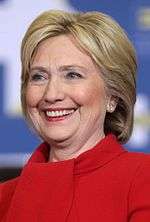


.svg.png)
.jpg)
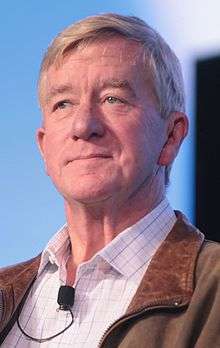
.jpg)
